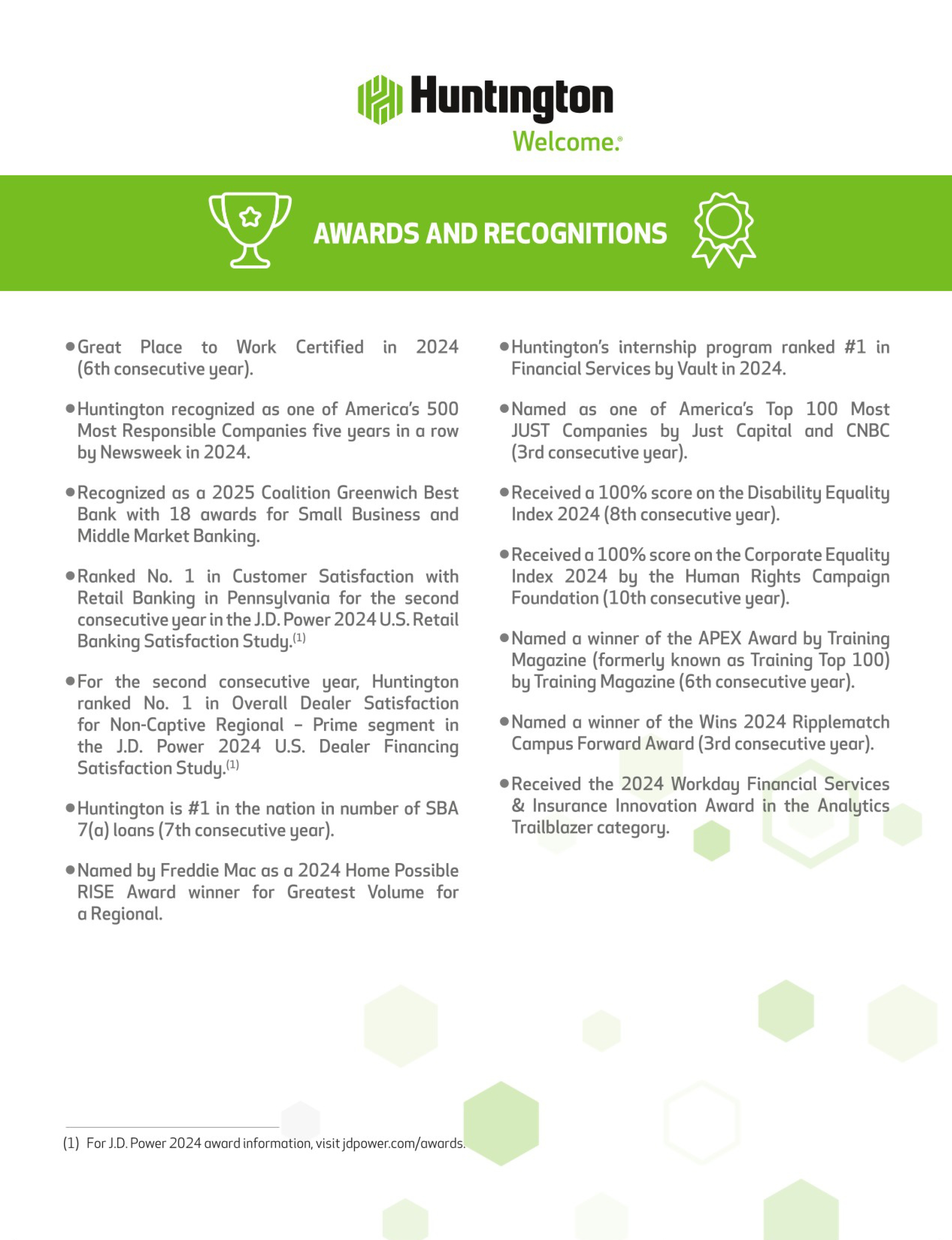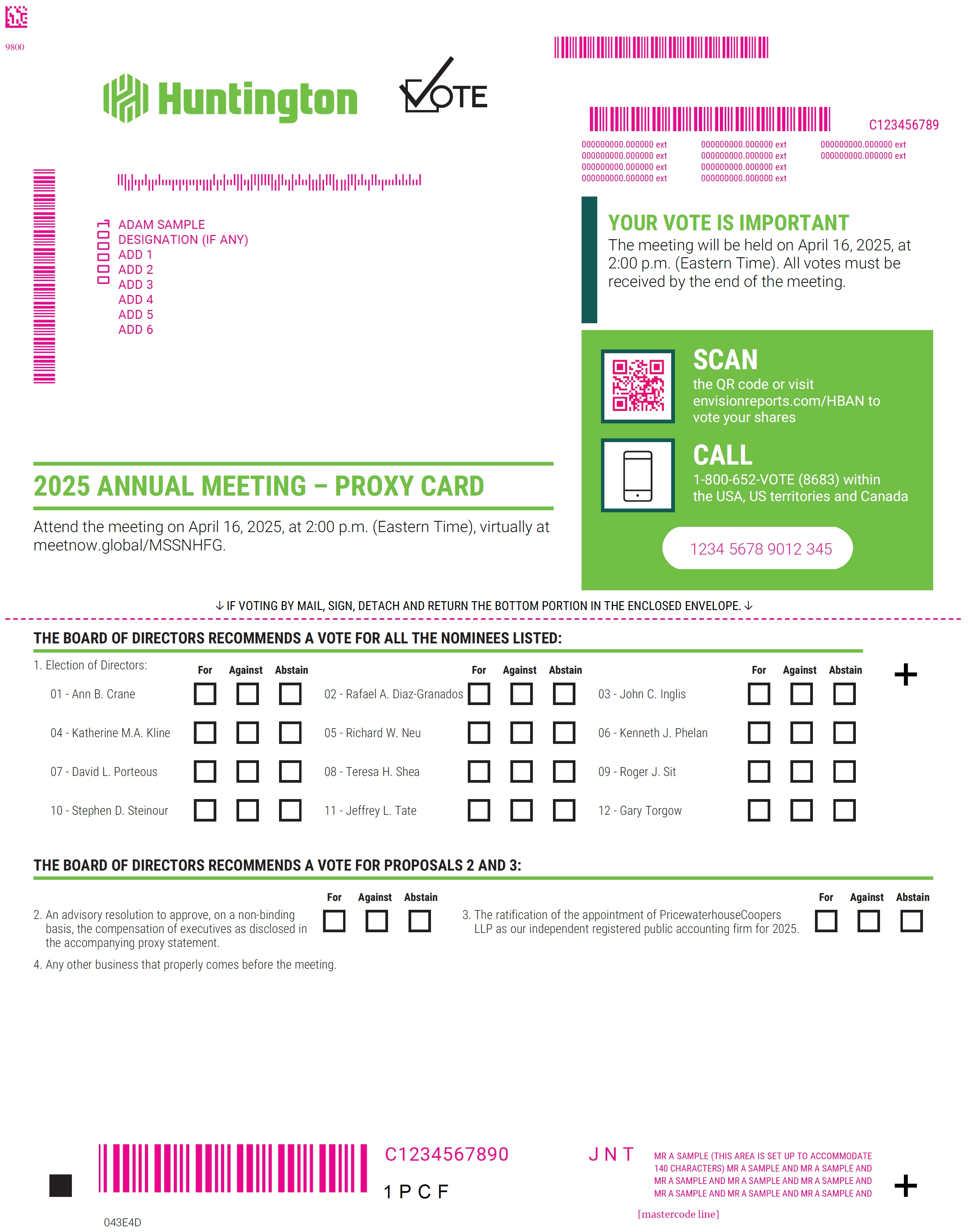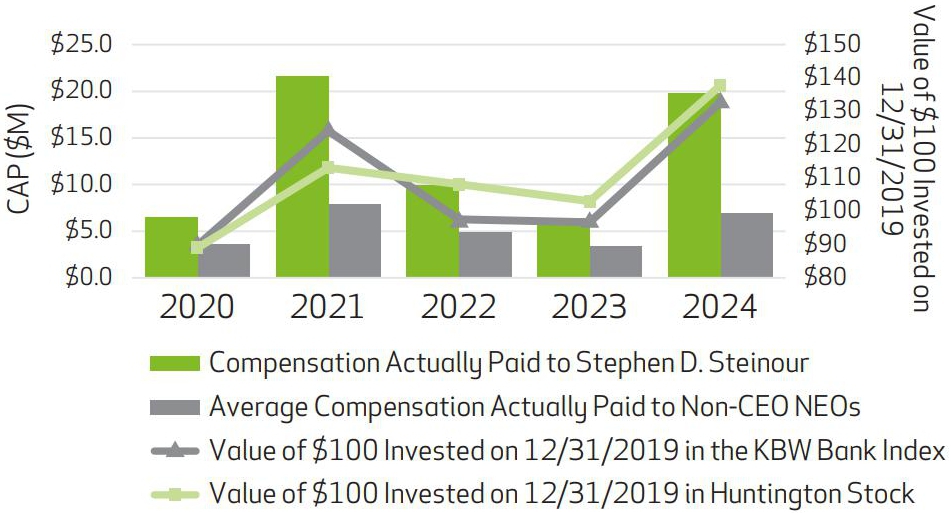DEF 14A: Definitive proxy statements
Published on March 6, 2025
UNITED STATES
SECURITIES AND EXCHANGE COMMISSION
Washington, DC 20549
PROXY STATEMENT PURSUANT TO SECTION 14(a)
OF THE SECURITIES EXCHANGE ACT OF 1934
(Amendment No. )
 |
Filed by the Registrant |  |
Filed by a Party other than the Registrant |
| Check the appropriate box: | |
 |
Preliminary Proxy Statement |
 |
Confidential, for Use of the Commission Only (as permitted by Rule 14A-6(E)(2)) |
 |
Definitive Proxy Statement |
 |
Definitive Additional Materials |
 |
Soliciting Material under §240.14a-12 |

(Name of Registrant as Specified in Its Charter)
(Name of Person(s) Filing Proxy Statement, if other than the Registrant)
| Payment of Filing Fee (Check all boxes that apply): | |
 |
No fee required. |
 |
Fee paid previously with preliminary materials. |
 |
Fee computed on table in exhibit required by Item 25(b) per Exchange Act Rules 14a-6(i)(1) and 0-11. |
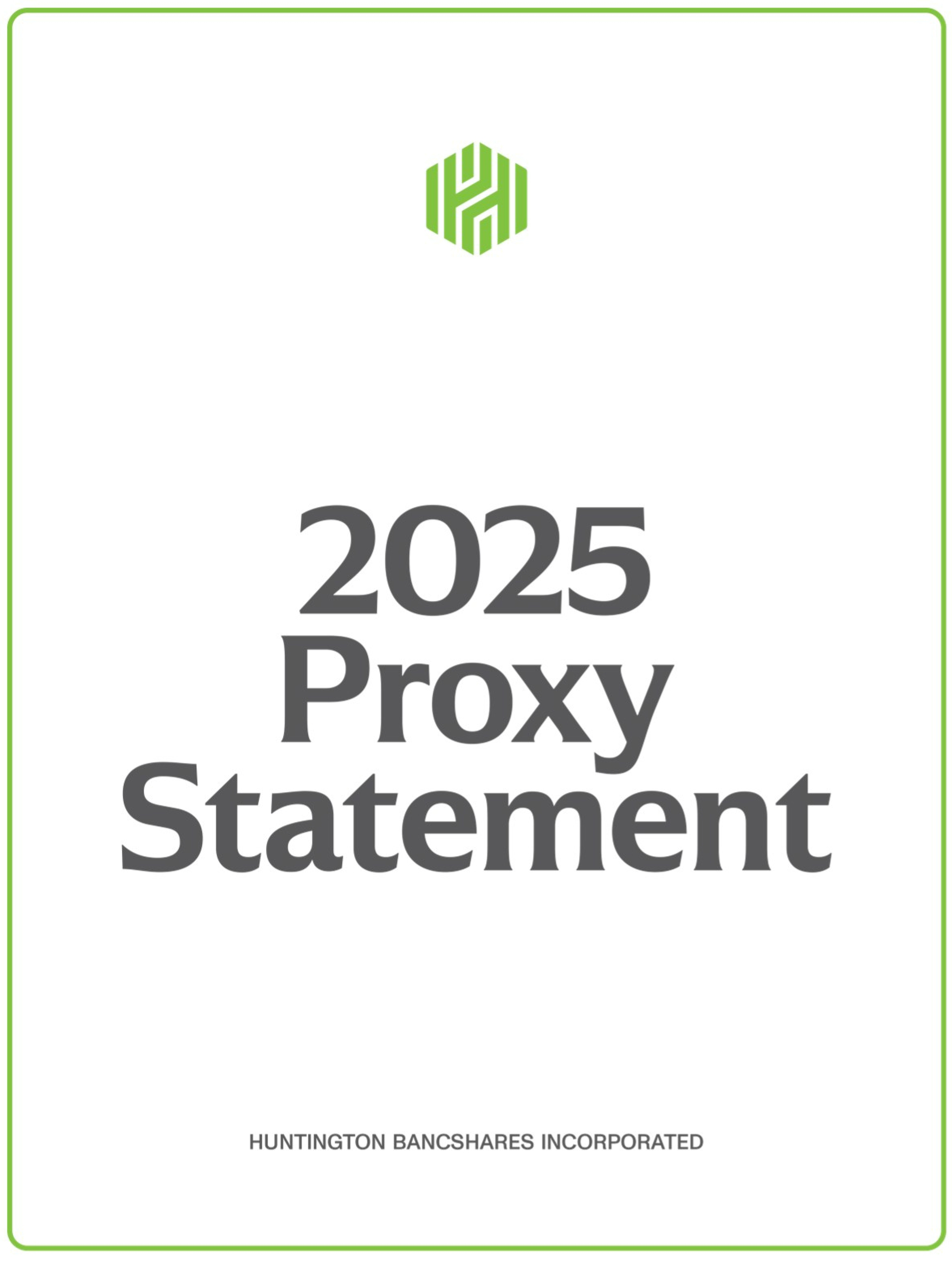


A Letter from
Our Board’s Leadership
| Stephen D. Steinour | David L. Porteous |
| Chairman, President, and CEO | Independent Lead Director |
Dear Fellow Shareholders:
We are pleased to invite you to the 2025 Annual Meeting of Shareholders to be held virtually on Wednesday, April 16, 2025, at 2:00 p.m. Eastern Time via webcast. We hope you will join us online and participate in this year’s meeting to consider the matters described in the following Notice of Annual Meeting and Proxy Statement and review highlights of the past year.
We drove accelerated growth throughout 2024, delivering sequential revenue expansion and peer-leading loan and deposit growth. This success was supported by our continued investments into our new regional markets including North Carolina, South Carolina, and Texas as well as our entry into new profitable commercial verticals. Our existing businesses are growing and performing well. We delivered year-over-year fourth quarter growth in average loans of 6% and average deposits of 7%. Full year fee revenue from our Payments, Wealth Management, and Capital Markets business increased 6%, 11%, and 32%, respectively. We also scaled our national businesses in practice finance, SBA lending, outdoor equipment and powersports, and consumer direct and indirect automotive lending. At the same time, we continued to operate from a position of strength, maintaining strong credit, liquidity, and capital ratios. We remain committed to our aggregate moderate-to-low risk appetite. We believe that we are well positioned to continue our peer leading growth in 2025 and beyond.
We updated the Huntington Vision and added Huntington’s Ambitions to double down on our customer-centered focus to be the most trusted financial institution and an indispensable partner to our customers. We plan to continue to support and grow with our customers as well as acquire new customers.
We would like to thank Alanna Cotton, Gina France, Mike Hochschwender, and Rick King for their service on the Board of Directors, each of whom provides invaluable contributions to the Board. They will be leaving our Board at the 2025 Annual Meeting of Shareholders. Alanna has brought invaluable insights to the Board of Directors especially in consumer marketing and branding. Likewise, Gina has been outstanding, and her guidance, experience, and skill focused Huntington on ensuring colleague compensation incentivized positive behaviors and culture. Mike has been extraordinary and valuable in guiding Huntington through a growing, complex spectrum of technology opportunities and cybersecurity management. Finally, Rick King’s experience assisted Huntington into becoming a digitally powered bank and introduced the concept of a “shareholder value map.” We speak on behalf of the entire Board and management in thanking them for their years of tremendous service and insights.
| Huntington Bancshares Incorporated 2025 Proxy Statement | 1 | |

Details of the business to be conducted at the Annual Meeting and how to participate at the meeting are provided in the attached Notice of Annual Meeting and Proxy Statement. Your vote is important to us. Whether or not you attend the virtual Annual Meeting, we encourage you to read the Proxy Statement carefully and vote via the internet, telephone, or mail to ensure that your shares are represented.
At Huntington, we consistently focus on strengthening our culture by caring for our colleagues, customers, and communities. We believe that we are well positioned to continue to deliver value to our shareholders. We are grateful for our colleagues for their commitment to each other, our customers, communities, and for all that they do every day. We appreciate the guidance and dedication from our Directors throughout the year. We also appreciate you, our shareholders, for your trust in our good company.
Thank you for your support of Huntington, and we look forward to your participation at the 2025 Annual Meeting of Shareholders.
Best wishes,
|
Stephen D. Steinour Chairman, President, and CEO |
David L. Porteous Independent Lead Director |
||
| March 6, 2025 |
| 2 | Huntington Bancshares Incorporated 2025 Proxy Statement | |
 |
Notice of 2025 Annual Meeting
of Shareholders
April 16, 2025
Wednesday, 2:00 p.m. Eastern Time
Location
Online at meetnow.global/MSSNHFG
| Matters to be Considered and Voted Upon: | |||
| Proposal 1 | Election of Directors |  |
FOR
|
| Proposal 2 | Advisory resolution to approve, on a non-binding basis, the compensation of executives as described in the proxy materials |  |
FOR
|
| Proposal 3 | Ratification of the appointment of PwC as our independent registered public accounting firm for 2025 |  |
FOR
|
| Other business that properly comes before the meeting | |||
Information for Shareholders Who Plan to Attend the 2025 Annual Meeting of Shareholders
Huntington’s Board is furnishing shareholders with this Proxy Statement to solicit proxies on its behalf to be exercised at the 2025 Annual Meeting of Shareholders, and any postponements or adjournments thereof, and we are first making this Proxy Statement available on or about March 6, 2025. Shareholders will be able to attend and participate in the Annual Meeting online, vote their shares electronically, and submit questions during the meeting by visiting meetnow.global/MSSNHFG at the meeting date and time.
Record Date: Huntington shareholders as of the close of business on February 18, 2025, will be entitled to vote at our annual meeting and at any postponements or adjournments of the meeting.
Your vote is important. Please submit your proxy as soon as possible via the internet, mail, or telephone. If your shares are held by a Broker, it is important that you provide instructions to your Broker so that your vote is counted on all matters.
2025 Virtual Annual Shareholder Meeting
Huntington will once again hold a virtual annual meeting in order to facilitate shareholder attendance and participation by enabling shareholders to participate from any location and at no cost. Shareholders as of the Record Date will be able to attend the meeting online, vote shares electronically, and submit questions during the meeting by visiting meetnow.global/MSSNHFG at the meeting date and time. The meeting webcast will begin promptly at 2:00 p.m. Eastern Time on Wednesday, April 16, 2025. If you experience technical difficulties during the check-in process or during the meeting, please contact (888) 724-2416 (U.S. toll-free) or +1-781-575-2748 (outside of U.S.) for assistance. See the General Information on Voting and the Annual Meeting section of the Proxy Statement for additional information on how to participate in this year’s meeting.
By Order of the Board of Directors,

Anne Kruger
Senior Associate General Counsel and Secretary
March 6, 2025
| HOW TO VOTE YOUR SHARES | |
 |
Online |
| Registered holders www.envisionreports.com/HBAN Beneficial owners Follow the instructions provided in your materials |
|

|
By Phone |
| Call the phone number at the top of your proxy card | |

|
By Mail |
| Complete, sign, date, and return your proxy card in the envelope provided | |

|
Online during the meeting |
| Attend and vote online during the virtual annual meeting | |
| Shareholders who hold their shares in street name should refer to the voting instructions provided by their Broker. | |
| Important Notice Regarding the Availability of Proxy Materials for the Shareholder Meeting to be Held on April 16, 2025. The Proxy Statement and Annual Report to shareholders are available at www.edocumentview.com/HBAN |
 |
Voluntary E-Delivery of Proxy Materials |
We encourage our shareholders to enroll in electronic delivery of proxy materials: If you are a registered shareholder, please sign up at
www.computershare.com/hban.
If you are a beneficial owner, please contact your Broker for instructions.
Electronic delivery offers immediate and convenient access to proxy materials. It also helps us reduce paper usage and our printing and shipping costs.
| Huntington Bancshares Incorporated 2025 Proxy Statement | 3 | |
 |
Table of Contents |
Readers should refer to the Glossary at the end of this Proxy Statement for definitions of capitalized terms and acronyms used throughout.
| 4 | Huntington Bancshares Incorporated 2025 Proxy Statement | |
|
|
 |
Forward-Looking Information
This Proxy Statement contains certain forward-looking statements, including, but not limited to, certain plans, expectations, goals, projections, and statements, which are not historical facts and are subject to numerous assumptions, risks, and uncertainties. Statements that do not describe historical or current facts, including statements about beliefs and expectations, are forward-looking statements. Forward-looking statements may be identified by words such as expect, anticipate, believe, intend, estimate, plan, target, goal, or similar expressions, or future or conditional verbs such as will, may, might, should, would, could, or similar variations. The forward-looking statements are intended to be subject to the safe harbor provided by Section 27A of the Securities Act of 1933, Section 21E of the Securities Exchange Act of 1934, and the Private Securities Litigation Reform Act of 1995.
While there is no assurance that any list of risks and uncertainties or risk factors is complete, below are certain factors which could cause actual results to differ materially from those contained or implied in the forward-looking statements: changes in general economic, political, or industry conditions; deterioration in business and economic conditions, including persistent inflation, supply chain issues or labor shortages, instability in global economic conditions and geopolitical matters, as well as volatility in financial markets; changes in U.S. trade policies, including the imposition of tariffs and retaliatory tariffs; the impact of pandemics and other catastrophic events or disasters on the global economy and financial market conditions and our business, results of operations, and financial condition; the impacts related to or resulting from bank failures and other volatility, including potential increased regulatory requirements and costs, such as FDIC special assessments, long-term debt requirements and heightened capital requirements, and potential impacts to macroeconomic conditions, which could affect the ability of depository institutions, including us, to attract and retain depositors and to borrow or raise capital; unexpected outflows of uninsured deposits which may require us to sell investment securities at a loss; changing interest rates which could negatively impact the value of our portfolio of investment securities; the loss of value of our investment portfolio which could negatively impact market perceptions of us and could lead to deposit withdrawals; the effects of social media on market perceptions of us and banks generally; cybersecurity risks; uncertainty in U.S. fiscal and monetary policy, including the interest rate policies of the Federal Reserve; volatility and disruptions in global capital and credit markets; movements in interest rates; competitive pressures on product pricing and services; success, impact, and timing of our business strategies, including market acceptance of any new products or services including those implementing our “Fair Play” banking philosophy; changes in policies and standards for regulatory review of bank mergers; the nature, extent, timing, and results of governmental actions, examinations, reviews, reforms, regulations, and interpretations, including those related to the Dodd-Frank Wall Street Reform and Consumer Protection Act and the Basel III regulatory capital reforms, as well as those involving the OCC, Federal Reserve, FDIC, and CFPB; and other factors that may affect the future results of Huntington.
All forward-looking statements speak only as of the date they are made and are based on information available at that time. Huntington does not assume any obligation to update forward-looking statements to reflect circumstances or events that occur after the date the forward-looking statements were made or to reflect the occurrence of unanticipated events except as required by federal securities laws. As forward-looking statements involve significant risks and uncertainties, caution should be exercised against placing undue reliance on such statements.
See also the other reports filed with the SEC, including discussions under the “Forward-Looking Statements” and “Risk Factors” sections of Huntington’s Annual Report on Form 10-K for the year ended December 31, 2024, as filed with the SEC and available on its website at www.sec.gov.
The Corporate Responsibility-based objectives, plans, targets, goals, and commitments contained within this Proxy Statement are aspirational and considered forward-looking statements; as such, we make no guarantees or promises that they will be achieved or successfully executed. Statistics and metrics included in these disclosures are estimates and may be based on assumptions.
Information Not Incorporated into This Proxy Statement
Information contained on or accessible through our website at www.huntington.com or ir.huntington.com, including but not limited to, our various Corporate Responsibility reports, is not and shall not be deemed to be a part of this Proxy Statement by reference or otherwise incorporated into any other filings we make with the SEC, except to the extent we specifically incorporate such information by reference. Some of these statements and reports contain cautionary statements regarding forward-looking information that should be carefully considered. Our statements and reports about our objectives may include statistics or metrics that are estimates, make assumptions based on developing standards that may change, and provide aspirational goals that are not intended to be promises or guarantees. The statements and reports may also change at any time, and we undertake no obligation to update them, except as required by law.
| Huntington Bancshares Incorporated 2025 Proxy Statement | 5 | |
 |
Proxy Summary
Your Vote is Important to Us
Regardless of whether you are planning to attend this year’s annual meeting, please submit your vote over the internet; by phone; or complete, sign, and return your proxy card as soon as you can so that we can be assured of obtaining a quorum.
| Proposal 1: Election of Directors | The Board proposes the election of 12 individuals as Directors at this annual meeting. All our nominees are seasoned leaders. Collectively, they bring an effective variety of skills, knowledge, experience, and perspectives to our Board. The independent Director nominees make up 83.3% of the Board. |  |
Our Board recommends a vote FOR the election of each of the nominees for Director. See page 17 for further information. | ||
| Proposal 2: Advisory resolution to approve, on a non-binding basis, the compensation of executives as described in the proxy materials | The Board and the HRCC believe that our compensation policies and procedures strongly align the interests of executives and shareholders and that our culture focuses executives on sound risk management and appropriately rewards executives for performance. |  |
Our Board recommends a vote FOR this proposal. See page 64 for further information. | ||
| Proposal 3: Ratification of the appointment of the independent registered public accounting firm for 2025 | The Board and the Audit Committee believe that the continued retention of PwC to serve as our independent registered public accounting firm is in the best interests of the Company and its investors. The Audit Committee will reconsider the appointment of PwC if its selection is not ratified by the shareholders. |  |
Our Board recommends a vote FOR this proposal. See page 108 for further information. |
 |
 |
 |
 |
|||
| TIME & DATE | PLACE | RECORD DATE | VOTING | |||
| 2:00
p.m. Eastern Time Wednesday, April 16, 2025 |
Online at meetnow.global/MSSNHFG | Close
of business on February 18, 2025 |
Common shareholders as of the Record Date are entitled to vote. Shareholders of record and most beneficial shareholders have several methods by which they can vote. Please refer to the Notice of 2025 Annual Meeting of Shareholders for voting methods. |
| 6 | Huntington Bancshares Incorporated 2025 Proxy Statement | |
|
Proxy Summary 2024 Performance Highlights |
 |
2024 Performance Highlights
The past year saw the successful execution of strategic initiatives and sustained deposit and loan growth for Huntington during a dynamic environment for the banking sector. Over the past year, we continued to invest in our colleagues, communities, and customers. These investments are described throughout this Proxy Statement. The following provides a high-level overview of our 2024 performance:
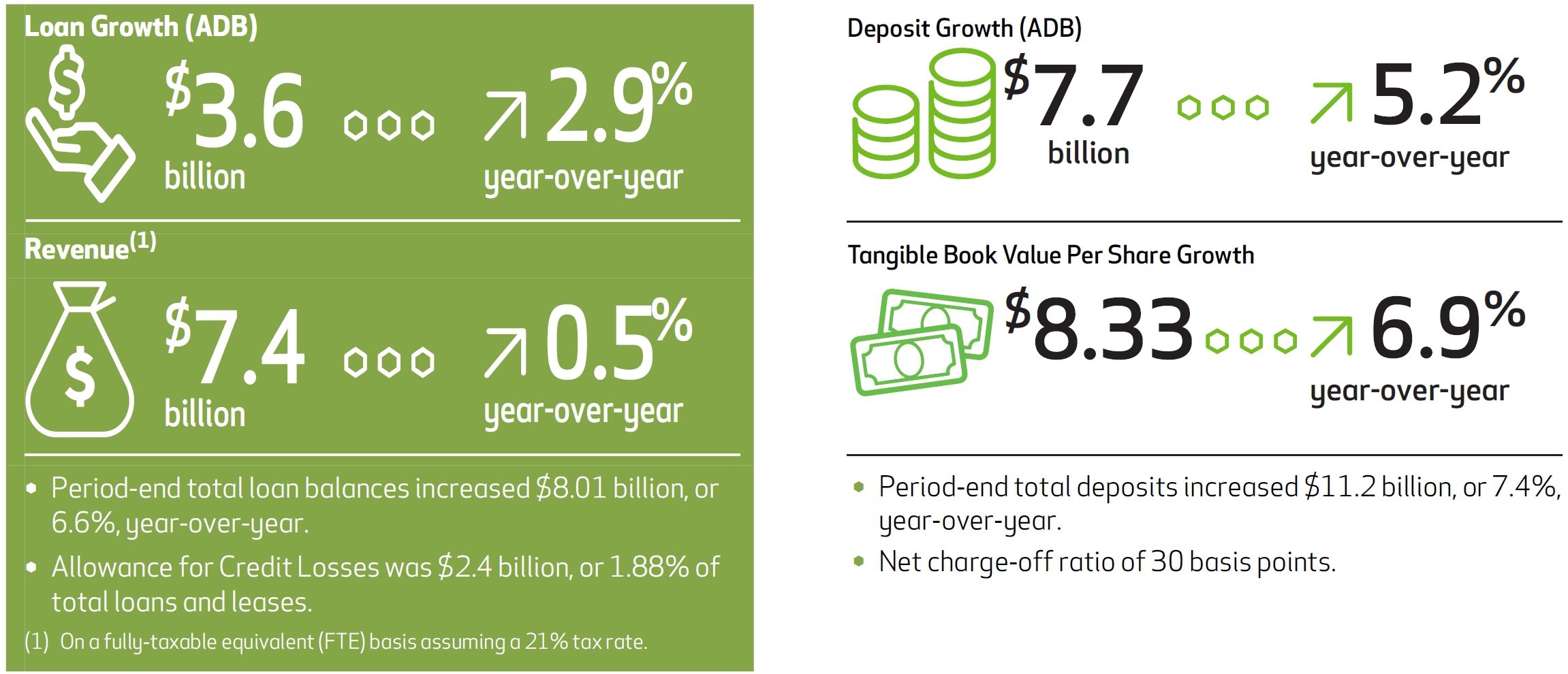
Huntington Overview
We serve our customers through a banking network of retail branches as well as digital, telephone, and ATM banking capabilities.
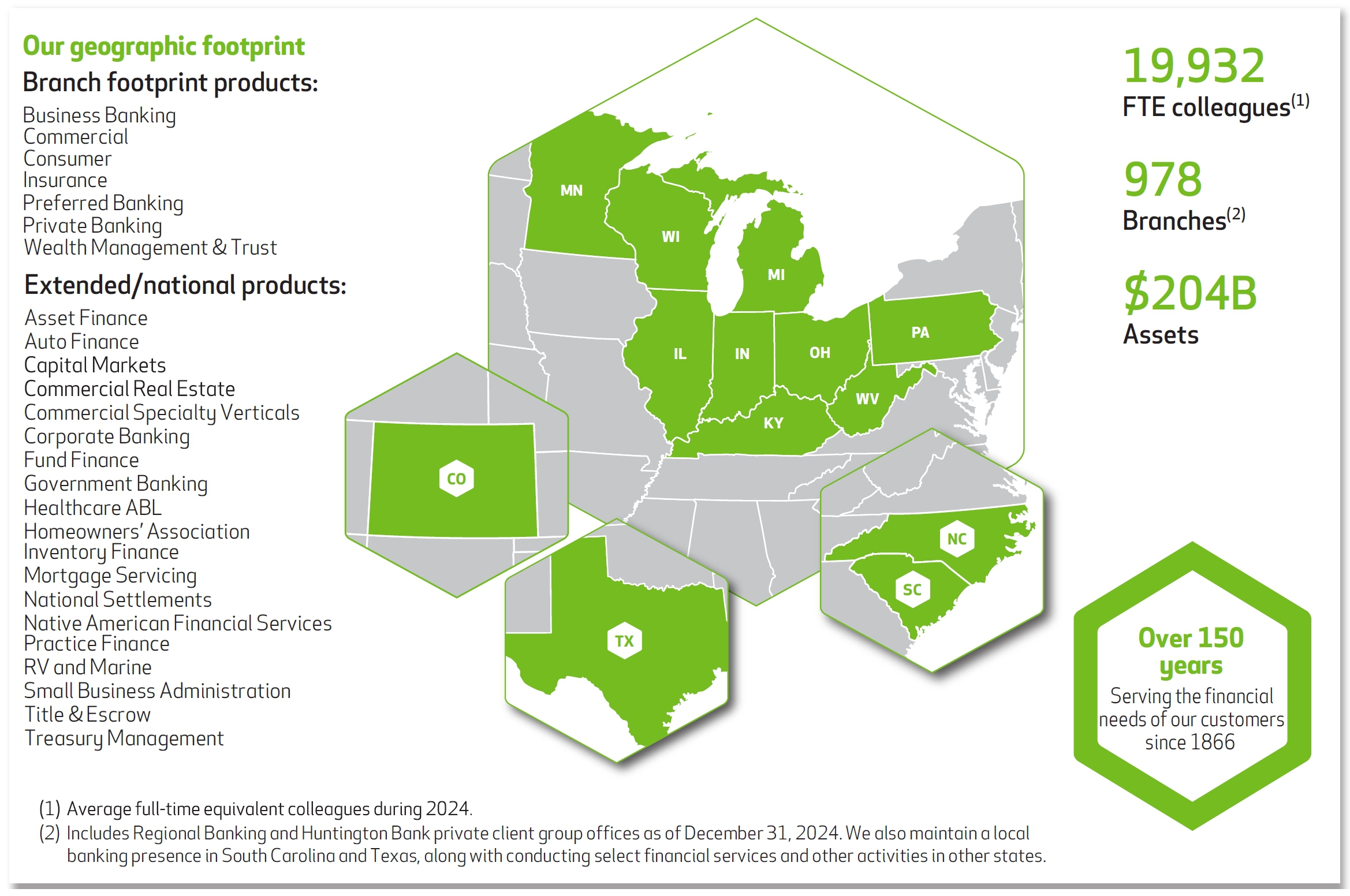
| Huntington Bancshares Incorporated 2025 Proxy Statement | 7 | |
 |
Proxy Summary Information Highlights |
Information Highlights
The following chart provides highlights of many of Huntington’s Corporate Responsibility and compensation practices. Shareholders should note, however, that this chart does not contain all the information provided elsewhere in this Proxy Statement; therefore, you should carefully read the entire Proxy Statement before casting your vote.
| Corporate Responsibility or Compensation Topic | Huntington’s Practice |
 |
Board Composition, Leadership, and Operations |
| Number of Director nominees | 12 | |
| Substantially independent Director nominees | Yes, 83.3% of nominees are independent | |
| Independence of Audit Committee, HRCC, NESG Committee, Risk Oversight Committee members, and Technology Committee | 100% | |
| Combined Chairman/CEO | Yes | |
| Independent Lead Director with clearly defined authority and duties | Yes | |
| Average Director nominee age | 64 years as of April 16, 2025 | |
| Mandatory retirement age | 75 years unless an exception is made | |
| Average Director nominee tenure | 8 years as of April 16, 2025 | |
| Term limit | None | |
| Gender diversity on the Board | 3 nominees (25%) | |
| Racial/ethnic diversity on the Board | 3 nominees (25%) | |
| Overboarded Directors | No nominee serves on more than two other public company boards | |
| Board evaluations | Annual rigorous process, including a Board-level evaluation, committee-level evaluations, and one-on-one discussions between the independent Lead Director and each other Director; periodic use of a third party | |
| Director onboarding and ongoing education | Yes | |
| Director election voting standard | Majority of the votes cast for and against each nominee, with plurality carveout for contested elections | |
| Director election frequency | Annual | |
| Blank check preferred | Yes, but Huntington’s capital plan is submitted to the Federal Reserve | |
| Number of Board meetings held in 2024 | 14 | |
| Number of Board and committee meetings held in 2024 | 67 | |
| Average Board and committee meeting attendance in 2024 | 97.9% | |
| Executive sessions with only independent Directors | Yes, scheduled for all regular quarterly Board meetings | |
| Direct access to management and other colleagues | Yes, the Board has direct access | |
| Risk mitigation practices | Established an aggregate moderate-to-low risk appetite for the enterprise with key risks overseen by Board committees |
| 8 | Huntington Bancshares Incorporated 2025 Proxy Statement | |
|
Proxy Summary Information Highlights |
 |
| Corporate Responsibility or Compensation Topic | Huntington’s Practice |
 |
Shareholder Rights |
| Right to call special meetings | Yes, by a majority of outstanding shares | |
| Right to act by written consent | Must be unanimous | |
| One share, one vote policy | Yes | |
| Dual-class common stock | None | |
| Cumulative voting permitted | No | |
| Supermajority voting requirements | 66.67% for charter or bylaw amendments | |
| Poison pill | No | |
| Proxy access bylaw | No | |
| Exclusive forum bylaw | Yes, exclusive federal forum for Securities Act of 1933 claims | |
| Fee shifting bylaw | No (prohibited by state law) |
 |
Other Governance Highlights |
| Shareholder engagement | Ongoing throughout the year | |
| Council of Institutional Investors member | Yes | |
| Independent auditor | PwC (since 2015) |
 |
Corporate Responsibility Practices |
| Board oversight of Corporate Responsibility | Yes | |
| Stakeholder assessment conducted | Yes | |
| Human Rights Statement | Yes | |
| Service Provider Code of Conduct | Yes | |
| SASB Index disclosed | Yes, included within our Corporate Responsibility Report | |
| PCAF member | Yes | |
| EEO-1 data disclosure | Yes, available on our website | |
| Pay Equity Comparison | Yes, included within our Corporate Responsibility Report |
| Huntington Bancshares Incorporated 2025 Proxy Statement | 9 | |
 |
Proxy Summary Information Highlights |
| Corporate Responsibility or Compensation Topic | Huntington’s Practice |
 |
Compensation and Human Resource Matters |
| Succession planning for CEO and other executives | Yes, at least annually | |
| CEO pay ratio | 136:1 | |
| Stock ownership guidelines | 10X salary for CEO and 3X for each NEO | |
| Dividend or dividend equivalents paid on equity grants prior to vesting | No | |
| Prohibition on Director and executive officer hedging and pledging of Huntington stock | Yes | |
| Performance-based compensation | Yes, a majority of aggregate NEO LTI is based upon long-term performance; PSUs make up 55% of total annual LTI grant value for CEO and 50% for other NEOs.(1) | |
| Compensation tied to culture | Yes, with performance reviews based 50% on what (goals) and 50% on how (behaviors supporting our Values) executives deliver | |
| Recoupment policy | Yes | |
| Compensation metrics | Balanced portfolio of metrics that drive annual and long-term goals in a risk appropriate manner | |
| Current frequency of say-on-pay vote | Annual | |
| Double-trigger change-in-control provisions | Yes | |
| Excise tax gross-ups | No | |
| Repricing of previously-granted stock options without shareholder approval | No | |
| Annual assessment of compensation programs | Yes, against both peers and market best practices | |
| Incentive plans encourage excessive risk taking | No | |
| Independent compensation consultant | Pearl Meyer |
 |
Corporate Information |
| Common stock symbol | HBAN | |
| Stock exchange | Nasdaq | |
| Common stock outstanding as of the Record Date | 1,460,753,955 shares | |
| State of incorporation | Maryland | |
| Year founded | 1866 | |
| Corporate headquarters | Columbus, Ohio | |
| Registrar and transfer agent | Computershare | |
| Corporate website | huntington.com | |
| Investor Relations website | ir.huntington.com |
(1) Beginning in 2025, PSUs comprise 60% of total annual LTI grant value for CEO and 55% for the other NEOs.
| 10 | Huntington Bancshares Incorporated 2025 Proxy Statement | |
|
Proxy Summary Proposal Summaries |
 |
Proposal Summaries
| Proposal 1 Election of Directors | |||
|
The Board proposes the election of 12 Director nominees at this annual meeting. All our nominees are seasoned leaders and bring to our Board an effective variety of skills, knowledge, experience, and perspectives. ► See page 17 for further information. |
 |
Our Board recommends a vote FOR the election of each of the nominees for Director. |
Director Nominee Key Facts
This year’s slate of nominees is comprised of a variety and balanced combination of backgrounds, experience, tenure, and other diversity attributes. We believe that Huntington’s Directors, both individually and as a group, possess the mixture of skills needed to oversee the Company and its operations both now and in the future.
Director Nominee Demographic Characteristics
The Director nominees self-identified their demographic characteristics, which are represented in the following graphic.
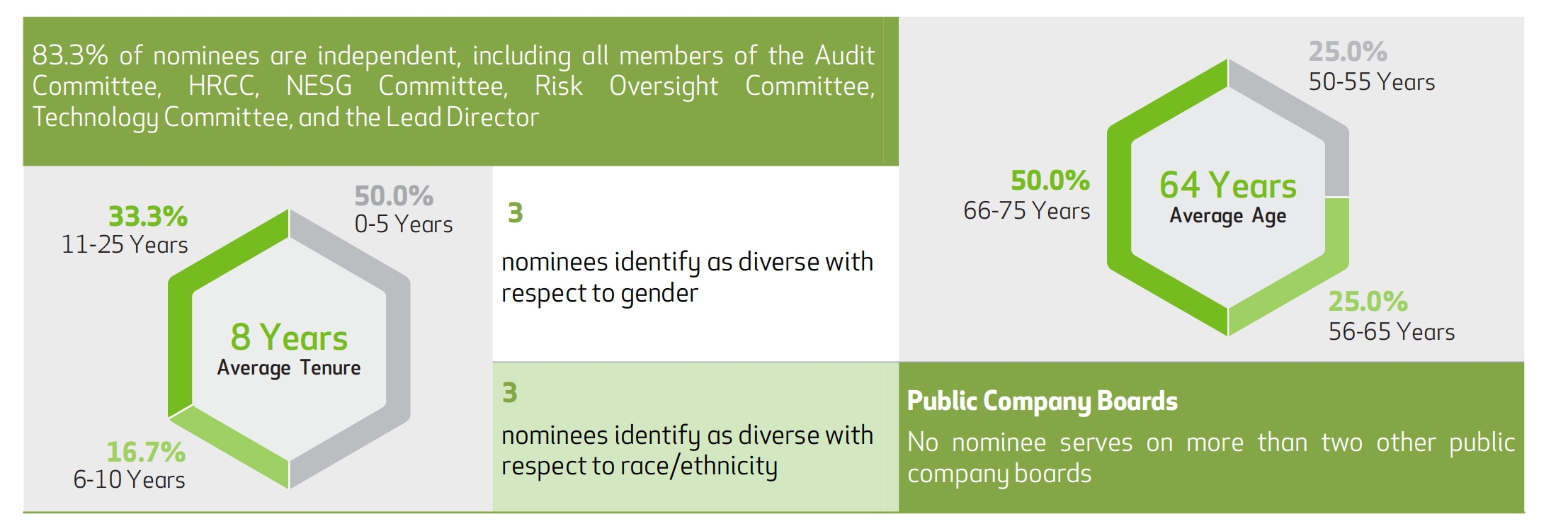
Note that some percentages may not equal 100% due to rounding.
| Huntington Bancshares Incorporated 2025 Proxy Statement | 11 | |
 |
Proxy Summary Proposal Summaries |
In addition to demographic characteristics, Director nominees self-identified their skills, experiences, and expertise gained through their varied backgrounds and industries. The overall skills and experiences represented on the Board, as identified by the Director nominees, are demonstrated through the following charts.
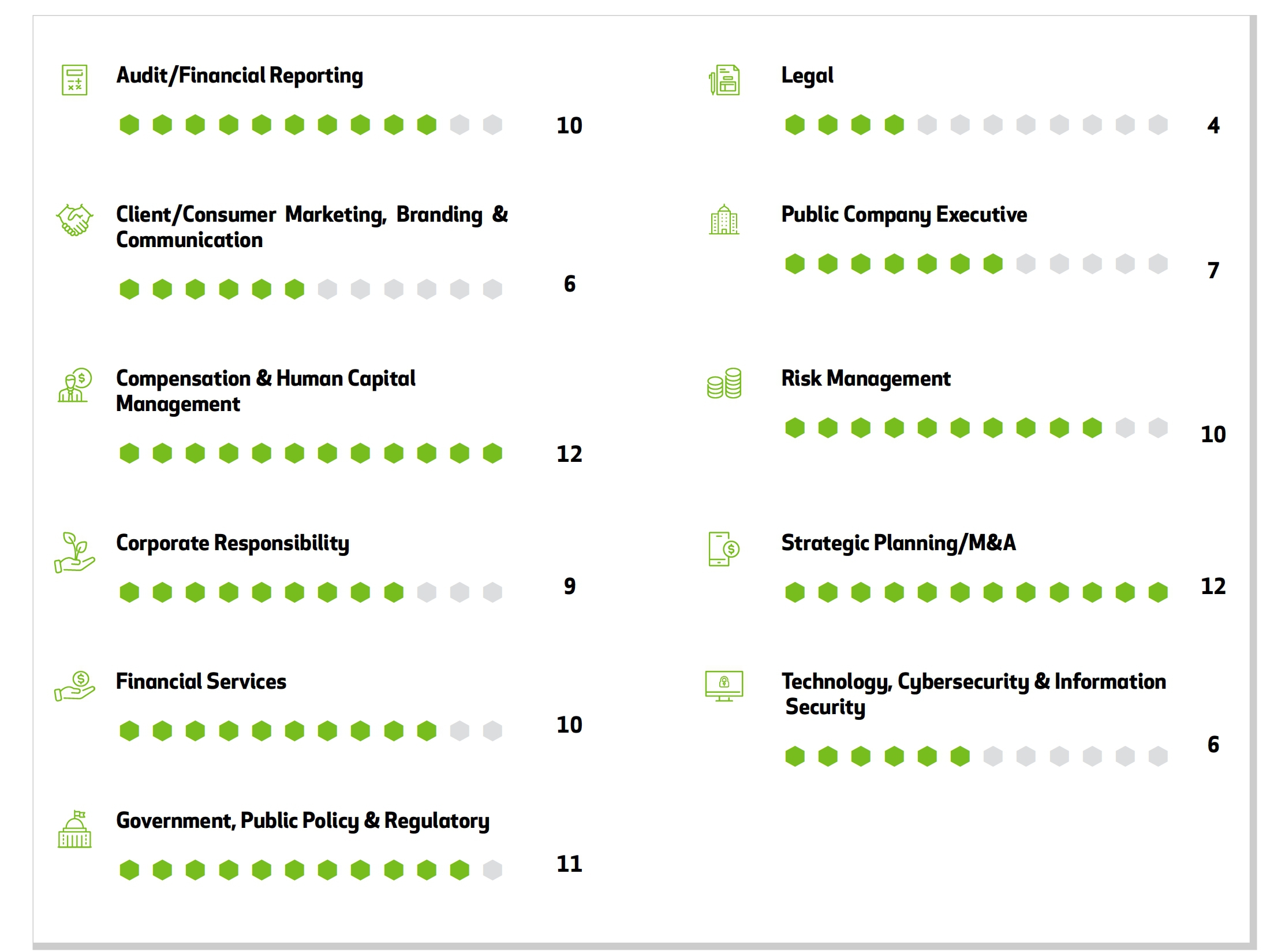
More detailed information about each nominee and the Board can be found within the Proposal 1 — Election of Directors section of this year’s Proxy Statement.
| 12 | Huntington Bancshares Incorporated 2025 Proxy Statement | |
|
Proxy Summary Proposal Summaries |
 |
Board Nominees
A brief description of the nominees for the 2025 Annual Meeting is set forth below with ages as of April 16, 2025:
| Directors and Nominees | Age | Director Since |
Huntington Board Committees | Other Current Public Company Directorships |
||||||
 |
Ann B. (Tanny) Crane President and CEO, |
68 | 2010 |
Audit Committee (Audit Committee
Financial Expert)
Community Development Committee
(Chair)
Executive Committee
|
||||||
 |
Rafael Andres Diaz-Granados Chairman and CEO, |
52 | 2023 |
Community Development Committee
Risk Oversight Committee
|
||||||
 |
John C. (Chris) Inglis Former U.S. National Cyber Director |
70 | 2023 |
NESG Committee
Technology Committee
|
American International Group, Inc.
|
|||||
 |
Katherine M.A. (Allie) Kline Founding Principal, LEO DIX |
53 | 2019 |
NESG Committee
Technology Committee
|
BILL Holdings, Inc.
(formerly Bill.com Holdings, Inc.)
|
|||||
 |
Richard W. Neu Retired Chairman, MCG Capital Corporation |
69 | 2010 |
Audit Committee (Chair) (Audit Committee Financial
Expert)
Executive Committee
NESG Committee
|
Tempur Sealy International, Inc.
|
|||||
 |
Kenneth J. Phelan Senior Advisor, Oliver Wyman, Inc. |
65 | 2019 |
HRCC
Executive Committee
Risk Oversight Committee (Chair)
|
Adtalem Global Education Inc.
|
|||||
 |
David L. Porteous Attorney, McCurdy, Wotila & Porteous, |
72 | 2003 |
Executive Committee (Chair)
NESG Committee (Chair)
Risk Oversight Committee
|
||||||
 |
Teresa H. Shea President, Oplnet, LLC |
65 | 2024 |
Technology Committee
|
||||||
 |
Roger J. Sit CEO, Global Chief Investment Officer, |
63 | 2021 |
HRCC
Risk Oversight Committee
|
||||||
 |
Stephen D. Steinour Chairman, President, and CEO, |
66 | 2009 |
Executive Committee
|
Bath & Body Works, Inc.
|
|||||
 |
Jeffrey L. Tate CFO, Dow Inc. |
55 | 2021 |
Audit Committee (Audit Committee Financial Expert)
|
||||||
 |
Gary Torgow Chairman, Huntington Bank |
68 | 2021 |
Community Development Committee
|
DTE Energy Company
|
| Huntington Bancshares Incorporated 2025 Proxy Statement | 13 | |
 |
Proxy Summary Proposal Summaries |
Corporate Governance
Huntington’s Board and executive management endeavor to keep pace with and exceed the constantly evolving corporate governance standards. As such, we have adopted many robust corporate governance practices that govern the Company and Board.
 See page 38 for further
information.
See page 38 for further
information.

More detailed information about Huntington’s corporate governance framework and practices can be found in the Corporate Governance section of this year’s Proxy Statement. Within this section, shareholders can find information on matters such as our shareholder engagement efforts, Director independence, and Board leadership.
As part of the Corporate Governance section of the Proxy Statement, we also provide a high-level overview of our various Corporate Responsibility practices, which includes our human capital, community development and philanthropy, environmental, and governance practices. The responsible way in which we operate our Company helps us live our Purpose and deliver long-term value for all those we serve. We focus on the issues most impactful to our business and important to our stakeholders.

Shareholders are encouraged to review Huntington’s annual Corporate Responsibility Reports that further describe Corporate Responsibility matters at the Company and Huntington’s Climate Report for additional information on climate risks that can be found at ir.huntington.com.
| Proposal 2 Compensation of Executive Officers | |||
| The Board and the HRCC believe that our compensation policies and practices strongly align the interests of executives and shareholders. Further, our culture focuses executives on sound risk management and appropriately rewards executives for their comprehensive performance including what they achieve and how they achieve it. |
 |
Our Board recommends a vote FOR this proposal. | |
 See page 64
for further information. See page 64
for further information.
|
The following highlights Huntington’s executive compensation practices, which are designed to incentivize not only success, but succeeding the right way. Plans are intended to encourage prudent risk taking while balancing both short- and longer-term wins. Shareholders should look to the Proposal 2 — Compensation of Executive Officers section of this Proxy Statement, including the CD&A, for detailed information on our pay-for-performance executive compensation structure.
| 14 | Huntington Bancshares Incorporated 2025 Proxy Statement | |
|
Proxy Summary Proposal Summaries |
 |
2024 Compensation Program
| Target Compensation Mix | ||||
 |
CEO | Other NEOs(1) | Description | |
| Base Salaries | ||||
 |
 |
Fixed component representing 12% of aggregate total target compensation for our CEO and 22% for our other NEOs | ||
| Annual Incentive Plan (MIP) | ||||
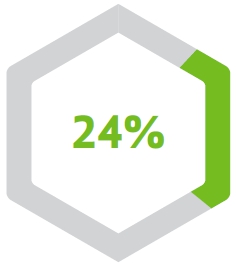 |
 |
Annual performance-based compensation based on:
|
||
| Long-Term Incentive Plan (LTIP) | ||||
 |
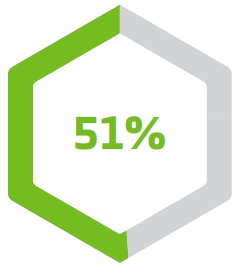 |
Awards of long-term incentive (LTI) grants comprised of:
|
||
| (1) | Represents an average of annualized base salaries. |
| (2) | Non-GAAP, see Appendix A to this proxy statement for more information. |
| (3) | Beginning in 2025, PSUs comprise 60% of total annual LTI grant value for CEO and 55% for the other NEOs. |
| Huntington Bancshares Incorporated 2025 Proxy Statement | 15 | |
 |
Proxy Summary Proposal Summaries |
Executive Compensation Best Practices
| What We Do | What We Don’t Do | |||
 |
Significant stock ownership policy applicable to executive officers and next level executives receiving equity awards to reinforce alignment between shareholders and senior management |  |
No repricing of previously-granted stock options without shareholder approval | |
 |
Significant emphasis on performance-based compensation, with the majority dependent upon long-term performance |  |
No perquisite or excise tax gross-ups upon change in control | |
 |
Balanced portfolio of metrics that drive annual and long-term goals in a risk appropriate manner |  |
No single-trigger vesting of equity awards upon change in control | |
 |
All incentive compensation, including vested and paid compensation, is subject to robust recoupment policies that allow us to recover certain vested or unvested incentive compensation in the event of inappropriate risk taking or a financial restatement |  |
No hedging or pledging of Huntington securities by executives or Directors | |
 |
PSUs comprise 55% of total annual LTI grant value for CEO and 50% for other NEOs for 2024(1) |  |
No dividend or dividend equivalents paid on equity grants prior to vesting | |
 |
Annual equity-based awards made on a pre-established date to avoid any appearance of coordination with the release of material non-public information |  |
No incentive plans encourage excessive risk-taking | |
 |
Independent compensation consultant provides expert guidance and support to the HRCC | |||
 |
Shareholder engagement to exchange viewpoints with our investors | |||
 |
Annual assessment of compensation programs to compare them to those of our peers and market best practices | |||
 |
Limited perquisites representing a small component of compensation | |||
 |
Annual risk assessment of incentive compensation plans | |||
| (1) | Beginning in 2025, PSUs comprise 60% of total annual LTI grant value for CEO and 55% for the other NEOs. |
|
Proposal
3
Ratification of the Appointment of the Independent Registered Public Accounting Firm for 2025
|
|||
| The Board and the Audit Committee believe that the continued retention of PwC to serve as our independent registered public accounting firm is in the best interests of the Company and its investors. The Audit Committee will reconsider the appointment of PwC if its selection is not ratified by the shareholders. |
 |
Our Board recommends a vote FOR this proposal. | |
 See page 108
for further information. See page 108
for further information.
|
Shareholders are being requested to ratify PwC as the Company’s independent auditors for 2025. Information about PwC, our engagement arrangement, and the fees paid can be found under Proposal 3 — Ratification of the Appointment of the Independent Registered Public Accounting Firm for 2025.
| 16 | Huntington Bancshares Incorporated 2025 Proxy Statement | |
| |
 |
Election of Directors
| Proposal 1 Election of Directors | |||
|
The Board proposes the election of 12 individuals as Directors at this annual meeting. Directors elected at the meeting will each serve a one-year term until the 2026 Annual Meeting and until their successors are duly elected and qualify or their earlier resignation or removal. We have no reason to believe that any nominee will be unable or unwilling to serve as a Director, if elected. If, however, any of these nominees should become unavailable, the Board may decrease the number of Directors pursuant to our Bylaws or may designate a substitute nominee, for whom shares represented by a properly submitted proxy would be voted. |
 |
The Board recommends a vote FOR the election of each of the nominees for Director. |
Shareholders are being requested to vote on a proposal to elect the 12 nominees listed below to serve as Directors of Huntington. The Board recommends that you vote FOR each nominee because they bring to our Board an effective variety of skills, knowledge, experience, and perspectives. Each nominee is a proven leader within their respective fields and industries.
After consideration of the current composition of the Board, the results of the annual Board evaluation, and the Company’s strategic objectives and goals, the Board, upon consultation with the NESG Committee, has nominated the following individuals, each of whom is currently serving, for election at the 2025 Annual Meeting of Shareholders:
| Ann B. (Tanny) Crane | Richard W. Neu | Roger J. Sit |
| Rafael Andres Diaz-Granados | Kenneth J. Phelan | Stephen D. Steinour |
| John C. (Chris) Inglis | David L. Porteous | Jeffrey L. Tate |
| Katherine M.A. (Allie) Kline | Teresa H. Shea | Gary Torgow |
Pursuant to Huntington’s Bylaws, all Directors shall serve a one-year term until the 2026 Annual Meeting and until their successors are duly elected and qualify or their earlier resignation or removal.
Four of our Directors will be leaving the Board at the 2025 Annual Meeting of Shareholders: Alanna Cotton, Gina France, J. Michael Hochschwender, and Richard King. Each of these Directors has brought substantial expertise and leadership to the Board of Directors and the committees on which each has served as a member or as chair. Accordingly, the Board has set the number of Directors to constitute the Board effective at the 2025 Annual Meeting of Shareholders at 12 Directors.
The General Information on Voting and the Annual Meeting section of the Proxy Statement contains information on how to nominate and recommend individuals for directorship.
| Huntington Bancshares Incorporated 2025 Proxy Statement | 17 | |
 |
Election of Directors |
Demographic Characteristics of the Nominees
The Board understands the importance of and is committed to maintaining a diverse group of Directors who can bring their unique and individual skills, experiences, talents, and points of view to the boardroom.
Our nominees for directorship represent well-rounded skills, knowledge, experience, perspectives, and characteristics. All our nominees are seasoned leaders. We also have a mix of newer and longer-term Directors among the nominees. As of the 2025 Annual Meeting, the average tenure of our Director nominees will be approximately 8 years, and the nominees will range in age from 52 to 72 years.
| Gender & Racial/Ethnic Diversity | Average Tenure |
 |
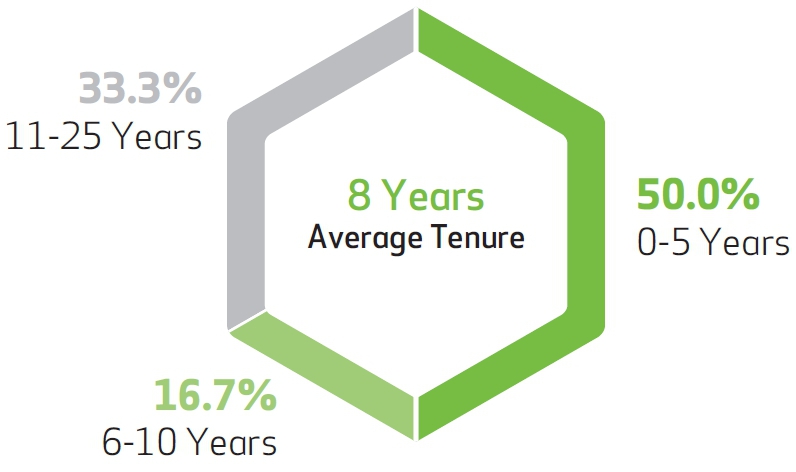 |
| Average Age | Independence |
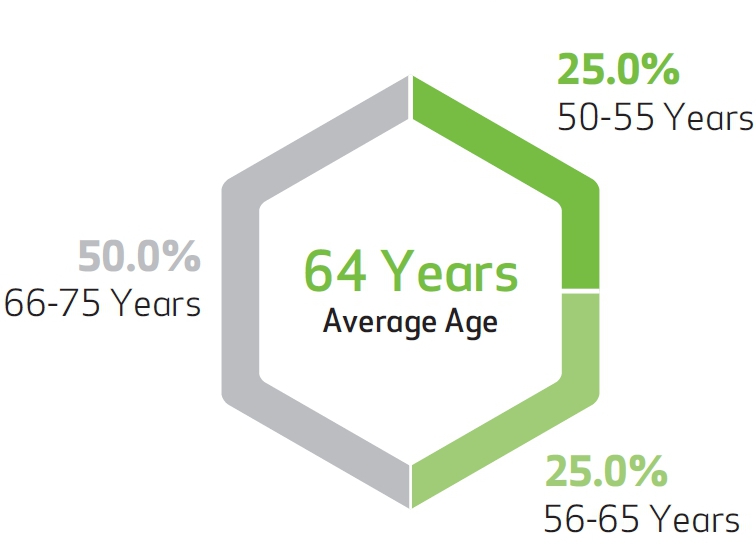 |
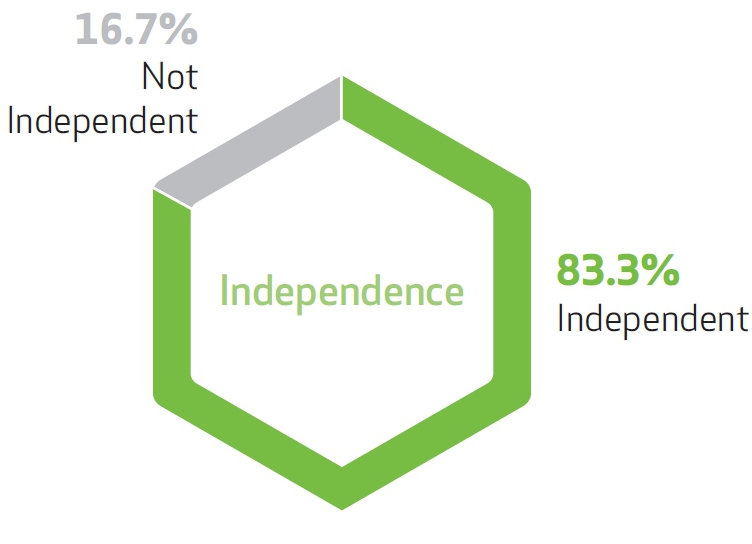 |
Note that some percentages may not equal 100% due to rounding.
The Board does not have a formal policy regarding diversity. The Board believes that its membership should include a range of skills, experiences, talents, and points of view. By maintaining diversity within the boardroom, the Board is setting the tone at the top.
The Corporate Governance Guidelines state that the NESG Committee will include highly qualified candidates who reflect a range of backgrounds in the pool from which nominees are chosen. The Board measures the success and efficacy of these practices by reviewing the composition of the Board on an ongoing basis.
| 18 | Huntington Bancshares Incorporated 2025 Proxy Statement | |
| Election of Directors |  |
| Individual Director Nominee Characteristics | ||||||||||||
| Crane |
Diaz- Granados |
Inglis** | Kline | Neu | Phelan | Porteous | Shea | Sit | Steinour | Tate | Torgow | |
| Skills & Experience | ||||||||||||
| Audit/Financial Reporting |  |
 |
 |
 |
 |
 |
 |
 |
 |
 |
||
| Client/Consumer Marketing, Branding & Communication |  |
 |
 |
 |
 |
 |
||||||
| Compensation & Human Capital Management |  |
 |
 |
 |
 |
 |
 |
 |
 |
 |
 |
 |
| Corporate Responsibility |  |
 |
 |
 |
 |
 |
 |
 |
 |
|||
| Financial Services |  |
 |
 |
 |
 |
 |
 |
 |
 |
 |
||
| Government, Public Policy & Regulatory |  |
 |
 |
 |
 |
 |
 |
 |
 |
 |
 |
|
| Legal |  |
 |
 |
 |
||||||||
| Public Company Executive |  |
 |
 |
 |
 |
 |
 |
|||||
| Risk Management |  |
 |
 |
 |
 |
 |
 |
 |
 |
 |
||
| Strategic Planning/M&A |  |
 |
 |
 |
 |
 |
 |
 |
 |
 |
 |
 |
| Technology, Cybersecurity & Information Security |  |
 |
 |
 |
 |
 |
||||||
| Demographic Background* | ||||||||||||
| Independent |  |
 |
 |
 |
 |
 |
 |
 |
 |
 |
||
| Tenure (Years) | 15 | 2 | 7** | 6 | 15 | 6 | 21 | 1 | 4 | 16 | 4 | 4 |
| Total Number of Public Company Boards | 1 | 1 | 2 | 2 | 2 | 2 | 1 | 1 | 1 | 2 | 1 | 2 |
| Age (Years) | 68 | 52 | 70 | 53 | 69 | 65 | 72 | 65 | 63 | 66 | 55 | 68 |
| * | The “as of” date reflects the date of the 2025 Annual Meeting. |
| ** | Mr. Inglis previously served on the Board from 2016 to 2021, which is included in his tenure. |
| *** | This matrix only includes those Directors who were nominated for election at the 2025 Annual Meeting by the NESG Committee and the Board. |
| Huntington Bancshares Incorporated 2025 Proxy Statement | 19 | |
 |
Election of Directors |
The following are descriptions of the skills that the Board believes are critical to the effective oversight of the Company. We also describe how each impacts our Ambitions, Purpose, Vision, or Board oversight.
 |
Audit/Financial Reporting |
Prior experience working in finance, accounting, and/or audit, internally or externally, or otherwise qualifying as an Audit Committee Financial Expert. As a bank holding company with multiple subsidiaries and business lines, it is important to have Directors who understand auditing and financial reporting requirements. |  |
 |
Client/Consumer Marketing, Branding & Communication |
Experience leveraging technology to improve the customer experience online and in-store and driving omnichannel experiential initiatives. Customer marketing and branding experience with a digital mindset. We look out for people, and it is important to have Directors who understand the channels and strategies we use to connect to our customers. |  |
 |
Compensation & Human Capital Management |
Experience aligning compensation with strategy and performance, tying compensation to behaviors, and ensuring compensation plans do not encourage excessive risk taking. Experience developing a strong corporate culture and focusing on colleague engagement. Experience in human capital management. Looking out for people includes our colleagues, and having Directors with these skills helps ensure the Board is better able to oversee this area. |  |
 |
Corporate Responsibility |
Experience with Corporate Responsibility practices, from a sustainability, governance, and/or reporting perspective, with a focus on leadership in modern board practices and corporate governance. We are continually striving to further integrate and advance Corporate Responsibility throughout the Company. Having Directors who understand the different facets of Corporate Responsibility is important to the Board’s ability to oversee this rapidly changing field. |  |
 |
Financial Services |
Experience with capital markets or financial market products and services and an understanding of payment platforms, models, systems, and technology. Financial services remain at the heart of our Vision to become the country’s leading people-first, customer-centered bank. It is important to have Directors who can oversee how we realize our Vision. |  |
 |
Government, Public Policy & Regulatory |
Experience working closely with government officials at a local, state, or federal level; developing or leading public policy; or working in the government. Experience with regulators and regulatory issues. Banking and financial services are heavily regulated and are becoming more political in nature. Having Directors with this skill is important to the Board’s oversight. |  |
 |
Legal | Significant experience as a lawyer at a firm, with the government, or as in-house counsel with a track record of assessing risk, implementing appropriate mitigation measures, and advising business clients. We have established an aggregate moderate-to-low risk appetite, and having Directors with a legal background helps us avoid and mitigate certain risks. |  |
 |
Public Company Executive |
CEO or other senior executive (direct report to CEO) of a publicly traded company. It is important to have proven leaders on the Board who can oversee the Company’s management team as they execute on our strategies and goals. |  |
 |
Risk Management |
Deep experience with enterprise risk management principles and concepts as well as experience managing risk at a large, complex organization. Risk and risk management plays a significant role in our industry. As such, we have established an aggregate moderate-to-low risk appetite, and we need Directors with experience in avoiding and mitigating risks. |  |
| 20 | Huntington Bancshares Incorporated 2025 Proxy Statement | |
| Election of Directors |  |
 |
Strategic Planning/ M&A |
Experience leading complex mergers, acquisitions, or divestitures and direct involvement in the integration of people, systems, data, and operations. Strategic planning is important for any company, including Huntington, and we must be able to seize opportunities as they come. It is important that we have Directors who are able to oversee our business development planning activities and evaluation of opportunities. |  |
 |
Technology, Cybersecurity & Information Security |
Knowledge in cybersecurity and information technology systems and developments, either through academia or industry experience. Experience leading technology strategy for a large organization or experience managing security risks at a large organization. |  |
| Huntington Bancshares Incorporated 2025 Proxy Statement | 21 | |
 |
Election of Directors |
Director Nominees
The following provides biographical information regarding each of the nominees, including the specific business experience, qualifications, attributes, and skills that were considered, in addition to prior service on the Board, when the Board determined to nominate them. As described in the following biographical information, each nominee brings significant experience to the Board and the committees on which they serve, leading to the Board’s determination that each of the nominees is well qualified to serve as a Director on Huntington’s Board.
| Ann B. (Tanny) Crane | |

Director since: 2010 Age: 68
Committees:  Audit Committee  Community Development Committee (Chair)  Executive Committee |
Career Highlights  President and CEO, Crane Group Company. Since 2003, she has led Crane Group Company, a privately-held, diversified portfolio company comprised of businesses primarily serving the manufacturing and services markets, as well as managing investments in private equity firms and real estate and bond portfolios. She joined the manufacturer, Crane Plastics Company, in 1987 as Director of Human Resources, and became Vice President of Sales and Marketing in 1993. She was named President in 1996.  Previously served as Product Manager for Quaker Oats from 1982 to 1987 where she managed all aspects of multiple product lines.  Appointed as a director for the Federal Reserve Bank of Cleveland in 2003. After serving as a director for five years, she was named chair of the board and served in that capacity for two years.  Served on the board for Wendy’s International from 2003 to 2007. Also served on the board for State Savings Bank from 1993 to 1998.  Widely recognized for her and her company’s philanthropy throughout Central Ohio.  An accomplished executive who brings a wealth of knowledge of the financial services industry, community support and investment, and leadership to our Board, all of which make her qualified to serve as a Director.
Education  Holds a bachelor’s degree in marketing and finance from The Ohio State University and a master of management in marketing and finance from the J.L. Kellogg Graduate School of Management at Northwestern University.
Key Experience and Skills:  Audit/Financial Reporting  Client/Consumer Marketing, Branding & Communication  Compensation & Human Capital Management  Corporate Responsibility  Financial Services  Government, Public Policy & Regulatory  Strategic Planning/M&A |
| 22 | Huntington Bancshares Incorporated 2025 Proxy Statement | |
| Election of Directors |  |
| Rafael Andres Diaz-Granados | |

Director since: 2023 Age: 52 Committees:  Community Development Committee  Risk Oversight Committee |
Career Highlights  Chairman and CEO, TransForce, Inc., a CDL driver solutions company, since February 2024.  Executive Chairman, Paragon Integrated Services Group, LLC, an energy and environmental services company, since February 2024, and previously served as Chairman and CEO, from 2020 to February 2024.  Co-founder of Angeles Investors, a Hispanic angel investing non-profit group, since 2019, and a member of the board of directors, since 2020. CEO of Cetan Investments, LLC, a leadership, consulting, and angel investing firm since 2018. Previously served as a director, from 2019 to 2020, and then as President and CEO, during 2020, of Q’Max Solutions Inc., a multinational oilfield services company. Previously served as a consultant at Spencer Stuart, a business consulting and services company, from 2016 to 2018.  Prior to joining Paragon, Mr. Diaz-Granados also held multiple leadership positions with the General Electric Company (GE), including serving as Chief Restructuring Officer, GE Healthcare, General Counsel and Chief Commercial Officer of GE Latin America, CEO of GE Mexico, and CEO of GE Spain and Portugal. Prior to beginning his career at General Electric, Mr. Diaz-Granados was an attorney with O’Melveny & Myers, specializing in mergers and acquisitions.  Served as a chairman of the board of Trachte LLC, from 2022 to 2024, and as a director from 2021 to 2022; serves as a member of the Latino Corporate Directors Association, since 2017, and previously served as vice-chair of the board of directors of the education foundation of the Latino Corporate Directors Association, from 2019 to 2021; served as an executive director of FIFARMA, from 2019 to 2022; served as a director of Massachusetts Growth Capital Corporation, from 2019 to 2021; and served as a director of the Puerto Rico Electric Power Authority, from 2016 to 2018.  Brings to the Board extensive leadership and investing experience, turnaround and restructuring experience, and a proven track record of delivering strong top-line results, which makes him a valued member of the Board.
Education  Holds a bachelor’s degree in economics from Harvard University and a juris doctor degree from Georgetown University Law Center.
Key Experience and Skills:  Audit/Financial Reporting  Client/Consumer Marketing, Branding & Communication  Compensation & Human Capital Management  Corporate Responsibility  Financial Services  Government, Public Policy & Regulatory  Legal  Risk Management  Strategic Planning/M&A  Technology, Cybersecurity & Information Security |
| Huntington Bancshares Incorporated 2025 Proxy Statement | 23 | |
 |
Election of Directors |
| John C. (Chris) Inglis | |

Director
since: 2023; Age: 70 Committees:  NESG Committee  Technology Committee Other Current Public Company Directorships:  American International Group, Inc. |
Career Highlights  Former U.S. National Cyber Director at the Office of the National Cyber Director, an agency in the U.S. Government responsible for leading U.S. government strategy formulation on cybersecurity and for advising the President of the United States on matters related to cybersecurity, from 2021 to 2023.  Prior to being appointed as the first U.S. National Cyber Director, Mr. Inglis served as a Commissioner on the U.S. Cyberspace Solarium Commission, a U.S. intergovernmental body charged by the U.S. Congress with making recommendations for U.S. national cyber strategy, from 2019 to 2020.  Served as Looker Professor of Cyber Studies at the U.S. Naval Academy, from July 2014 to July 2016.  Served for 28 years at the National Security Agency (NSA) as a computer scientist and operational manager, retiring in 2014 as the Agency’s deputy director and senior civilian leader. In this role, he acted as the NSA’s chief operating officer responsible for guiding and directing strategies, operations, and policy.  Served for 30 years in the U.S. Air Force (9 years active, followed by 21 years in the reserve component), from which he retired as Brigadier General in 2006. His military service included command at the squadron, group, and joint force headquarters and he holds a Command Pilot rating.  Served as a director of KEYW Corp., and served on, or co-chaired, three U.S. Department of Defense Science Board studies on cyber threat and strategy. Served as a member of the U.S. Cybersecurity and Infrastructure Security Agency Advisory Council.  Serves as a Visiting Professor at the U.S. Air Force and Naval Academies, a member of the U.S. Navy Science and Technology Board, a Senior Advisor in the digital and cyber practice of Hakluyt & Company Limited, a strategic advisor to Paladin Capital, and as a member of the advisory boards of DataBahn, Andesite AI, Claroty and Semperis, cybersecurity companies. He also serves on the Board of Trustees for The Mitre Corporation.  Brings to the Board extensive leadership and cybersecurity expertise, which strengthens the governance of the Board, the NESG Committee, and the Technology Committee.
Education  Holds a bachelor’s degree in engineering mechanics from the U.S. Air Force Academy and advance degrees in engineering and computer science from Columbia University, Johns Hopkins University, and George Washington University. He is also a graduate of the J.L. Kellogg Graduate School of Management at Northwestern University executive development program, the U.S. Air Force Air War College, Air Command and Staff College, and Squadron Officers’ School.  Holds an honorary doctorate from the U.S. National Intelligence University, granted in 2023.
Other Prior Public Company Boards Within Five Years  Served on the board of FedEx Corporation, a transportation, e-commerce, and business services company, from 2015 to 2021.
Key Experience and Skills:  Client/Consumer Marketing, Branding & Communication  Compensation & Human Capital Management  Corporate Responsibility  Government, Public Policy & Regulatory  Risk Management  Strategic Planning/M&A  Technology, Cybersecurity & Information Security |
| 24 | Huntington Bancshares Incorporated 2025 Proxy Statement | |
| Election of Directors |  |
| Katherine M.A. (Allie) Kline | |

Director since: 2019 Age: 53 Committees:  NESG Committee  Technology Committee Other Current Public Company Directorships:  BILL Holdings, Inc. (formerly Bill.com Holdings, Inc.) |
Career Highlights  Founding Principal of LEO DIX, a boutique management consultancy firm, since 2020.  Executive Partner at Ethos Capital since 2024.  Served as Executive Vice President and Chief Marketing and Communications Officer for Verizon Media, the Verizon Communications, Inc. subsidiary consisting of 20+ distinctive digital brands reaching one billion consumers, including AOL, HuffPost, MAKERS, TechCrunch, Tumblr, Yahoo, Yahoo Finance, and Yahoo Sports. She served in this role from 2015 to 2018 following Verizon’s acquisitions of AOL and Yahoo, where she was responsible for all consumer and B2B marketing, digital, communications, brand, and corporate citizenship. She simultaneously served as CEO of MAKERS.  Held the position of Chief Marketing and Communications Officer for AOL from 2013 to 2015 prior to Verizon’s acquisition of AOL in 2015.  Held the position of Chief Marketing Officer for 33Across, a leading data and analytics company in the digital advertising space, from 2011 to 2012. Held the position of Vice President, Marketing for Brand Affinity Technologies, a digital sports and celebrity endorsement marketing platform, from 2008 to 2011.  Serves as a board member and executive committee member of the National Forest Foundation, board member of Identity Digital, and board member of 33Across.  Founded and chaired the board of trustees of Verizon Media’s Charitable Foundation and previously chaired the AOL Foundation. She also served on the executive committee for the Internet Advertising Bureau board of directors, and served on the board of The Female Quotient.  Held digital media and marketing leadership positions with Unicast (acquired by Sizmek), InterVU (acquired by Akamai Technologies), and the Washington Wizards.  Her experience and expertise in strategy, marketing, and communications with companies in high growth stages or amidst data and technology transformations as well as M&A, innovation, and culture leadership make her a key member of the NESG Committee and the Board.
Education  Holds a bachelor’s degree in corporate communications from Ithaca College.
Other Prior Public Company Boards Within Five Years  Served on the board of Waddell & Reed Financial, Inc., an asset management and financial planning company, from 2020 to 2021.  Served on the board of Pier 1 Imports, Inc., a retail chain specializing in imported home furnishings and décor, from 2018 to 2020.
Key Experience and Skills:  Client/Consumer Marketing, Branding & Communication  Compensation & Human Capital Management  Corporate Responsibility  Financial Services  Government, Public Policy & Regulatory  Public Company Executive  Strategic Planning/M&A  Technology, Cybersecurity & Information Security |
| Huntington Bancshares Incorporated 2025 Proxy Statement | 25 | |
 |
Election of Directors |
| Richard W. Neu | |

Director since: 2010 Age: 69 Committees:  Audit Committee  Executive Committee  NESG Committee Other Current Public Company Directorships:  Tempur Sealy International, Inc. |
Career Highlights  Retired Chairman of MCG Capital Corporation, a Washington, D.C.-based publicly traded business development corporation providing financing to middle market companies throughout the U.S. Mr. Neu served as chairman of the board of MCG from 2009 until its sale to PennantPark Floating Rate Capital Ltd in 2015. He also served as CEO of MCG from 2011 to 2012. He first joined the MCG board in 2007 and served as a member of the audit, nominating and corporate governance, and valuation and investment committees.  Served as Executive Vice President, CFO, Treasurer, and director for both Charter One Financial, Inc. and Charter One Bank, from 1995 to 2004. He assumed the role of Executive Vice President, CFO, Treasurer following the merger of First Federal of Michigan and Charter One Financial, Inc. He joined First Federal of Michigan in 1985 as CFO and was elected to the board in 1992.  Serves as the lead director, chair of the compensation committee, and as a member of the audit committee and nominating and governance committee on the board of Tempur Sealy International, Inc.  Served on the board of the Dollar Thrifty Automotive Group, from 2006 until its sale to Hertz Corporation in 2012. Mr. Neu served as the lead director from 2011 to 2012 and served as chairman of the board from 2010 to 2011. He previously served as chairman of the audit committee and as a member of the corporate governance committee.  His professional experience includes seven years at a Big 4 public accounting firm, 20 years as a CFO of a major regional bank holding company, and 20 years in a variety of public company board roles.  Possesses a comprehensive knowledge of our Bank markets, as well as extensive knowledge of the banking industry. He has led numerous bank acquisitions and integrations.  His knowledge and diverse business experience, as well as financial acumen, make him a valued member of the Board and as Chair of the Audit Committee.
Education  Holds a bachelor’s degree in business administration from Eastern Michigan University.
Other Prior Public Company Boards Within Five Years  Served on the board of Oxford Square Capital Corporation, a publicly-traded closed-end, management investment company, from 2016 to 2021.
Key Experience and Skills:  Audit/Financial Reporting  Compensation & Human Capital Management  Corporate Responsibility  Financial Services  Government, Public Policy & Regulatory  Public Company Executive  Risk Management  Strategic Planning/M&A |
| 26 | Huntington Bancshares Incorporated 2025 Proxy Statement | |
| Election of Directors |  |
| Kenneth J. Phelan | |

Director since: 2019 Age: 65 Committees:  Executive Committee  HRCC  Risk
Oversight Committee Other Current Public Company Directorships:  Adtalem Global Education Inc. |
Career Highlights  Senior Advisor at Oliver Wyman, Inc., a global management consulting firm, since 2019.  Served as Chief Risk Officer for the U.S. Department of the Treasury, the national treasury and finance department of the U.S. Government, from 2014 to 2019. In this role, Mr. Phelan established the department’s Office of Risk Management to provide senior Treasury and other Administration officials with analysis of key risks, including credit, market, liquidity, operational, governance, and reputational risks across the department. He also served as Acting Director for the Office of Financial Research, an independent bureau within the Treasury Department charged with supporting the Financial Stability Oversight Council and conducting research about systemic risk.  Served as CRO for RBS Americas, from 2011 to 2014.  Possesses broad risk oversight expertise as well as extensive knowledge of the banking industry.  His knowledge and experience strengthen the Board’s governance and risk oversight and make him a key member of the Risk Oversight Committee and the Board. He was determined by the Board to be a “risk management expert” under the Federal Reserve’s Regulation YY.
Education  Holds a bachelor’s degree in business administration and finance from Old Dominion University, a master’s degree in economics from Trinity College in Dublin, Ireland, and a juris doctor degree from Villanova University.
Key Experience and Skills:  Audit/Financial Reporting  Compensation & Human Capital Management  Financial Services  Government, Public Policy & Regulatory  Legal  Public Company Executive  Risk Management  Strategic Planning/M&A  Technology, Cybersecurity & Information Security |
| Huntington Bancshares Incorporated 2025 Proxy Statement | 27 | |
 |
Election of Directors |
| David L. Porteous | |
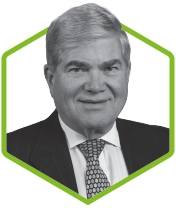
Director since: 2003 Age: 72 Independent Lead Director
Committees:  Executive Committee  NESG Committee  Risk Oversight Committee |
Career Highlights  Attorney at McCurdy, Wotila & Porteous, P.C., a law firm, since 2008.  Practiced law for more than 40 years with a focus on business, corporate, and municipal law and government relations.  Prior to joining McCurdy, Wotila & Porteous, he managed his own law practice for more than 20 years.  Recognized authority on economic development and has served on the boards of the Michigan Economic Development Corporation; the Michigan Economic Growth Authority, where he was chairman of the executive committee; the Michigan Strategic Fund, where he was chairman; and the Michigan Chamber of Commerce.  Former director of the Federal Home Loan Bank of Indianapolis, where he chaired the audit committee.  Served on the board of trustees of Michigan State University, where he was chairman of the board, from 2003 to 2006, and was a member of its finance and audit committees.  Served as a director of Jackson National Life Insurance of New York, from 2002 to 2016, where he served as a member of the audit, risk, and compensation committees.  Brings significant legal, economic, and leadership experience to the Board and the committees on which he serves.
Education  Holds a bachelor’s degree in criminal justice from Michigan State University and a juris doctor degree from Western Michigan University, Cooley Law School.
Key Experience and Skills:  Audit/Financial Reporting  Compensation & Human Capital Management  Corporate Responsibility  Financial Services  Government, Public Policy & Regulatory  Legal  Risk Management  Strategic Planning/M&A |
| 28 | Huntington Bancshares Incorporated 2025 Proxy Statement | |
| Election of Directors |  |
| Teresa H. Shea | |

Director since: 2024 Age: 65
Committees:  Technology Committee |
Career Highlights  President, Oplnet, LLC, a business that provides expertise and experience to help government and commercial customers improve performance in the areas of national defense and intelligence, since 2022.  Served as Vice President, Cyber Offense Defense Experts (CODEX) within Raytheon Intelligence and Space, an entity that provides cyber capabilities for offense, defense, and security initiatives for customers in the intelligence and defense industries, from 2019 to 2022.  Served as Executive Vice President of Technology and a director of Cyber-Reboot at In-Q-Tel, a not-for-profit strategic investment firm that accelerates the development and delivery of cutting-edge technologies to the intelligence community and Department of Defense from the venture-backed tech start-up ecosystem, from 2016 to 2019.  Joined In-Q-Tel after spending 32 years at the U.S. National Security Agency (NSA), where she held several leadership positions, including most recently as the Director of Signals Intelligence, where she advised the Directors of NSA, the Director of National Intelligence, U.S. Military officers, and other high-ranking U.S. government officials.  Serves on the Army Science Board Intelligence Committee, the Georgia Institute of Technology school of Electrical and Computer Engineering Advisory Board, the Georgia Institute of Technology Board of Advisors, and the Cigent Technology Inc. board of directors.  Leverages expertise through board service, advising Sandbox AQ, a leader in Quantum Science, and Altana, a premier provider of Supply Chain Security solutions. Actively contributes to the cybersecurity community as Co-Chair of the Cyber Guild Organization and the National Cryptologic Foundation Board, both non-profit organizations dedicated to advancing cybersecurity.  Brings significant leadership and cybersecurity expertise in the intelligence and national defense industries, which makes her a valuable member of the Board and Technology Committee.
Education  Holds a bachelor’s degree in electrical engineering from Georgia Institute of Technology and a master’s degree in electrical engineering from Johns Hopkins University.
Other Prior Public Company Boards Within Five Years  Served on the board of ZeroFox Holdings, Inc., an enterprise software-as-a-service company, from 2023 to 2024.
Key Experience and Skills:  Audit/Financial Reporting  Client/Consumer Marketing, Branding & Communication  Compensation & Human Capital Management  Government, Public Policy & Regulatory  Public Company Executive  Risk Management  Strategic Planning/M&A  Technology, Cybersecurity & Information Security |
| Huntington Bancshares Incorporated 2025 Proxy Statement | 29 | |
 |
Election of Directors |
| Roger J. Sit | |

Director since: 2021 Age: 63
Committees:  HRCC  Risk Oversight Committee |
Career Highlights  CEO, Global Chief Investment Officer, and Director at Sit Investment Associates, Inc., a privately-owned institutional investment management firm, since 2008.  Served in the U.S. Air Force, attaining the rank of Captain.  Has over 30 years of financial services experience, including as vice president and senior equity research analyst at Goldman Sachs & Co.  Served on the investment committee of the McKnight Foundation, a family foundation that is focused on advancing a more just, creative, and abundant future where people and the planet thrive. Previously, Mr. Sit served on the board of the McKnight Foundation and as a member of the executive committee and is a past chair of the finance and audit committee and the investment committee.  Brings significant leadership and financial services expertise, making him a valuable member of our Board.
Education  Holds a bachelor’s degree in management from the U.S. Air Force Academy, a master’s degree in systems management from the University of Southern California, and a master’s degree in business administration from the Harvard Business School.
Other Prior Public Company Boards Within Five Years  Prior to the TCF Merger in 2021, he served on the board of TCF (formerly Chemical Financial Corporation) since its 2019 merger with legacy TCF, the board of which he had served on since 2015.
Key Experience and Skills:  Audit/Financial Reporting  Compensation & Human Capital Management  Corporate Responsibility  Financial Services  Government, Public Policy & Regulatory  Risk Management  Strategic Planning/M&A |
| 30 | Huntington Bancshares Incorporated 2025 Proxy Statement | |
| Election of Directors |  |
| Stephen D. Steinour | |

Director since: 2009 Age: 66
Committees:  Executive Committee
Other Current Public Company Directorships:  Bath & Body Works, Inc. |
Career Highlights  Chairman, President, and CEO of Huntington and President and CEO of Huntington Bank, since January 2009. Mr. Steinour was also Chairman of Huntington Bank until the TCF Merger in 2021. He joined Huntington from CrossHarbor Capital Partners, a recognized leading manager of alternative investments, where he served as a Managing Partner, from 2008 to 2009.  Served in various executive roles for Citizens Financial Group, from 1992 to 2008, with responsibilities for credit, risk management, wholesale and regional banking, consumer lending, technology, and operations, among others. He was named President in 2005 and CEO in 2007.  Serves as a member of the audit committee and as a member of the human capital and compensation committee on the board of Bath & Body Works, Inc.  Serves as a trustee of The Ohio State University Wexner Medical Center, co-chair of The Columbus Partnership, and as a member of the board of Battelle Memorial Institute.  Member of the Board of the Bank Policy Institute and Member of the Ohio Business Roundtable and The Clearing House.  Former director of the Federal Reserve Bank of Cleveland, from 2017 to 2019.  Served on the board of trustees of Liberty Property Trust, is a former trustee of the Eisenhower Fellowships and the National Constitution Center, and past chairman of the Greater Philadelphia Chamber of Commerce.  With more than 40 years of experience in all aspects of banking, he brings extensive leadership experience, as well as broad knowledge of the banking industry to the Board and his role as CEO.
Education  Holds a bachelor’s degree in economics from Gettysburg College and completed the Stanford University Graduate School of Business Executive Program.
Other Prior Public Company Boards Within Five Years  Served on the board of L Brands, Inc., a specialty retail company, from 2014 until it split into separate companies in 2021; continued on the board of Bath & Body Works, Inc.  Served on the board of Exelon Corporation, a utility services holding company, from 2007 to 2020.
Key Experience and Skills:  Audit/Financial Reporting  Client/Consumer Marketing, Branding & Communication  Compensation & Human Capital Management  Corporate Responsibility  Financial Services  Government, Public Policy & Regulatory  Public Company Executive  Risk Management  Strategic Planning/M&A  Technology, Cybersecurity & Information Security |
| Huntington Bancshares Incorporated 2025 Proxy Statement | 31 | |
 |
Election of Directors |
| Jeffrey L. Tate | |
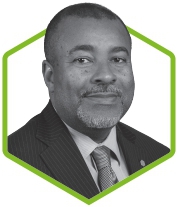
Director since: 2021 Age: 55
Committees:  Audit Committee |
Career Highlights  CFO of Dow Inc., a global chemical and plastics manufacturer, since 2023. Mr. Tate re-joined Dow after serving as CFO and Executive Vice President of Leggett & Platt, a diversified manufacturer, from 2019 to 2023.  Previously served as Vice President and Business Finance Director for the Packaging and Specialty Plastics segment of Dow, from 2017 to 2019. Mr. Tate directed and oversaw all finance activities at Dow to provide strategic and financial counsel for the businesses. He also served as Chief Auditor of Dow, from 2012 to 2017, with responsibility for leading internal audit and corporate investigations globally.  Began his career with Dow in Louisiana in 1992 and held a variety of accounting and controller roles before relocating to Michigan for several finance leadership assignments in Dow Automotive, Investor Relations, Performance Materials, and Performance Plastics.  Chosen as CFO of the Year by the National Association of Black Accountants in 2020. In 2020 and 2012, he was named to Savoy Magazine’s Top 100 Most Influential Blacks in Corporate America.  Serves as a member of the Financial Executives International, the Executive Leadership Council, the American Institute of Certified Public Accountants, and Omega Psi Phi Fraternity, Incorporated.  Previously served on the PCAOB Standing Advisory Group.  Brings significant finance and accounting expertise, making him a key member of the Board and Audit Committee.
Education  Holds a bachelor’s degree in accounting from the University of Alabama and is a Certified Public Accountant.
Other Prior Public Company Boards Within Five Years  Prior to the TCF Merger in 2021, he served on the board of TCF (formerly Chemical Financial Corporation) since its 2019 merger with legacy TCF, the board of which he had served on since 2017.
Key Experience and Skills:  Audit/Financial Reporting  Compensation & Human Capital Management  Financial Services  Public Company Executive  Risk Management  Strategic Planning/M&A |
| 32 | Huntington Bancshares Incorporated 2025 Proxy Statement | |
| Election of Directors |  |
| Gary Torgow | |
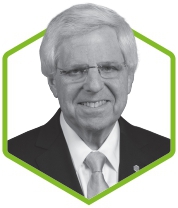
Director since: 2021 Age: 68
Committees:  Community Development Committee
Other Current Public Company Directorships:  DTE Energy Company |
Career Highlights  Chairman of The Huntington National Bank, since 2021.  Previously served as the executive chairman of TCF (known as Chemical Financial Corporation until 2019) from 2016 until the TCF Merger in 2021; previously served as executive chairman of Talmer Bancorp, Inc. until its merger with Chemical Financial Corporation (later renamed TCF in 2019).  Before joining Talmer, Mr. Torgow founded and chaired the Sterling Group, a Michigan-based real estate and development company.  Serves as a director of Blue Cross Blue Shield of Michigan, one of the state’s largest medical insurers.  Mr. Torgow serves as the Chairman of the Business Leaders of Michigan, a roundtable of the top 100 CEOs and Chairpeople of the state’s leading companies.  Serves as President of the Jewish Federation of Detroit and as a trustee for The Skillman Foundation and the Community Foundation for Southeast Michigan, two of Michigan’s largest philanthropic enterprises.  Mr. Torgow is a recipient of the NAACP’s Lifetime Achievement Award and the Urban League’s Distinguished Warrior Award.  He is well known throughout Michigan for his business and philanthropic activities.  Brings significant financial services expertise, as well as deep knowledge about the Midwest, Detroit, and Michigan marketplaces, making him a valued member of the Board.
Education  Holds a bachelor’s degree in history from Yeshiva University and a law degree from Wayne State University, where he received the Distinguished Alumni Award.  Holds honorary doctorates from Alma College and Eastern Michigan University.
Other Prior Public Company Boards Within Five Years  Prior to the TCF Merger in 2021, he served as the executive chairman of TCF (formerly Chemical Financial Corporation) since 2016.
Key Experience and Skills:  Audit/Financial Reporting  Compensation & Human Capital Management  Corporate Responsibility  Financial Services  Government, Public Policy & Regulatory  Legal  Public Company Executive  Risk Management  Strategic Planning/M&A |
| Huntington Bancshares Incorporated 2025 Proxy Statement | 33 | |
 |
Election of Directors Compensation of Directors |
Compensation of Directors
Our compensation philosophy for the Board is to provide compensation to non-employee Directors that reflects the significant time commitment and substantial contributions the Directors are expected to make to the value creation and governance of Huntington.
The compensation levels and structure for Directors are designed, with the input of the independent compensation consultant, to enable us to attract and retain high caliber talent at a national level and also to align the Directors’ interests with those of our shareholders. The program is retainer-based and paid in a combination of cash and equity. A meaningful portion of Director compensation is paid in equity that is subject to ownership requirements. Meeting fees in cash are paid only when the number of meetings exceed a certain threshold. The CEO and Mr. Torgow do not receive compensation for their service as a Director.
The HRCC performs a review of the compensation program for Directors each year facilitated by the independent compensation consultant. In 2021, the HRCC set the Director annual cash retainer at $100,000 and the Director annual equity retainer at $137,500 to align with market practices.
| Base Compensation | ||||
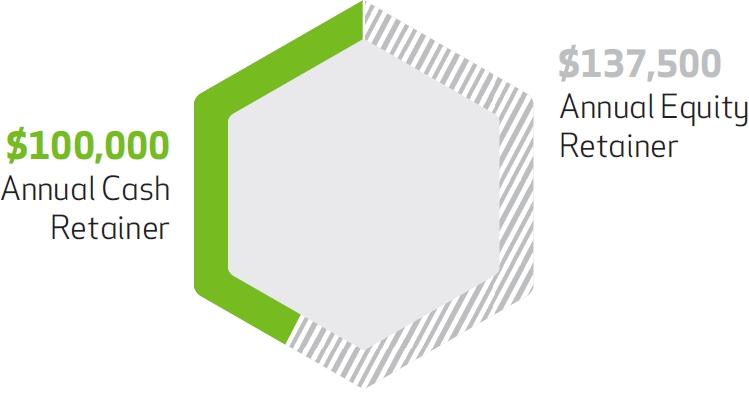 |
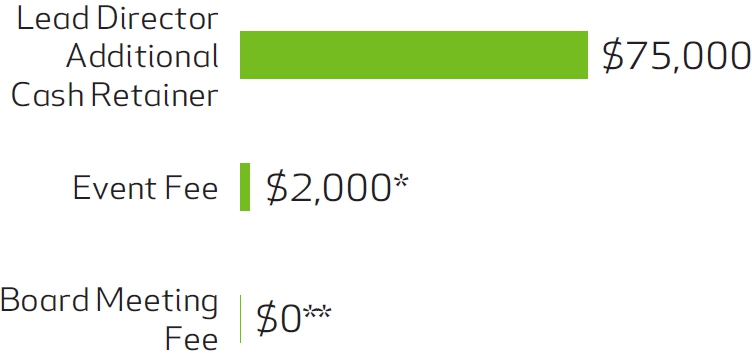 |
Director Equity Compensation A meaningful portion of Director compensation is paid in equity that is subject to ownership requirements. Equity grants for Directors are in the form of deferred stock units. The deferred stock units are vested upon grant but not released to the Director until the later of six months following separation of service or one year from the date of grant. |
||
| Additional Retainers | ||||
| Committee Chair Retainers | Committee Member Retainers | |||
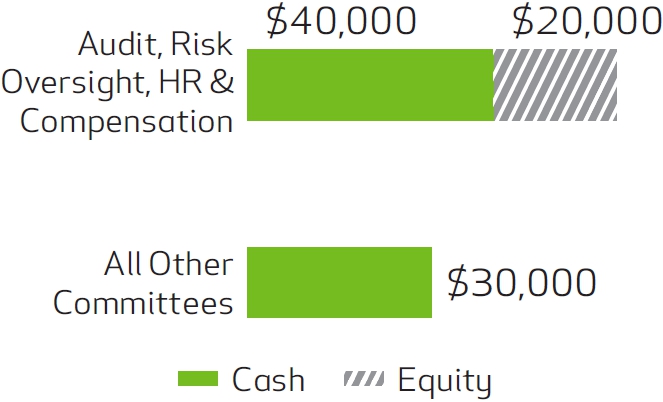 |
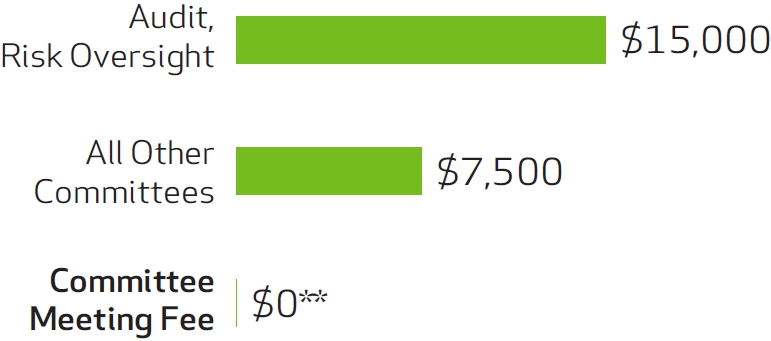 |
|||
| * | An event fee is paid when, at Huntington’s request, a Director attends or participates in an event or meeting in their capacity as a Director. Such events could include conferences hosted by regulators, regional bank visits, or Huntington-sponsored training. |
| ** | A $2,000 per meeting fee is paid only when meetings exceed: 20 meetings in a calendar year for the Audit Committee and the Risk Oversight Committee; 8 meetings in a calendar year for all other committees; or 15 meetings in a calendar year for the Board. If the threshold for any committee (or the full Board) is not exceeded, then no meeting fee is paid for that meeting. |
All fees payable in cash are paid in quarterly installments. A Director may defer all or a portion of the cash and equity compensation payable to the Director through participation in the Director Deferred Compensation Plan.
| 34 | Huntington Bancshares Incorporated 2025 Proxy Statement | |
|
Election of Directors Compensation of Directors |
 |
Director Compensation 2024
| Name | Fees Earned or Paid in Cash ($)(2) |
Stock Awards ($)(3)(4) |
Option Awards ($) |
Non-Equity Incentive Plan Compensation ($) |
Change in Pension Value and Non-qualified Deferred Compensation Earnings ($) |
All Other Compensation ($) |
Total ($) |
|||||||
| Alanna Y. Cotton | 123,000 | 137,496 | — | — | — | — | 260,496 | |||||||
| Ann B. (Tanny) Crane | 154,500 | 137,496 | — | — | — | — | 291,996 | |||||||
| Rafael Andres Diaz-Granados | 142,500 | 137,496 | — | — | — | — | 279,996 | |||||||
| Gina D. France | 161,000 | 157,494 | — | — | — | — | 318,494 | |||||||
| J. Michael Hochschwender | 147,500 | 137,496 | — | — | — | — | 284,996 | |||||||
| John C. (Chris) Inglis | 123,000 | 137,496 | — | — | — | — | 260,496 | |||||||
| Richard H. King | 123,000 | 137,496 | — | — | — | — | 260,496 | |||||||
| Katherine M.A. (Allie) Kline | 123,000 | 137,496 | — | — | — | — | 260,496 | |||||||
| Richard W. Neu | 173,000 | 157,494 | — | — | — | — | 330,494 | |||||||
| Kenneth J. Phelan | 163,000 | 157,494 | — | — | — | — | 320,494 | |||||||
| David L. Porteous | 286,000 | 137,496 | — | — | — | — | 423,496 | |||||||
| Teresa H. Shea | 88,625 | 137,496 | — | — | — | — | 226,121 | |||||||
| Roger J. Sit | 124,500 | 137,496 | — | — | — | — | 261,996 | |||||||
| Jeffrey L. Tate | 117,000 | 137,496 | — | — | — | — | 254,496 | |||||||
| Gary Torgow(1) | — | — | — | — | — | 2,856,592 | 2,856,592 |
| (1) | The “All Other Compensation” column for Mr. Torgow includes a final advisory fee of $2.75 million paid to Mr. Torgow pursuant to his Letter Agreement, $52,948 related to Mr. Torgow’s use of a car and driver and security personnel provided by Huntington, representing the cost of fuel, salary, and overtime costs for the driver, and maintenance and depreciation on the vehicle, and $53,644 related to administrative support and use of office space. Pursuant to a Letter Agreement, dated December 13, 2020, by and between Mr. Torgow and Huntington, Mr. Torgow provides advisory services to Huntington, including advice on the development, strengthening, and growth of customer, community, and local government relationships. For these services, Director Torgow received previously disclosed cash payments. On May 31, 2024, Mr. Torgow and Huntington entered into a Side Letter extending the terms of the Letter Agreement for three years starting June 9, 2024 and terminating on June 9, 2027, which is the sixth year after the closing date of the TCF Merger. During the term of the Side Letter, Mr. Torgow is entitled to other benefits including (1) an executive administrative assistant, (2) a dedicated driver and security personnel for security purposes, and (3) other staff as requested and approved by the CEO. Pursuant to the terms of the Letter Agreement and Side Letter, Mr. Torgow receives no compensation for his service on Huntington’s Board. |
| (2) | Amounts include fees deferred by participating Directors under the Director Deferred Compensation Plan. |
| (3) | On May 1, 2024, grants of 11,538 deferred stock units were made to the chairs of the Audit Committee, HRCC, and Risk Oversight Committee, and grants of 10,073 deferred stock units were made to each other Director under the 2024 Long-Term Incentive Plan. These deferred stock unit awards will be credited with an additional number of deferred stock units to reflect reinvested dividend equivalents with respect to the period of time between the date of grant and the delivery of shares. All awards were vested upon grant but are not released until the later of six months following separation of service or one year from the date of grant. This column reflects the grant date fair value in accordance with FASB Topic 718 and is equal to the number of units times the fair market value (the closing price of a share of common stock) on the last trading day prior to the date of grant. |
| Huntington Bancshares Incorporated 2025 Proxy Statement | 35 | |
 |
Election of Directors Compensation of Directors |
| (4) | The HRCC has granted deferred stock awards to non-employee Directors each year since 2006. The Directors’ deferred stock unit awards outstanding as of December 31, 2024, are set forth in the table below. |
| Name | Deferred Stock Awards Outstanding |
||
| Alanna Y. Cotton | 68,879 | ||
| Ann B. (Tanny) Crane | 166,935 | ||
| Rafael Andres Diaz-Granados | 22,847 | ||
| Gina D. France | 100,559 | ||
| J. Michael Hochschwender | 97,099 | ||
| John C. (Chris) Inglis | 22,847 | ||
| Richard H. King | 40,048 | ||
| Katherine M.A. (Allie) Kline | 76,239 | ||
| Richard W. Neu | 197,329 | ||
| Kenneth J. Phelan | 80,376 | ||
| David L. Porteous | 183,566 | ||
| Teresa H. Shea | 10,302 | ||
| Roger J. Sit | 40,048 | ||
| Jeffrey L. Tate | 40,048 |
| 36 | Huntington Bancshares Incorporated 2025 Proxy Statement | |
|
Election of Directors Compensation of Directors |
 |
Director Deferred Compensation Plan
We offer a deferred compensation program that allows the members of the Board to elect to defer receipt of all or a portion of the cash and equity compensation payable to them in the future for services as Directors. Amounts deferred will accrue interest, earnings, and losses at the market rate of the investment option selected by the participant. The investment options consist of Huntington common stock and a variety of mutual funds that are generally available under and/or consistent with the types of investment options available under our tax-qualified 401(k) Plan for colleagues.
A Director’s account will be distributed either in a lump sum or in annual installments, as elected by each Director, following the age or date specified by the Director at the time the deferral election was made, or the Director’s termination as a Director. All the assets of the current and predecessor plans are subject to the claims of our creditors.
As of December 31, 2024, the participating Directors’ accounts under the current and predecessor plans were substantially comprised of Huntington common stock and had the values set forth in the table below.
| Participating Directors | Account Balance at December 31, 2024 |
|
| Alanna Y. Cotton | $ 422,800 | |
| Ann B. (Tanny) Crane | 1,373,902 | |
| Rafael Andres Diaz-Granados | 258,840 | |
| J. Michael Hochschwender | 116,300 | |
| John C. (Chris) Inglis | 193,921 | |
| Richard H. King | 38,637 | |
| Katherine M.A. (Allie) Kline | 77,192 | |
| Richard W. Neu | 3,773,773 | |
| Kenneth J. Phelan | 731,360 | |
| David L. Porteous | 1,862,404 | |
| Teresa H. Shea | 56,080 | |
| Roger J. Sit | 532,479 | |
| Jeffrey L. Tate | 79,318 |
In addition, Ms. France and Mr. Hochschwender have account balances under a FirstMerit Corporation deferred compensation plan valued at $1,150,831 and $1,423,513, respectively, as of December 31, 2024. The investment options consist of Huntington common stock and a variety of mutual funds that are generally available under and/or consistent with the types of investment options available under our tax-qualified 401(k) Plan for colleagues.
| Huntington Bancshares Incorporated 2025 Proxy Statement | 37 | |
 |
|
Corporate Governance
| Corporate Governance | Huntington and its Board are committed to strong corporate governance and to continually enhancing our practices so that we are better positioned to create shareholder value over time. Our Board is structured to provide effective and independent oversight of Huntington’s corporate governance framework. |
Commitment to Good Governance Practices
Huntington’s Board and management believe that strong corporate governance is critical to our long-term success. Executive management and the Board work together to not only maintain legal and regulatory compliance with respect to our governance practices, but to also implement a robust governance framework with hallmarks of transparency and effectiveness. By having appropriate governance practices in place, we are better equipped to operate efficiently, keep pace with market trends and shareholder expectations, and remain compliant with regulatory expectations. Moreover, the Company understands that the governance landscape and shareholder focuses are constantly changing and evolving. Therefore, Huntington seeks to continually monitor its practices with a view towards enhancing them over time. To this end, the Board adopted several corporate governance documents that compose Huntington’s governance framework. Chief among these is the Corporate Governance Guidelines that detail Board responsibilities, Director qualifications, and structures and practices intended to enhance the Board’s effectiveness.
We have adopted an
As demonstrated throughout this Corporate Governance section and as highlighted in the Proxy Summary section, Huntington has a record of implementing a strong governance framework.
| Documents available on or through our website at ir.huntington.com: | |
| Corporate Governance Documents | |
 |
Code of Conduct and Ethics |
 |
Corporate Governance Guidelines |
 |
Financial Code of Ethics for CEO and Senior Financial Officers |
 |
Financial Restatement Recoupment Policy |
 |
Insider Trading Policy |
 |
Misconduct Recoupment Policy |
| Board Committee Charters | |
 |
Audit Committee Charter |
 |
Community Development Committee Charter |
 |
Executive Committee Charter |
 |
HRCC Charter |
 |
NESG Committee Charter |
 |
Risk Oversight Committee Charter |
 |
Technology Committee Charter |
| Investor Relations Policies | |
 |
Investor Relations Public Disclosure and Access Policy |
| Corporate Responsibility Documents | |
 |
California Voluntary Carbon Market Disclosure |
 |
Climate Report |
 |
Climate Risk Statement |
 |
Corporate Responsibility Report |
 |
EEO-1 data disclosure |
 |
Environmental Health and Safety Policy Statement |
 |
Environmental Policy Statement |
 |
Huntington Human Rights Statement |
 |
Huntington Political Action Committee Contribution Report |
 |
Service Provider Code of Conduct |
| 38 | Huntington Bancshares Incorporated 2025 Proxy Statement | |
|
Corporate Governance Commitment to Good Governance Practices |
 |
Shareholder Outreach and Engagement
We value the views of our investors and welcome feedback from them. The NESG Committee, on behalf of our Board, oversees our outreach and engagement practices. Typically, members of management, and on occasion the independent Lead Director, hold conversations about governance and executive compensation matters with our largest investors biannually. During 2024, we were actively engaged in discussions with Huntington’s shareholders. These conversations are summarized for the NESG Committee, thus providing the Board with valuable insight.
|
As part of 2024 autumn outreach, we sent invitations to investors collectively holding approximately 58% of outstanding common stock* and held meetings with investors owning in the aggregate approximately 25% of outstanding common stock* * As of 12/31/24. |
 |
We reach out to our investors throughout the year Seeking perspectives on governance and other topics such as:  Our corporate responsibility activities;  Huntington’s disclosures;  Evolving investor policies;  Board refreshment and structure;  Executive compensation; and  Other governance issues of interest. |
 |
|
Huntington believes that shareholder engagement is an ongoing process that should occur throughout the year during multiple touchpoints. Therefore, we have developed a robust process that allows us to maintain contact with shareholders and other market participants throughout the year. In addition to hearing from investors about their positions and expectations, we seek to develop and strengthen relationships with them.
Our Corporate Governance, Corporate Responsibility, Investor Relations, and Total Rewards teams work closely together to provide an effective, integrated engagement program that positively impacts our shareholders and their representatives. The following provides an overview of our engagement process:
| Engagement Process | ||||
|
Early Spring Publish our proxy statement and annual report; may seek to engage with shareholders depending on the proposals to be voted upon |
Mid-Spring Annual shareholder meeting with members of the Board and executive management in attendance; analyze voting results following the annual meeting to evaluate shareholder support |
Autumn Engage with institutional shareholders through scheduled calls and video conferences that primarily focus on Corporate Responsibility and executive compensation matters |
||
 |
Continuous |  |
Throughout the year, engage with shareholders and others during conferences, road shows, and earnings calls
| Huntington Bancshares Incorporated 2025 Proxy Statement | 39 | |
 |
Corporate Governance Commitment to Good Governance Practices |
During the autumn of 2024 outreach calls, we solicited shareholder feedback primarily on our corporate governance framework, corporate responsibility practices and disclosures, and executive compensation. Our independent Lead Director, Mr. Porteous, also has been a frequent speaker on governance matters at director forums and with investors. Feedback from these engagements was summarized and presented to the NESG Committee so that the Board understands what issues are most important to shareholders.
The following table sets forth some of the most frequent feedback we received and how we are addressing it:
| What we heard… | How we are addressing it… | |
| Shareholders sought insights as to Huntington’s corporate governance structure, including board size, composition, desired skills, committee structure, and succession planning. |  |
In 2024 and continuing into 2025, we assessed the efficacy of our Board and committee structures in reference to best practices and market standards. In response, we are nominating 12 Directors to the Board and evaluating our committee structure. |
| Shareholders inquired as to how Huntington was responding to potential regulatory changes impacting ESG. |  |
Throughout 2024 and into 2025, we continue to monitor regulatory changes at the federal, state, and local levels, taking actions such as engaging third-party vendors to conduct readiness assessments for specific jurisdictions. We also continue to monitor the international disclosure landscape. We continue to evaluate our Board and committee oversight of governance and ESG. |
| Shareholders continued to emphasize the importance of aligning compensation with Company performance. |  |
Beginning in 2025, PSUs will comprise 60% of the total annual long-term incentive grant value for our CEO (up from 55%) and 55% for our other NEOs (up from 50%). |
Communications with the Board
Shareholders and other interested parties who wish to send communications to the Board may find information on the Board of Directors page accessible through our website at ir.huntington.com. Communications may be directed to the Board, a committee of the Board, the independent Lead Director, the independent Directors as a group, or an individual Director by indicating in the communication to whom it should be directed.
The Office of the Corporate Secretary circulates communications to the appropriate Director or Directors, except for those communications that are of a personal nature or unrelated to the duties and responsibilities of the Board, including, without limitation, routine customer service matters, commercial solicitations, employment resumes, and mass mailings.
For those customers seeking support, please refer to the Customer Service page on Huntington’s website.
| 40 | Huntington Bancshares Incorporated 2025 Proxy Statement | |
|
Corporate Governance Continually Assessing and Enhancing Director Skills and Board Effectiveness |
 |
Continually Assessing and Enhancing Director Skills and Board Effectiveness
The NESG Committee regularly assesses the composition of the Board to ensure that the appropriate knowledge, skills, and experience are represented. A robust refreshment and succession planning process has been established to enhance the Board’s current set of skills, to plan for known Director retirements, and to be ready for unplanned changes.
Board Refreshment and Succession Planning
The Board is committed to maintaining a well-rounded and effective membership to better ensure overall Board effectiveness, meaningful oversight of the Company’s business strategy, and the Company’s long-term success.
At least annually, the NESG Committee assesses the size of the Board and reviews its composition to ensure that the appropriate knowledge, skills, and experience are represented, in the Committee’s judgment. The Board is committed to an ongoing refreshment process.
| To help bring about fresh perspectives, several new Directors have been added within the last five years. The Board recognizes that it is critical to maintain a range of tenures to ensure sufficient experience for Board leadership positions, Board continuity, and institutional knowledge through economic cycles and business climates. The tenures of our current Directors range from one year to more than 20 years (as of the date of the 2025 Annual Meeting). |
0
to 5 years 6 to 10 years 11 to 25 years Average Tenure: 8 years |
| Huntington Bancshares Incorporated 2025 Proxy Statement | 41 | |
 |
Corporate Governance Continually Assessing and Enhancing Director Skills and Board Effectiveness |
|
Director Qualifications Factors considered by the NESG Committee and the Board in their review of potential candidates include: |
||
 |
Whether the candidate has exhibited behavior that indicates they are committed to the highest ethical standards. | |
 |
The candidate’s experience in the financial services industry and with risk management and compensation practices. | |
 |
The candidate’s general business knowledge and special skills, expertise, and background that would complement the attributes of the existing Directors. | |
 |
The candidate’s leadership and prominence within their business, governmental, or professional activities and whether their reputation demonstrates the ability to make the kind of important and sensitive judgments that the Board is called upon to make. | |
 |
The candidate’s background considering the backgrounds of the existing Board members. | |
 |
The candidate’s willingness to challenge management while working constructively as part of a team in an environment of collegiality, confidence, and trust. | |
 |
A determination of whether the candidate will be able to devote sufficient time and energy to the performance of their duties as a Director based on their current and potential commitments. | |
 |
The existence of any conflicts of interest. | |
Selection and Recruitment of Directors
One of the most important duties carried out by the NESG Committee is the selection and recruitment of new Board members. Through the NESG Committee’s structured process, the Board can be better assured that it is positioned to properly oversee the Company now and in the future.
The NESG Committee thoroughly reviews the qualifications of potential Director candidates, as well as those Directors standing for reelection and makes recommendations to the full Board. Each of the Director nominees meets the standards listed in the Board Refreshment and Succession Planning subsection above. From time to time, the NESG Committee will identify additional selection criteria for Board membership, taking into consideration the Company’s business strategy, the business environment, and current Board composition. The NESG Committee may also use a third-party search firm to seek out candidates for the Board.
When seeking out individuals for appointment to the Board, the NESG Committee and Board undertake a rigorous screening process. This process helps ensure that the right individuals are selected for directorship. The following sets forth the typical selection and recruitment process:
| Sources for candidates | Candidate pool | In-depth review | Recommendation to the Board | Board review | ||||
 The
NESG Committee and Board consider
potential candidates submitted by Directors, management,
search firms, shareholders, and self-nominees. The
NESG Committee and Board consider
potential candidates submitted by Directors, management,
search firms, shareholders, and self-nominees.
|
 Director
searches include a slate of candidates with various backgrounds, skills, and
experiences. Director
searches include a slate of candidates with various backgrounds, skills, and
experiences.
|
|
 The
NESG Committee makes a recommendation
to the Board following the review process. The
NESG Committee makes a recommendation
to the Board following the review process.
|
 Following
the NESG Committee’s recommendation,
the full Board will vote on the candidate’s
appointment. Following
the NESG Committee’s recommendation,
the full Board will vote on the candidate’s
appointment.
|
The Director Onboarding and Continuing Education subsection describes the process that new Directors undergo to assist with their acclimation to the Board and Company. Individuals who wish to recommend individuals for directorship are encouraged to review the General Information on Voting and the Annual Meeting section.
| 42 | Huntington Bancshares Incorporated 2025 Proxy Statement | |
|
Corporate Governance Continually Assessing and Enhancing Director Skills and Board Effectiveness |
 |
Regular Board Evaluations
Candid and thorough Board evaluations are necessary to ensure that the Board and committees are productive and operating efficiently. The self-assessment is also used to shape the Board and its composition so that it is best positioned to oversee Huntington’s long-term strategy and continued success.
The NESG Committee oversees a Board evaluation process for the Board and its committees each year. Regular evaluation is critical to assessing strengths and identifying areas for enhancement, and the annual process is designed to ensure that Board members are free to speak openly and candidly. Periodically, the Board will engage an experienced third party to facilitate the Board’s self-assessment and assessments of individual Directors.
As part of the Board evaluation process, the Board considers, among other matters, whether its composition reflects the skills needed to appropriately oversee the Company’s long-term strategy and continued success. The Board also evaluates its processes and interactions with management to determine whether it is operating efficiently with respect to its oversight responsibilities.
In addition to participating in the annual Board evaluation process, Directors are encouraged to raise any topics related to Board performance and effectiveness, or any other matter, at any time with the independent Lead Director, the Chair of the NESG Committee, the chair of an applicable committee, the Chairman of the Board, or the Board as a whole, as appropriate. The independent Lead Director makes it a point to engage one-on-one with each Board member throughout the year.
The following sets forth the process that is typically used for the Board self-evaluations:

In 2024, the Board engaged an experienced third-party firm to facilitate the Board’s self-evaluation. Interviews were conducted with each Board member as part of the evaluation process including, but not limited to, Board and committee culture, dynamics, operations, structure, and composition.
The purpose of the assessment was to optimize Board effectiveness and productivity, ensure director subject matter expertise was fully leveraged in relation to committee assignments and committee chair roles, and to provide feedback to the independent Lead Director and Chairman of the Board. In addition, the assessment provided an opportunity for the Board, as a group, and for individual Board members, to receive feedback on their performance. Follow-up action items identified are being implemented into action plans.
| Huntington Bancshares Incorporated 2025 Proxy Statement | 43 | |
 |
Corporate Governance Board Role and Responsibilities |
Board Role and Responsibilities
The Board’s Role in Risk Oversight
We have a deeply ingrained risk management culture, that is anchored in our Board-approved aggregate moderate-to-low risk appetite.
We rely on comprehensive risk management processes to identify, measure, monitor, control, and report risks and to aggregate risks across the enterprise. This system enables the Board to understand the effectiveness of the Company’s risk management practices and capabilities, review the Company’s risk exposure relative to its risk appetite, and ensures material risks are escalated to the Board for awareness and discussion.
Our Risk Appetite Statement and Risk Governance Framework are the foundation of consistent and effective risk management. They define roles and responsibilities and establish limits for the seven key risk categories to which we are exposed:
 |
Compliance risk |  |
Credit risk |  |
Liquidity risk |  |
Market risk |
 |
Operational risk |  |
Reputation risk |  |
Strategic risk |
The Risk Appetite Statement and the Risk Governance Framework describe components of our risk management approach, including our risk appetite and risk management processes, with a focus on the role of all colleagues in managing risk. The Risk Appetite Statement defines the level and types of risks the Board is willing to assume to achieve our corporate objectives.
While the Board has three committees that primarily oversee implementation of the risk governance framework and risk appetite—the Risk Oversight Committee, the Audit Committee, and the Technology Committee—the full Board is engaged in discussing risks and monitoring our risk profile. All standing committees report their deliberations and actions at each full Board meeting. In addition, all scheduled committee meetings are open to all Directors, and committees regularly meet in joint sessions to discuss issues that are broadly applicable. Our Directors have unfettered access to senior executive officers, and the Board and committees regularly meet in executive session without management present.
The role of each Board committee is further described under Board, Committee, and Leadership Structure.
| Board of Directors | ||
 |
Approves the Company’s risk appetite and directly oversees risks related to Company strategy and leadership. Our aggregate moderate-to-low risk appetite is an integral part of our strategy and strategic planning process. | |
 |
Meets frequently with senior management and is devoted to reviewing strategic priorities. | |
 |
The CEO reserves time at the beginning of Board meetings to discuss priorities and initiatives. | |
 |
Committees report significant discussion items to the full Board. | |
 |
Special Board sessions are periodically held to discuss and analyze specific possible risk scenarios, such as cybersecurity incident simulations. | |
 |
Oversees succession planning for the positions of the CEO and other members of the ELT. | |
 |
Executive sessions are held at every regularly scheduled Board meeting. | |
| 44 | Huntington Bancshares Incorporated 2025 Proxy Statement | |
|
Corporate Governance Board Role and Responsibilities |
 |
Board Committees
Risk Oversight Committee |
||
 |
Assists the Board in overseeing implementation and adherence of the Company’s enterprise-wide Risk Governance Framework, including: | |
 |
oversight of our primary risks: credit, liquidity, market, operational, compliance, strategic, and reputation risk; | |
 |
annually reviews and approves the Risk Governance Framework; | |
 |
annually reviews, and recommends for Board approval, the Company’s Risk Appetite Statement, which includes qualitative statements, quantitative risk limits, and escalation processes; | |
 |
annually reviews and approves key Company-wide risk policies; | |
 |
oversees the Company’s independent corporate risk management function; and | |
 |
the CRO reports directly to both the Risk Oversight Committee and the CEO. | |
 |
Receives reports directly from the CRO at least quarterly, including those related to our risk appetite position. | |
 |
Oversees the administration and effectiveness of our capital management and planning process, including capital adequacy assessment and forecasting processes, capital strategy, and end-to-end capital planning. | |
 |
Oversees the administration, effectiveness, and independence of our credit review function. The Credit Review Director reports directly to the Risk Oversight Committee and administratively to the CEO. | |
Audit Committee |
||
 |
Assists the Board in overseeing the integrity of the consolidated financial statements, including oversight of: | |
 |
policies, procedures, and practices regarding the preparation and audits of financial statements, the accounting and financial reporting process, disclosures, and internal control over financial reporting; the internal audit department; and the independent registered public accounting firm’s qualifications, independence, and reports; | |
 |
compliance with our Financial Code of Ethics for CEO and Senior Financial Officers; | |
 |
compliance with corporate securities trading policies; and | |
 |
compliance with legal and regulatory requirements. | |
 |
The Audit Committee is directly responsible for the appointment, annual review, compensation, and termination of the Chief Auditor. | |
Human Resources and Compensation Committee |
||
 |
Assists the Board in ensuring that compensation plans are designed and administered to drive sustainable, long-term results in an effective and ethical manner, while not exposing the organization to inappropriate risks. | |
 |
Reviews and evaluates the Company’s compensation policies and practices and the relationship among risk, risk management, and compensation to ensure that: | |
 |
incentive compensation practices appropriately balance risk and financial results; | |
 |
incentives do not encourage unnecessary and excessive risk taking or expose the Company to imprudent risks; | |
 |
incentive programs are compatible with effective controls and risk management; | |
 |
incentive programs are supported by strong corporate governance; and | |
 |
compensation policies are not likely to have a material adverse effect on the Company. See Risk Assessment of Incentive Compensation in the CD&A for additional information. | |
 |
Assists the Board in overseeing the development, implementation, and effectiveness of the Company’s strategies and policies regarding human resources matters. | |
 |
Reviews succession planning for the CEO, other ELT member positions, and other senior level positions including succession planning and development. | |
 |
Meets regularly with members of executive management. | |
 |
Supports the Board with succession planning for key management positions. | |
Executive Committee |
|
 |
Provides an efficient means of considering matters that arise between regularly scheduled meetings of the full Board. |
 |
Assists in oversight of matters that either require prompt attention or are deemed appropriate by the Executive Committee to consider on behalf of the full Board. |
| Huntington Bancshares Incorporated 2025 Proxy Statement | 45 | |
 |
Corporate Governance Board, Committee, and Leadership Structure |
| Technology Committee | Community Development Committee | Nominating & ESG Committee | ||

Assists the Board
in fulfilling its oversight responsibilities with respect to
Huntington’s technology and innovation strategies
and information technology and cybersecurity risk management.

Oversees
Huntington’s management of cybersecurity
and information technology risks.
|

Promotes the Company’s
mission of local involvement and leadership in the
communities where the Company is located and where our colleagues
work.

Considers
matters relating to community development
and involvement, philanthropy, government affairs, fair and responsible lending
and banking, and diversity, equity, and inclusion.
|

Evaluates whether
the necessary skills to oversee the Company are represented on
the Board.

Oversees
the Company’s commitment to ESG
and corporate responsibility issues, provides guidance on and monitors the
Company’s ESG and corporate responsibility business
strategy.

Reviews
shareholder outreach efforts.
|
Several overlapping topics are overseen by more than one committee. On a regular basis, the Risk Oversight Committee and Audit Committee meet in joint session to cover matters relevant to both committees’ oversight responsibilities. Matters overseen by both committees include reviews of annual and quarterly filings, the methodology and level of the allowance for credit losses, conduct risk, and others. These committees routinely hold executive sessions with our key officers engaged in both accounting and risk management. In addition, the Risk Oversight Committee, Audit Committee, and Technology Committee oversee the effectiveness of management’s efforts to address high-risk issues in a timely, comprehensive, and sustainable manner, and regularly meet in in joint session to discuss.
Executive Succession Planning
The Board oversees succession planning for the positions of the CEO and other members of the ELT. Because selecting and appointing qualified executive leadership is a priority for the Board, succession planning is discussed frequently. The CEO and the CHRO review the succession plans in place for executive leadership with the Board at least once a year. The HRCC and the Board annually review and approve a talent management framework covering executive leaders who are responsible for or influence material risk decisions, evaluating their knowledge, skill, and ability to effectively identify, measure, monitor, and control relevant risks.
Board, Committee, and Leadership Structure
The Board’s Leadership Structure
Having strong governance practices that provide appropriate checks and balances is important to Huntington. This includes adopting a Board leadership structure that allows the Board to effectively exercise its oversight role. In order to actively oversee and guide management, it is important that the Board actively challenges management on both their strategic and day-to-day operation of the Company.
Our CEO, Stephen D. Steinour, serves as Chairman of the Board, and David L. Porteous has served as the independent Lead Director since the Board established the role in 2007.
Additionally, Gary Torgow serves as Chairman of Huntington Bank. As part of the TCF Merger, Huntington implemented a Board leadership structure whereby Mr. Torgow, TCF’s prior executive chairman, assumed the Chairman position of Huntington Bank. In this role, he is able to continue providing his institutional knowledge, business acumen, and leadership to the combined company. He has an active role in commercial business development and community resources and relationships on behalf of Huntington.
To maintain flexibility, the Board has not adopted a policy requiring that the roles of Chairman of the Board and CEO be combined or separate. To ensure independent leadership, the Board has determined that there will be an independent Lead Director appointed whenever the positions of Chairman and CEO are combined. Each year, the Board evaluates its leadership and leadership structure considering current and anticipated future circumstances and whether having a combined Chairman/CEO, along with a strong independent Lead Director, provides an efficient and effective structure for Huntington.
The Board has considered our leadership structure in light of the Company’s size, the nature of our business, the regulatory framework in which we operate, and our peers and has determined that the Board’s leadership structure continues to be appropriate at this time. This structure of having a combined Chairman/CEO, counterbalanced with an independent Lead Director with robust responsibilities and independent committee chairs, helps to ensure a unity of vision and strategy while still maintaining distinct roles of daily operations and oversight. The combined Chairman/CEO position also creates accountability to all stakeholders regarding the Company’s performance and risk management.
The Board presently is comprised of 16 Directors, 14 of whom are considered independent, and each Director annually stands for reelection. All committee chairs are independent, and all members on the Audit Committee, HRCC, NESG Committee, Risk Oversight Committee, and Technology Committee are independent.
| 46 | Huntington Bancshares Incorporated 2025 Proxy Statement | |
|
Corporate Governance Board, Committee, and Leadership Structure |
 |
Huntington’s current leadership structure is as follows:
|
Stephen D. Steinour Chairman, President, and CEO David L. Porteous Independent Lead Director, Chair of the Executive Committee, and Chair of the NESG Committee Richard W. Neu Chair of the Audit Committee Ann B. (Tanny) Crane Chair of the Community Development Committee |
Gina D. France Chair of the HRCC Kenneth J. Phelan Chair of the Risk Oversight Committee J. Michael Hochschwender Chair of the Technology Committee |
To balance having a combined Chair and CEO, the independent Lead Director is assigned a robust set of responsibilities, which are clearly defined in our Corporate Governance Guidelines, and include:
Board Leadership
 |
Presiding at all meetings of the Board at which the Chairman is not present; |
 |
Presiding at executive sessions of the independent Directors; |
 |
Having the authority to call meetings of the independent Directors; |
Board Meetings and Operations
 |
Consulting with the Chairman on information sent to the Board; |
 |
Approving meeting agendas for the Board; |
 |
Approving meeting schedules to assure that there is sufficient time for discussion of all agenda items; |
 |
Developing topics of discussion for executive sessions of the Board; |
 |
Following up on meeting outcomes and management deliverables; |
Other
 |
Serving as liaison between the Chairman and the independent Directors; |
 |
Establishing a close relationship and trust with the CEO, providing support, advice, and feedback from the Board and acting as a sounding board for the CEO; |
 |
Coordinating with the Chairman on Director orientation and continuing education; |
 |
If requested by major shareholders, ensuring that the independent Lead Director is available for consultation and direct communication; and |
 |
Engaging advisors and consultants who report directly to the Board. |
Mr. Porteous performs these duties and provides leadership in numerous additional ways. He also meets regularly with Huntington’s regulators. Mr. Porteous promotes good governance and has been a frequent speaker on governance matters at director forums and with investors. He communicates regularly with each Board member throughout the year and during the annual self-assessment process. He also fosters dialogue among the Directors and between the Board and management. He regularly engages with Huntington colleagues and acts as a liaison between colleagues and the Board. The Board believes that having an active and engaged independent Lead Director effectively complements and counterbalances the role of the combined Chairman/CEO.
| Huntington Bancshares Incorporated 2025 Proxy Statement | 47 | |
 |
Corporate Governance Board, Committee, and Leadership Structure |
WHY OUR LEADERSHIP STRUCTURE WORKS
 |
The Board has determined that the current leadership structure of a combined Chairman/CEO and an independent Lead Director continues to be in the best interest of the Company and its stakeholders. | |
 |
The CEO reports to Huntington’s full Board, which is overwhelmingly independent and engaged, and holds regular executive sessions without the CEO. | |
 |
The strong independent Lead Director role provides independent leadership that counterbalances the combined Chairman/CEO role. The Board has established, well-developed authority and duties for the independent Lead Director position that both offset and harmonize with those of the Chairman/CEO. The interaction of the two roles is reflected in the table below. | |
 |
The Board believes that Huntington has been well served by Mr. Steinour’s combined role as Chairman/CEO, which has allowed him to set the overall tone and direction for the Company and have primary responsibility for managing Huntington’s operations and communicating it to the Board efficiently and effectively. This also maintains consistency in the internal and external communication of our strategic and business priorities. | |
 |
All Directors have access to Huntington’s management and colleagues. | |
 |
The Board evaluates its leadership structure every year. | |
 |
Additional factors contribute to the Board’s comfort with Mr. Steinour serving in the combined roles of Chairman/CEO, including our strong corporate governance practices; the Board’s independence; the accountability of the CEO to the Board; regular executive sessions of independent Directors; the Board’s willingness to challenge management; and regular reporting by senior management to the Board, as further described under The Board’s Role in Risk Oversight subsection. |

| 48 | Huntington Bancshares Incorporated 2025 Proxy Statement | |
|
Corporate Governance Board, Committee, and Leadership Structure |
 |
The interaction of the roles of our Chairman/CEO and independent Lead Director is reflected in the table below:
| Duties and Responsibilities | ||
| Chairman/CEO | Independent Lead Director | |
| Full Board Meetings | ||
 Has the authority to call meetings of the Board
 Chairs
meetings of the Board
 Chairs
the annual meeting of shareholders
|
 Acts
as intermediary—at times, the Chairman may coordinate with the independent Lead Director for guidance or on a matter
that may be taken up in executive session
 Provides
leadership to the Board if circumstances arise in which the role of the Chairman may be, or may be perceived to be, in
conflict with the Board
 Suggests
to the Chairman calling full Board meetings when appropriate
|
|
| Executive Sessions | ||
 Receives
feedback from the executive sessions
|
 Has
the authority to call meetings of the independent Directors
 Sets
the agenda for and leads executive sessions of the independent Directors
 Briefs
the Chairman on issues arising out of the executive sessions
|
|
| Board Agendas and Information | ||
 Takes
primary responsibility for shaping Board agendas
 Consults
with the independent Lead Director to ensure that Board agendas and information provide the Board with what is needed
to fulfill its primary responsibilities
|
 Collaborates
with the Chairman to shape the Board agenda and Board information so that adequate time is provided for discussion of
issues and to ensure that appropriate information is made available to Directors
 Solicits
agenda items from members of the Board
|
|
| Huntington Bancshares Incorporated 2025 Proxy Statement | 49 | |
 |
Corporate Governance Board, Committee, and Leadership Structure |
| Duties and Responsibilities | ||
| Chairman/CEO | Independent Lead Director | |
| Board Communications | ||
 Communicates
with the Directors on key issues and concerns outside of meetings
 Takes
responsibility for new Director orientation and continuing education for the Board
|
 Facilitates
discussion among the independent Directors on issues and concerns outside of meetings
 Serves
as a non-exclusive conduit for the views, concerns, and issues of the independent Directors to the Chairman
 Coordinates
with the Chairman on new Director orientation and continuing education for the Board
|
|
| Committee Meetings | ||
 Serves
as a member of the Executive Committee and attends such other committee meetings (excluding executive sessions) as the committee
chairs choose
|
 Chairs
the NESG Committee, which determines the membership and chair positions for the other Board committees, focusing on Board
refreshment and committee chair succession
 Chairs
the Executive Committee
 Participates
on such committees (including executive sessions) to which they are elected
|
|
| External and Other Stakeholders | ||
 Represents
the organization to and interacts with external stakeholders, including investors, customers, and colleagues
|
 Available
to participate in meetings with key institutional investors as appropriate
 Makes periodic visits to business regions, meeting with colleagues and customers
 Regularly
meets independently with regulators
 Has
authority to engage advisors and consultants who report directly to the Board on Board-related issues
|
|
Director Retirement Policy
Our Corporate Governance Guidelines provide that no person shall be nominated or elected as a Director of the Company after having attained the age of 75 years unless the Board or the NESG Committee first determines that this age restriction shall not apply to a particular individual. This exception to the age limit enhances our ability to maintain a well-rounded Board with the appropriate skills and to not unduly limit the service of highly qualified individuals. In accordance with the Corporate Governance Guidelines, any determination that the age restriction shall not be applicable to any person should be rare and shall be made only after consideration of whether such person brings a specific expertise to the Board; has valuable industry-specific knowledge and experience; holds unique relationships with third parties, such as regulators; has capacity to devote time to special projects; has developed significant institutional knowledge; or possesses some other attributes or qualifications deemed essential by the Board or the NESG Committee. Any determination that the age restriction does not apply shall not be made for two or more consecutive years unless a compelling rationale exists. No such exceptions were made for the current nominees.
Independence of Directors
To be considered independent under the Nasdaq Rules, the Board must determine that the Director does not have a relationship which, in the opinion of the Board, would interfere with the exercise of independent judgment in carrying out the responsibilities of a Director. These Nasdaq Rules also provide bright-line tests that preclude a determination of independence.
Our Board and the NESG Committee have reviewed and evaluated transactions and relationships with Board members to determine the independence of each. Stephen D. Steinour, Huntington’s Chairman, President, and CEO is not considered independent under the Nasdaq Rules because he is employed by the Company. Gary Torgow is also not considered independent because he receives compensation (unrelated to his service as a Director) in excess of $120,000. This arrangement is discussed in the Compensation of Directors section.
| 50 | Huntington Bancshares Incorporated 2025 Proxy Statement | |
|
Corporate Governance Board, Committee, and Leadership Structure |
 |
The Board does not believe that any of the other Directors have relationships with us that would interfere with the exercise of independent judgment in carrying out their responsibilities as Director. As such, the Board and the NESG Committee have determined that the following current Directors are “independent directors” as the term is defined in the Nasdaq Rules:
| Alanna Y. Cotton | John C. (Chris) Inglis | David L. Porteous |
| Ann B. (Tanny) Crane | Richard H. King | Teresa H. Shea |
| Rafael Andres Diaz-Granados | Katherine M.A. (Allie) Kline | Roger J. Sit |
| Gina D. France | Richard W. Neu | Jeffrey L. Tate |
| J. Michael Hochschwender | Kenneth J. Phelan |
Pursuant to their respective charters, each member of the Audit Committee, HRCC, NESG Committee, and Risk Oversight Committee are required to be independent under the Nasdaq Rules. Members of the Audit Committee and the HRCC must also meet the additional independence and eligibility standards applicable to such committees.
In making the independence determinations for each of the Directors, the Board took into consideration the transactions disclosed in this Proxy Statement under the Review, Approval, or Ratification of Transactions with Related Persons subsection. In addition, the Board considered that the Directors and their family members are customers of our affiliated financial and lending institutions. Many of the Directors have one or more transactions, relationships, or arrangements where Huntington’s affiliated financial and lending institutions, in the ordinary course of business, act as depository of funds, lender, trustee, or provide similar services. Directors may also be affiliated with entities that are customers of our affiliated financial and lending institutions and that enter into transactions with such Huntington affiliates in the ordinary course of business. The Board also considered charitable donations to organizations in which Directors have an interest and determined them to be immaterial.
Review, Approval, or Ratification of Transactions with Related Persons
The NESG Committee oversees our Related Party Transactions Policy, referred to in this section as the “Policy.” This written Policy covers “related party transactions,” including any financial transaction, arrangement, or relationship or any series of similar transactions, arrangements, or relationships, either currently proposed or existing, since the beginning of the last fiscal year in which we were or will be a participant, involving an amount exceeding $120,000, and in which a Director, nominee for Director, executive officer, or any of their immediate family members has or will have a direct or indirect material interest. The Policy requires our senior management and Directors to notify the General Counsel of any existing or potential related party transactions. Our General Counsel reviews each reported transaction, arrangement, or relationship that constitutes a related party transaction with the NESG Committee. The NESG Committee determines whether related party transactions are in the best interests of Huntington. The NESG Committee also determines whether any related party transaction in which a Director has an interest impairs their independence. Approved related party transactions are subject to ongoing review on at least an annual basis. Loans to Directors and executive officers and their related interests made and approved pursuant to the terms of Federal Reserve’s Regulation O are deemed to be approved under this Policy. Any of these loans that become subject to specific disclosure in our annual proxy statement are reviewed by the NESG Committee at that time. The NESG Committee would also consider and review any material transactions with a shareholder having beneficial ownership of more than 5% of Huntington’s voting securities in accordance with the Policy.
Indebtedness of Directors and Management
Many of our Directors and executive officers and their immediate family members are customers of our affiliated financial and lending institutions in the ordinary course of business. In addition, our Directors and executive officers also may be affiliated with entities that are customers of our affiliated financial and lending institutions in the ordinary course of business. Loan transactions with Directors, executive officers, and their immediate family members and affiliates have been made on substantially the same terms, including interest rates and collateral, as those prevailing at the time for comparable transactions with other customers otherwise not affiliated with us. Such loans also have not involved more than the normal risk of collectability or presented other unfavorable features.
| Huntington Bancshares Incorporated 2025 Proxy Statement | 51 | |
 |
Corporate Governance Board, Committee, and Leadership Structure |
Certain Transactions
The following transaction was approved according to our Policy and was considered by the Board when making independence determinations:
 |
Paul McMahon, who is the son-in-law of Director David L. Porteous, has been employed by Huntington Bank since 2006 and currently serves as a Senior Vice President and Commercial Portfolio Manager — Market Manager in the Commercial Banking Department. Paul McMahon serves in a non-executive capacity three reporting levels below the Executive Managing Director, Middle Market. He is one of approximately 19,932 colleagues (average full-time equivalent colleagues during 2024) and is compensated in accordance with the employment compensation practices and policies applicable to all colleagues with equivalent qualifications and responsibilities in similar positions. For 2024, Paul McMahon received compensation totaling $399,302, as well as benefits generally available to all colleagues with his length of employment. |
Family Relationships
There are no immediate family relationships between any of our Directors or executive officers and any other Directors or executive officers.
| 52 | Huntington Bancshares Incorporated 2025 Proxy Statement | |
|
Corporate Governance Board, Committee, and Leadership Structure |
 |
Board Committee Information
Our Board currently has seven standing committees: Audit Committee, Community Development Committee, Executive Committee, HRCC, NESG Committee, Risk Oversight Committee, and Technology Committee. As needed or determined appropriate, the Board may establish an ad hoc committee, and we are continually reviewing our committee structure.
As further discussed under the Independence of Directors subsection, the Board has determined that each member of the Audit Committee, HRCC, NESG, Risk Oversight Committee, and Technology Committee is independent as the term is defined in the Nasdaq Rules.
All Board members have access to all committee reports and materials. In addition, all Board members are welcome to attend any meetings of the standing committees. Each standing committee has a separate written charter, which is posted on the Governance Documents page of our website at ir.huntington.com. Information about the Board’s standing committees, including the committee chairs and members and a brief overview of each committee’s responsibilities, is set forth below.
Current Committee Assignments (including all current Directors)
| Committee Members | Audit Committee |
Community Development Committee |
Executive Committee |
HRCC | NESG Committee |
Risk Oversight Committee |
Technology Committee |
|||||||||
| Alanna Y. Cotton |  |
 |
||||||||||||||
| Ann B. (Tanny) Crane |  |
 |
 |
 |
||||||||||||
| Rafael Andres Diaz-Granados |  |
 |
||||||||||||||
| Gina D. France |  |
 |
 |
|||||||||||||
| J. Michael Hochschwender |  |
 |
||||||||||||||
| John C. (Chris) Inglis |  |
 |
||||||||||||||
| Richard H. King |  |
 |
||||||||||||||
| Katherine M.A. (Allie) Kline |  |
 |
||||||||||||||
| Richard W. Neu |  |
 |
 |
 |
||||||||||||
| Kenneth J. Phelan |  |
 |
 |
 |
||||||||||||
| David L. Porteous |  |
 |
 |
|||||||||||||
| Teresa H. Shea |  |
|||||||||||||||
| Roger J. Sit |  |
 |
||||||||||||||
| Stephen D. Steinour |  |
|||||||||||||||
| Jeffrey L. Tate |  |
 |
||||||||||||||
| Gary Torgow |  |
|||||||||||||||
| Number of Meetings Held During 2024 | 13 | 4 | 1 | 5 | 6 | 16 | 12 |
 |
Audit Committee Financial Expert |  |
Risk Management Expert under the Federal Reserve’s Regulation YY |  |
Member |  |
Chair |
| Huntington Bancshares Incorporated 2025 Proxy Statement | 53 | |
 |
Corporate Governance Board, Committee, and Leadership Structure |
| Audit Committee | ||
|
Current Members:
Richard W. Neu (Chair)
Ann B. (Tanny) Crane
Gina D. France
Jeffrey L. Tate Meetings Held (inclusive of 4 held jointly with the Risk Oversight Committee and Technology Committee) |
The purpose of the Audit Committee is to oversee the integrity of the consolidated financial statements, Huntington’s internal audit department, the independent registered public accounting firm, and compliance with various regulatory requirements. The Audit Committee’s duties and responsibilities are to:
|
|
|
oversee the integrity of the consolidated financial statements, including policies, procedures, and practices regarding the preparation and audits of financial statements, the accounting and financial reporting process, disclosures, and the internal control over financial reporting;
oversee the appointment, compensation, retention, and work of the independent registered public accounting firm;
|
oversee the internal audit department and the independent registered public accounting firm’s qualifications, performance, and independence; and
oversee compliance with our Financial Code of Ethics for CEO and Senior Financial Officers; compliance with corporate securities trading policies; compliance with legal and regulatory requirements; and financial risk exposures (in coordination with the Risk Oversight Committee).
|
|
|
While the Audit Committee has the duties and responsibilities described above and as set forth in its charter, our management is responsible for the internal controls and the financial reporting process, and the independent registered public accounting firm is responsible for performing an independent audit of our financial statements and our internal controls over financial reporting in accordance with GAAP standards and issuing a report thereon.
The Audit Committee periodically meets in joint session with the Risk Oversight Committee to cover matters relevant to both, such as the review of the adequacy and methodology of the allowance for credit losses and evaluation of adherence to policies and the associated control environment on a quarterly basis.
The Audit Committee also meets at least annually in joint session with the Risk Oversight Committee and Technology Committee to discuss overlapping matters relevant to each committee, which may include matters on cybersecurity and information technology risks.
All the Committee members are financially literate, and the Board has determined that each member of the Audit Committee qualifies as an “audit committee financial expert” as the term is defined in the rules of the SEC. This designation does not, however, impose any duties, obligations, or liabilities on them that are greater than an Audit Committee member who is not an “audit committee financial expert.” The Board has determined that each member of the Audit Committee qualifies as an “independent director” as the term is defined in the Nasdaq Rules. |
||
| Community Development Committee | ||
|
Current Members:
Ann B. (Tanny) Crane (Chair)
Alanna Y. Cotton
Rafael Andres Diaz-Granados
Richard H. King
Gary Torgow
Meetings Held
|
The purpose of the Community Development Committee is to promote Huntington’s mission of local involvement and leadership in the communities Huntington serves and where its colleagues work. The Committee considers matters relating to community development and involvement, diversity, equity, and inclusion, philanthropy, government affairs, and fair and responsible lending.
The Community Development Committee’s duties and responsibilities are to:
|
|
|
provide primary oversight of the Company’s commitments to communities it serves by reviewing the Community Development Program and evaluating performance under the Community Reinvestment Act through the review of internal and external examination reports, and related internal reports provided by management;
provide primary oversight of the Company’s commitment to having a workforce that reflects the communities we serve including colleague-related programs such as the broad-based colleague development programs that could affect the Company’s reputation for social responsibility; |
provide primary oversight of the Company’s performance against the Community Plan, provide representation on the National Community Advisory Council, and review other relationships with external constituencies concerning community activities, including investors, regulators, elected officials, non-profits, and community leaders; and
review the Company’s compliance with fair lending and UDAAP standards, including monitoring procedures and programs along with the Risk Oversight Committee. |
|
| 54 | Huntington Bancshares Incorporated 2025 Proxy Statement | |
|
Corporate Governance Board, Committee, and Leadership Structure |
 |
| Executive Committee | ||
|
Current Members:
David L. Porteous (Chair)
Ann B. (Tanny) Crane
Richard W. Neu
Kenneth J. Phelan
Stephen D. Steinour
Meetings Held |
The Executive Committee’s purpose is to provide an efficient means of considering matters that arise between regularly scheduled meetings of the full Board. Matters that might be considered by the Executive Committee are such that either require prompt attention or are deemed appropriate by the Executive Committee to consider on behalf of the full Board. Meetings of this Executive Committee may be called by the CEO (who is a member of the Executive Committee) or the Executive Committee’s Chair. The Executive Committee shall have and may exercise all the powers and authority of the Board as may be permitted by law, the Executive Committee’s charter, and the charter and Bylaws of the Company. All actions of and powers conferred by the Executive Committee are deemed to be done and conferred under the authority of the Board. |
|
| Human Resources and Compensation Committee | ||
|
Current Members:
Gina D. France (Chair)
J. Michael Hochschwender
Kenneth J. Phelan
Roger J. Sit
Meetings Held |
The HRCC oversees the Company’s human resources function and fulfills the duties and responsibilities of the Board as it relates to executive and Director compensation matters.
The HRCC’s duties and responsibilities are to:
|
|
|
oversee the development, implementation, and effectiveness of the Company’s strategies and policies regarding human resources matters, including retention, management succession and talent management, and pay equity practices;
oversee the compensation of executive officers and Directors; |
review and approve (i) the Company’s executive compensation philosophy to “pay for performance” that creates long-term shareholder value, and (ii) compensation plans and programs considering the Company’s strategic goals and objectives, competitive practices, and best practices; and
review and evaluate the Company’s compensation policies and practices and the relationship among risk, risk management, and compensation.
|
|
The Board has determined that each member of the HRCC qualifies as an “independent director” as the term is defined in the Nasdaq Rules. |
||
| Nominating & ESG Committee | ||
|
Current Members:
David L. Porteous (Chair)
John C. (Chris) Inglis
Katherine M.A. (Allie) Kline
Richard W. Neu
Meetings Held |
The purpose of the NESG Committee is to assist the Board in overseeing its composition, effective functioning of the Board, and the Company’s Corporate Responsibility strategy and practices.
The NESG Committee’s primary responsibilities are to:
|
|
|
oversee the composition of the Board to ensure that the appropriate knowledge, skills, and experience are represented;
oversee corporate governance to ensure effective functioning of the Board, including the maintenance of the Corporate Governance Guidelines and governance practices;
oversee the Company’s ESG and corporate responsibility strategy and practices;
discuss with the Board standards to be applied in making determinations as to the independence of Directors;
review the effectiveness of the Board, including considering the size and desired skills of the Board and the performance of individual Directors, as well as the collective performance of the Board;
|
review related party transactions;
review loans to related parties that become subject to specific disclosure in our proxy statement; and
oversee the Company’s efforts to effectively communicate with shareholders, including shareholder outreach, matters relating to the Company’s proxy filing, and other governance issues and efforts throughout the year.
|
|
|
The Board has determined that each member of the NESG Committee qualifies as an “independent director” as the term is defined in the Nasdaq Rules. |
||
| Huntington Bancshares Incorporated 2025 Proxy Statement | 55 | |
 |
Corporate Governance Board, Committee, and Leadership Structure |
| Risk Oversight Committee | ||
|
Current Members:
Kenneth J. Phelan (Chair)
Rafael Andres Diaz-Granados
David L. Porteous
Roger J. Sit
Meetings Held
(inclusive of 4 held jointly with the Audit Committee and Technology Committee) |
The purpose of the Risk Oversight Committee is to assist the Board in overseeing the operation of the Company’s enterprise-wide Risk Governance Framework.
The Risk Oversight Committee’s duties and responsibilities include:
|
|
|
review and approval of the Risk Governance Framework and key risk-management policies;
oversee the Company’s risk management function, including the CRO and corporate risk management budget;
oversee the administration of our system for monitoring compliance with laws and regulations;
|
oversee the administration and effectiveness of our capital management and capital planning process; and
oversee the administration, effectiveness, and independence of our credit review function.
|
|
|
The Risk Oversight Committee periodically meets in joint session with the Audit Committee to cover matters relevant to both, such as the construct and appropriateness of the allowance for credit losses and evaluation of adherence to policies and the associated control environment on a quarterly basis.
The Risk Oversight Committee also meets at least annually in joint session with the Audit Committee and Technology Committee to discuss overlapping matters relevant to each committee, which may include matters on cybersecurity and information technology risks.
Additional detail about the role and responsibilities of this Committee is set forth under The Board’s Role in Risk Oversight subsection.
The Board has determined that Kenneth J. Phelan is a risk management expert, as defined in the Federal Reserve’s Regulation YY. The Board has determined that each member of the Risk Oversight Committee qualifies as an “independent director” as the term is defined in the Nasdaq Rules. |
||
| Technology Committee | ||
|
Current Members:
J. Michael Hochschwender (Chair)
Alanna Y. Cotton
John C. (Chris) Inglis
Richard H. King
Katherine M.A. (Allie) Kline
Teresa H. Shea
Meetings Held
(inclusive of 4 held jointly with the Audit Committee and Risk Oversight Committee) |
The purpose of the Technology Committee is to assist the Board in fulfilling its oversight responsibilities with respect to technology, innovation, information security, and cybersecurity.
The Technology Committee’s duties and responsibilities are to:
|
|
|
oversee the Company’s technology: strategies, plans, functions, operations, risk management, significant investments, and segment and support area needs;
provide oversight of management’s plans and activities relevant to technology innovation, including technology acquisitions and trends that may affect the Company’s strategic plans;
oversee the Company’s information security and cybersecurity program and plans;
|
review and provide oversight of the Company’s technology resiliency planning and preparedness;
provide oversight to major initiatives for or supported by technology;
receive reports on the Company’s intellectual property program; and
oversee the Company’s information and cybersecurity plan, and the development, implementation, maintenance and risk management of the Information and cybersecurity program.
|
|
|
The Technology Committee also meets at least annually in joint session with the Audit Committee and Risk Oversight Committee to discuss overlapping matters relevant to each committee, which may include matters on cybersecurity and information technology risks.
The Board has determined that each member of the Technology Committee qualifies as an “independent director” as the term is defined in the Nasdaq Rules. |
||
| 56 | Huntington Bancshares Incorporated 2025 Proxy Statement | |
|
Corporate
Governance Board Practices, Policies, and Processes |
 |
Board Practices, Policies, and Processes
Attendance at Board/Committee and Annual Meetings
We believe regular attendance at meetings and active and engaged participation is of utmost importance. Our Corporate Governance Guidelines provide that all Directors are expected to attend the annual meeting of shareholders and a minimum of 75 percent of all regularly scheduled Board meetings and all regularly scheduled committee meetings of which they are a member.
| Number of Meetings Held |
|
| Board | 14 |
| Audit Committee | 13 |
| Community Development Committee | 4 |
| Executive Committee | 1 |
| HRCC | 5 |
| NESG Committee | 6 |
| Risk Oversight Committee | 16 |
| Technology Committee | 12 |
| Total Board and Committee Meetings Held in 2024 | 67 |
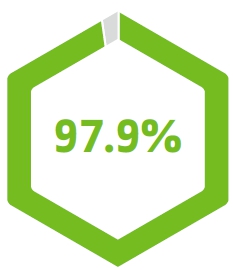 |
During 2024, the average Director participation in full Board and committee meetings on which they served was 97.9%. No Director attended less than 75% of the Board and committee meetings on which they served during the period of their service. |  |
All then-serving Huntington Directors attended the 2024 Annual Meeting of Shareholders, which was virtual. |
The independent Directors regularly meet in executive session in conjunction with standing Board meetings. They are also able to meet in executive session on other occasions throughout the year.
Director Onboarding and Continuing Education
Huntington provides robust onboarding for new Directors and comprehensive ongoing education and training for all Board members on key matters to foster Board effectiveness. In addition, all Board members are encouraged to participate in relevant external Director education opportunities, including forums facilitating engagement with other public company directors. The Board recognizes (i) the importance of continuous education and engagement, long-term value creation, and strengthening shareholder confidence and (ii) that institutional investors and regulators expect directors at public companies to continually enhance their skills and remain abreast of Company and industry matters.
Director onboarding involves a combination of written materials, presentations, and meetings with members of the Board and management. Among the topics typically covered during onboarding are Company history, strategy, revenue streams, risks, safety and soundness, and corporate governance. To assist new Directors in learning more about Huntington’s business, the onboarding process includes meetings with business segments and control and support groups. Various other activities are typically offered to new Directors, including tours of Huntington facilities and attending annual Huntington Live events. All of this is designed to allow new Directors to better step into their oversight roles and begin making meaningful contributions to the Board more quickly.
| Huntington Bancshares Incorporated 2025 Proxy Statement | 57 | |
 |
Corporate
Governance Board Practices, Policies, and Processes |
In-house educational sessions facilitated by management are provided to all Directors throughout the year with a focus on topics specific to the Company and the financial services industry. Continuing Director education may be provided in conjunction with Board and committee meetings and as standalone information sessions outside of meetings. Subjects covered may include:
 |
Shareholder base, engagement, and activism; |
 |
Capital planning and liquidity; |
 |
Campaign finance; |
 |
Corporate Responsibility developments and leading practices; |
 |
Bank Secrecy Act/Anti-Money Laundering issues; |
 |
Fair lending responsibilities; |
 |
Avoidance of UDAAP violations; |
 |
Information security and cyber risks, including tabletop exercises and artificial intelligence; and |
 |
Legal, regulatory, and supervisory requirements and trends applicable to Huntington. |
As appropriate, additional topics related to complex products, services, or lines of business that have the potential to significantly impact the Company and other topics as identified by the Board or executive management may also be covered. External experts and facilitators are also sometimes invited to attend meetings to discuss leading practices or issues germane to Huntington, the financial services industry, or public companies in general. Outside experts bring an array of experience and perspectives and foster dialogue among Board members on relevant topics. When there are in-person Board and committee meetings, the outside experts may also be invited to attend a Board dinner where they can engage informally with the Directors.
To assist with staying abreast of the latest developments, Huntington periodically provides Directors with external education opportunities covering a range of issues facing the Board. These external education opportunities are offered at various times of the year by professional organizations, educational institutions, and regulators at various facilities and locations and cover a range of important issues facing directors of financial institutions and/or public companies generally. Insights gained from external continuing education programs are shared with the full Board.
Codes of Ethics
Huntington’s Code of Conduct and Ethics, which is overseen by the NESG Committee, applies to all our colleagues and, where applicable, to our Directors and to colleagues and directors of our affiliates. Our colleagues serving as CEO, CFO, Corporate Controller, and Principal Accounting Officer are also bound by a Financial Code of Ethics for CEO and Senior Financial Officers. The Corporate Governance Guidelines, the Code of Conduct and Ethics, and the Financial Code of Ethics for CEO and Senior Financial Officers are posted on the Governance Documents page of our website at ir.huntington.com. Any amendments or waivers with respect to the Financial Code of Ethics for CEO and Senior Financial Officers would also be disclosed on our website.
We have also adopted a Service Provider Code of Conduct that sets forth our expectations with respect to service providers. Areas covered by the Service Provider Code of Conduct include ethical business practices, labor and human rights, health and safety, Corporate Responsibility, and privacy and confidentiality.
Stock Ownership Guidelines
The HRCC has established a minimum ownership level guideline for Directors based on five times the annual retainer fee for Directors at the time the requirement was adopted. Based on the retainer fee and the fair market value of our common stock on the date the guidelines were established, the guideline for Directors was set at 40,603 shares. Directors have five years to meet the minimum guidelines. Each Director who has served at least five years meets the guidelines.
| 58 | Huntington Bancshares Incorporated 2025 Proxy Statement | |
|
Corporate
Governance Our Executive Officers |
 |
Our Executive Officers
Each of our current executive officers is listed below along with a statement of their business experience during at least the last five years. Executive officers are elected annually by the Board. Ages are as of the 2025 Annual Meeting of Shareholders on April 16, 2025.
 |
STEPHEN D. STEINOUR, age 66, has served as the Chairman, President, and CEO of Huntington and as President and CEO of the Bank since January 14, 2009. Additional detail about Mr. Steinour’s business experience is set forth under Proposal 1 — Election of Directors. | |
 |
AMIT DHINGRA, age 51, became a member of the ELT as of March 2024. He has served as Executive Vice President and Chief Enterprise Payments Officer of Huntington since March 2024, and he was previously Executive Vice President and Head of Enterprise Payments of Huntington from July 2022 through February 2024. Prior to that position, Mr. Dhingra was Executive Vice President and Head of Retail Payments & Consumer Lending from November 2020 to June 2022, and Executive Vice President and Head of Retail Payments from October 2018 to November 2020. Prior to joining Huntington, Mr. Dhingra held various leadership positions at U.S. Bancorp. | |
 |
MARCY C. HINGST, age 51, became a member of the ELT as of October 2023. She has served as Senior Executive Vice President and General Counsel of Huntington since that date. Ms. Hingst’s responsibilities also include the Office of the Corporate Secretary, Government Relations, Corporate Insurance, and Corporate Responsibility. Prior to joining Huntington, Ms. Hingst served in multiple leadership roles at Bank of America Corporation from 2005 to 2023, including most recently serving as the Global Anti-Money Laundering Executive and Chief Risk Officer for the for the Wealth Management division, from September 2021 to October 2023. Prior to that position, Ms. Hingst served as the Chief Risk Officer for the Consumer and Wealth Management divisions, from April 2019 to September 2021 and Deputy General Counsel for the Consumer division starting in April 2017. | |
 |
HELGA S. HOUSTON, age 63, became a member of the ELT as of September 2011. She has served as Senior Executive Vice President and CRO of Huntington since January 2012, and as Senior Executive Vice President in Corporate Risk from September 2011 through December 2011. Prior to joining Huntington, Ms. Houston served in a variety of business and risk capacities with Bank of America Corporation. | |
 |
SCOTT D. KLEINMAN, age 55, became a member of the ELT as of May 2020. He has served as Senior Executive Vice President and President, Commercial Banking, of Huntington since July 2022. He was previously Senior Executive Vice President and Co-President of Commercial Banking from June 2021 to June 2022, following the TCF Merger. Prior to that position, Mr. Kleinman served as Senior Executive Vice President and Director of Commercial Banking of Huntington from April 2020 to June 2021, and he previously served as Executive Managing Director of Huntington Capital Markets and has held a variety of senior leadership roles in Huntington’s Capital Markets and institutional banking business. He joined Huntington in 1991 and has served in a variety of leadership positions during his tenure with increasing responsibility. | |
 |
KENDALL A. KOWALSKI, age 56, became a member of the ELT as of March 2024. He has served as Executive Vice President and Chief Information Officer of Huntington since February 2014. Prior to joining Huntington, Mr. Kowalski served in various leadership positions with increasing supervisory and management responsibilities in the cybersecurity and information & technology space at JPMorgan Chase & Co. | |
 |
BRENDAN A. LAWLOR, age 55, became a member of the ELT as of January 2024. He has served as Executive Vice President and Chief Credit Officer of Huntington since January 2024, and Executive Vice President and Deputy Chief Credit Officer of Huntington from April 2019 through December 2023. Prior to joining Huntington, Mr. Lawlor served in various leadership positions at KeyCorp. | |
 |
TIMOTHY W. MILLER, age 42, became a member of the ELT as of October 2024. He has served as Executive Vice President and Chief Communications Officer of Huntington since August 2024. Prior to joining Huntington, Mr. Miller served as Senior Vice President of External and Financial Communications for The PNC Financial Services Group, Inc. from June 2022 to July 2024. Prior to that position, Mr. Miller served as a Senior Vice President for Communications at Bank of America Corporation from March 2019 to July 2022, including as Head of CEO Content and Priorities from July 2020 to June 2022. Prior to that position, Mr. Miller held communications leadership roles at Brighthouse Financial Incorporated and 3D Systems Corporation. |
| Huntington Bancshares Incorporated 2025 Proxy Statement | 59 | |
 |
Corporate
Governance Corporate Responsibility |
 |
PRASHANT NATERI, age 52, became a member of the ELT as of March 2024. He has served as Executive Vice President and Chief Corporate Operations Officer of Huntington since March 2024. He was previously Executive Vice President and Chief Transformation Officer from November 2021 through February 2024, Executive Vice President, Consumer & Business Banking Sales, Operations & Business Management, from July 2021 to November 2021, Senior Vice President, Consumer & Business Banking Sales, Operations & Business Management, from November 2018 to July 2021, and various other positions of increasing responsibility. Prior to joining Huntington, Mr. Nateri held various leadership positions at JPMorgan Chase & Co. | |
 |
SARAH E. POHMER, age 49, became a member of the ELT as of August 2024. She has served as Senior Executive Vice President and CHRO since August 2024, and she was previously the incoming Senior Executive Vice President and CHRO since May 2024. Prior to joining Huntington, Ms. Pohmer served as Managing Director, Head of Human Resources for Consumer Bank, for JPMorgan Chase & Co. from July 2022 to May 2024 and Managing Director, Head of Human Resources for Card and Connected Commerce, for JPMorgan Chase & Co. from October 2021 to July 2022. She also served as Head of Human Resources for Business Banking and Consumer and Community Banking support functions from July 2011 to October 2021. Prior to that, Ms. Pohmer held a variety of human resource leadership positions at JPMorgan Chase & Co. since 2000. | |
 |
BRANT J. STANDRIDGE, age 49, became a member of the ELT as of April 2022. He has served as Senior Executive Vice President and President of Consumer and Regional Banking of Huntington since April 2023, and he previously served as Senior Executive Vice President of Consumer and Business Banking of Huntington from April 2022 through March 2023. Prior to joining Huntington, Mr. Standridge served as Chief Retail Community Banking Officer for Truist Financial Corporation beginning in December 2019 after the closing of the merger between BB&T Corporation and SunTrust Banks, Inc. Previously, he served as President of Community Bank Retail and Consumer Finance Businesses at BB&T Corporation beginning in October 2018. | |
 |
ZACHARY J. WASSERMAN, age 50, became a member of the ELT as of November 2019. He has served as Senior Executive Vice President and CFO of Huntington since November 2019. Prior to joining Huntington, Mr. Wasserman served as Senior Vice President and CFO for Visa, Inc. North America and Global Visa Consulting and Analytics since March 2016. From March 2012 to March 2016, he was Senior Vice President and CFO for U.S. Consumer Services & Global Consumer Travel with American Express Company. | |
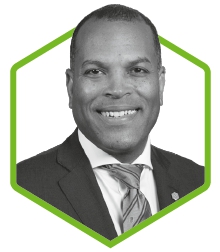 |
DONNELL R. WHITE, age 48, became a member of the ELT as of October 2023. He has served as Senior Vice President and Chief Diversity, Equity and Inclusion Officer, since October 2023, and Senior Vice President and Regional Diversity, Equity and Inclusion Director, from June 2021 to October 2023. Previously, Mr. White served as Chief Diversity Officer and Director of Strategic Partnerships of TCF Financial Corporation, from August 2019 to June 2021, and Chief Diversity Officer and Director of Strategic Partnerships of Chemical Financial Corporation, from June 2018 until its merger with TCF Financial Corporation in August 2019. He also served as Executive Director of the Detroit Branch of the National Association for the Advancement of Colored People, from March 2001 to June 2018. |
Corporate Responsibility
With oversight from the Board, Huntington focuses on issues important to our business and stakeholders, and our commitment to doing the right thing for all of our constituents serves as a strategic driver for growth.
The responsible way in which we operate our Company enables us to live Our Purpose of making people’s lives better, helping businesses thrive, and strengthening the communities we serve. We use the platform of Corporate Responsibility to help describe and report on the work we do every day to deliver value for our stakeholders.
As a public company, our economic impact begins with our commitment to creating sustainable, long-term shareholder value through top-tier performance, while maintaining an aggregate moderate-to-low risk appetite and a well-capitalized position.
As a regional bank, our economic impact includes helping individuals and families reach their goals of financial stability and homeownership; providing businesses, especially small and mid-sized businesses, with the resources to grow; serving and supporting the underbanked and working in partnership to create more prosperous and resilient communities.
Because we believe “purpose drives performance,” our enterprise commitment to Corporate Responsibility is closely integrated with our core performance objectives. Led by executive management, we have adopted a performance management framework that incorporates governance, strategy, and operations grounded in the considerations that we believe are most important to our stakeholders. This framework ensures that we formalize and standardize our approach to integrating responsible business practices into our Board and executive management decision-making and business strategy. Additionally, we are guided by our Stakeholder Prioritization Assessment, which we are refreshing in 2025 and has helped us focus our reporting on the topics of most importance to our stakeholders and business.
Corporate Responsibility Reporting
This Proxy Statement provides only a high-level overview of our Corporate Responsibility initiatives. Our 2024 Corporate Responsibility Report and 2024 Climate Report will be issued later this year, which will be available on the Investor Relations pages of Huntington’s website at ir.huntington.com. None of the reports referenced herein are a part of, or incorporated by reference into, this Proxy Statement.
| 60 | Huntington Bancshares Incorporated 2025 Proxy Statement | |
|
Corporate Governance Corporate Responsibility |
 |
Governance and Reporting
This commitment to Corporate Responsibility and the move towards the adoption of a Corporate Responsibility platform is integrated with our core performance objectives, and our performance management framework integrates our most significant Corporate Responsibility considerations into relevant Board committee agendas for discussion, awareness, and governance actions. The following represents how Corporate Responsibility is overseen and integrated throughout the Company:
| BOARD OF DIRECTORS |
| NESG Committee | Audit Committee |
Community Development Committee |
HRCC | Technology Committee |
Risk Oversight Committee |
|||||
 |
||||||||||
| CEO/EXECUTIVE LEADERSHIP TEAM | ||||||
| Risk Management Committee | Disclosure Review Committee | Credit Policy & Strategy Committee | Legal, Regulatory, and Compliance Committee | |||
 |
||||||
| COLLEAGUE WORKSTREAMS THAT INTEGRATE INTO THE CORPORATE RESPONSIBILITY STRATEGY |
|
Corporate
Responsibility Responsibilities include:
|
Corporate
Responsibility Responsibilities include:
|
Climate
Risk Management Responsibilities include:
|
Other Working Groups:
|
Each of the Board-level committees provide oversight of Corporate Responsibility matters as it pertains to their specific areas of expertise and focus. Further, Corporate Responsibility is incorporated throughout management’s risk management structure, which includes specific working groups, teams, councils, and committees focused on Corporate Responsibility.
| Huntington Bancshares Incorporated 2025 Proxy Statement | 61 | |
 |
Corporate Governance Corporate Responsibility |
Human Capital and Inclusion
Having a workforce that reflects our communities helps us understand and meet the needs of our customers. Maintaining a caring and inclusive culture enables our colleagues to perform at their best. We work every day to create a workplace that helps us attract, develop, and retain the best talent for Huntington—so that we can deliver for our customers and win in the market. We seek a workforce representative of the communities that we serve.
Huntington aspires to be a Category of One financial services institution: an organization that uniquely combines its culture and performance. We continuously seek ways to elevate our colleagues’ experience as we strive to become a destination employer, and we have developed a comprehensive talent management program that emphasizes developing, engaging, retaining, and attracting the best talent. We believe our Company’s Values of can-do attitudes, forward-thinking minds, and service hearts are central to our identity and reflect how we foster an inclusive environment, empowering all colleagues to grow their talents and help Huntington meet its strategic goals.
Community Development and Philanthropy
We are committed to delivering sustainable, long-term shareholder value through financial performance, while maintaining an aggregate moderate-to-low risk appetite and a well-capitalized position. We align our corporate strategy to Our Purpose of helping others and building upon our market-leading, purpose-driven bank through focused efforts on the environmental and social issues most important to our business and our stakeholders. Through the connections we make, we help our customers manage and control their finances and their livelihoods, and these connections help us better understand the needs of our customers and the communities we serve.
Environmental
Huntington supports environmental stewardship, reflecting our commitment to mitigating the effects of climate change and reducing our reliance on natural resources. We continue to report our progress by regularly updating our environmental disclosures with multiple external raters. Our 2023 Climate Report provides an update on our emissions reduction efforts. We have made significant investments in environmental reporting and climate risk to prepare for enhanced regulatory expectations and changing environmental conditions. Our 2024 Corporate Responsibility Report and 2024 Climate Report will be issued later this year.
Stakeholder Prioritization Assessment
To help ensure our Corporate Responsibility commitments and initiatives align to our stakeholders’ priorities, Huntington is refreshing its Stakeholder Prioritization Assessment in 2025 and using a third-party consultant. You can read more about our existing (or current) Stakeholder Prioritization Assessment by reviewing our prior Corporate Responsibility Reports. We are refreshing this Assessment in 2025 to help validate that we continue to be aligned with our key stakeholders.
In addition to the periodic stakeholder assessments, another avenue we use to learn about the importance of various Corporate Responsibility topics is through our shareholder outreach that takes place throughout the year. Information about some of this year’s topics discussed during these engagements can be found under the Shareholder Outreach and Engagement subsection.
| 62 | Huntington Bancshares Incorporated 2025 Proxy Statement | |
|
Corporate
Governance Government Relations |
 |
Government Relations
An important part of Huntington’s commitment to community includes active participation in the civic and political processes that impact the lives of our customers, shareholders, and colleagues. Huntington’s Government Relations team manages all of the public affairs activities of the Company to support Huntington’s business operations and our ability to serve our customers and communities.
Political Action Committee Contributions
HBI-PAC, Huntington’s political action committee, makes bipartisan campaign contributions in compliance with local, state, and federal election laws. All HBI-PAC funds are voluntary donations from eligible colleagues. HBI-PAC supports political candidates and committees that believe in and encourage a thriving business environment in which Huntington can strengthen our communities, serve our customers, and support our colleagues and shareholders. The Company’s PACs are overseen by a PAC board of directors—a steering committee comprised of Regional Presidents and business segment executives across the Company. The Company’s PACs are administered by Government Relations department staff and are managed in compliance with applicable local, state, and federal laws, as well as Our Purpose, Vision, Values, and Ambitions. HBI-PAC contributions are publicly available at www.fec.gov (Committee ID C00165589) and on the websites of respective state election authorities. No corporate funds are contributed to HBI-PAC.
Company Contributions
Huntington does not use corporate funds, either directly or indirectly, for election-related contributions to political candidates, political parties, or candidate committees, including super PACs or independent expenditure committees. Huntington contributes on occasion to local/state issue and levy campaigns, which support the interests of our communities and the Company. These contributions are made infrequently, and when made, are publicly reported in alignment with Company policy and applicable law and are approved by senior management independent of individual political beliefs.
Trade Association Membership
Huntington participates in a number of trade associations representing the interests of the financial services industry and the broader business community. These trade associations represent their respective memberships and advocate on policy issues and initiatives important to those constituencies. Membership benefits include deeper engagement across our communities, business opportunities, and effective advocacy on behalf of the industry. Trade association membership comes with an understanding that Huntington may not always agree with the legislative positions of the organization or its other members.
We make our political spending available through our website at ir.huntington.com.
| Huntington Bancshares Incorporated 2025 Proxy Statement | 63 | |
 |
Compensation of Executive Officers
| Proposal 2 Advisory Approval of Executive Compensation | ||
|
Our executive compensation program emphasizes performance-based compensation, particularly long-term incentives. We continually strengthen our compensation practices based on our philosophy, market best practices, and feedback received from shareholders. We believe that our compensation policies and procedures strongly align the interests of executives and shareholders. We encourage our executives to focus on long-term performance through long-term incentives and stock ownership requirements. We further believe that our culture focuses executives on sound risk management and appropriately rewards executives for performance. The resolution set forth below gives shareholders the opportunity to vote on the compensation of our executives. Pursuant to Section 14A of the Exchange Act and upon the recommendation of the Board, we ask shareholders to consider and vote to adopt the following resolution: “RESOLVED, that the compensation paid to the named executive officers of Huntington Bancshares Incorporated as disclosed in this proxy statement pursuant to Item 402 of Regulation S-K, including in the Summary Compensation Table, the Compensation Discussion and Analysis, the additional compensation tables, and the accompanying narrative disclosure, is hereby approved on an advisory, non-binding basis.” Because this is an advisory vote, it will not bind the Board; however, the HRCC will take into account the outcome of the vote when considering future executive compensation arrangements. Shareholders are provided with an annual opportunity to vote on executive compensation. Accordingly, the next advisory vote to approve our executive compensation program will occur at the 2026 Annual Meeting. |
 The Board recommends a vote FOR the adoption of the resolution regarding executive compensation, as set forth herein. |
|
| 64 | Huntington Bancshares Incorporated 2025 Proxy Statement |
|
Compensation of Executive Officers Compensation Discussion & Analysis |
 |
Compensation Discussion & Analysis
Table of Contents
Executive Overview
Our compensation philosophy is to pay for performance that creates long-term shareholder value. The HRCC’s 2024 compensation program for executive officers emphasized performance-based compensation designed to drive profitable growth and returns within our aggregate moderate-to-low risk appetite while doing the right thing for our colleagues, customers, communities, and shareholders.
Named Executive Officers
This CD&A describes Huntington’s executive compensation program for 2024 for our CEO, CFO, and the additional executive officers named in the Summary Compensation Table (the NEOs), which include:
 |
 |
 |
 |
 |
||||
| Stephen D. Steinour | Zachary J. Wasserman | Brant J. Standridge | Marcy C. Hingst | Scott D. Kleinman | ||||
| Chairman, President, and CEO | Chief Financial Officer Senior Executive Vice President |
President, Consumer and Regional Banking Senior Executive Vice President | General Counsel Senior Executive Vice President | President, Commercial Bank Senior Executive Vice President |
| Huntington Bancshares Incorporated 2025 Proxy Statement | 65 | |
 |
Compensation of Executive Officers Compensation Discussion & Analysis |
Our Approach to Executive Compensation
Our Purpose, Our Vision, Our Ambitions:
 |
Our Purpose is to make people’s lives better, help businesses thrive, and strengthen the communities we serve. |
 |
Our Vision is to become the leading People-first, Customer-centered bank in the country. |
 |
Our Ambitions are to be the most Trusted financial institution, have the most Caring and Inclusive Culture, be an Indispensable Partner for customers and communities, and deliver Value through top quartile core performance. |
 |
We manage the Company to create shareholder value over the long term through consistent, disciplined performance. |
Our compensation program seeks to align Our Purpose, Our Vision, and Our Ambitions by ensuring a significant portion of compensation is stock-based and long-term in focus. A critical foundation of our executive compensation philosophy is the requirement to own Huntington common stock, which aligns management’s interests with those of shareholders. We believe that this is an area where our CEO should lead by example, by having set a stock ownership requirement at an industry-leading 10X annual base salary.
2024 Executive Compensation Elements
In 2024, the HRCC maintained the essential design of our 2023 compensation program, except that beginning in 2024, the Company phased out the PSU award modifier, which provided up to a 20% multiplier for new revenue earned incremental to the budget. The new revenue multiplier was originally implemented to drive and capture new sources of revenue not envisioned in strategic initiatives when the PSU was granted. Those strategic initiatives identified through this process have now been incorporated into regular revenue streams accounted for in our annual budget. The target total compensation mix below illustrates the emphasis on variable, at-risk incentive-based compensation. Fixed compensation consists of base salaries. Variable, incentive-based compensation includes our annual incentive payouts, the target value of PSUs, and the grant date fair value of RSUs.
| Target Compensation Mix | ||||||
| CEO | Other NEOs(1) | Description | ||||
| Base Salaries | ||||||
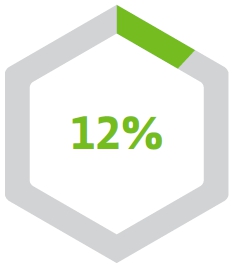 |
 |
Fixed component representing 12% of aggregate total target compensation for our CEO and 22% for our other NEOs | ||||
| Annual Incentive Plan (MIP) | ||||||
 |
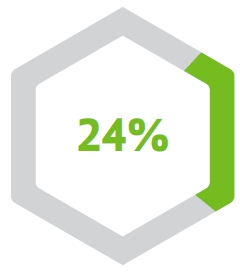 |
 |
Annual performance-based compensation based on:  EPS(2)  PPNR Earnings Growth(2)  Operating Leverage(2) |
|||
| Long-Term Incentive Plan (LTIP) | ||||||
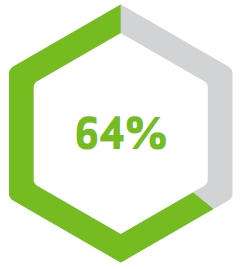 |
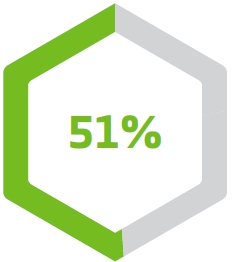 |
Awards of long-term incentive (LTI) grants comprised of:  PSUs (55% for CEO, 50% for other NEOs; based on Relative and Absolute ROTCE(2))(3)  RSUs (45% for CEO, 50% for other NEOs) |
||||
| (1) | Represents an average of annualized base salaries. For additional detail, see 2024 Compensation Decisions for Each Named Executive Officer below. | |
| (2) | Non-GAAP, see Appendix A to this proxy statement for more information. | |
| (3) | Beginning in 2025, PSUs comprise 60% of total annual LTI grant value for CEO and 55% for the other NEOs. | |
| 66 | Huntington Bancshares Incorporated 2025 Proxy Statement | |
|
Compensation of Executive Officers Compensation Discussion & Analysis |
 |
The Company’s 2024 performance was reviewed in accordance with the MIP and certified by the HRCC in January 2025. Consistent with prior years, the 2024 results included positive or negative adjustments for “extraordinary events.” Huntington’s performance against the three MIP metrics (EPS, PPNR Earnings Growth, and Operating Leverage) was 105.2% of target.
Strong Financial and Operational Performance of Compensation Metrics
| Strategic Business Objective | Compensation Component or Metric | 2024 Actual Results | ||
| Aligning pay with performance |
Adjusted EPS Performance measure for annual incentive |
$1.25(1) | ||
| Focusing on quality revenue |
Adjusted PPNR Earnings Growth Performance measure for annual incentive |
2.04%(1) | ||
| Managing expense growth |
Adjusted Operating Leverage Performance measure for annual incentive |
4.2%(1) | ||
| Achieving long-term profitable growth and returns |
Adjusted ROTCE Performance measure for performance share units |
16.0%(1) |
| (1) | Non-GAAP, see Appendix A to this proxy statement for more information. |
Risk Management Culture
The HRCC’s oversight responsibility includes the relationship among risk takers, risk management, and compensation. We regularly monitor our incentive arrangements for colleagues at all levels, and we strive to enhance incentive risk management in light of developing best practices and regulatory guidance. For additional detail, see Risk Assessment of Incentive Compensation below.
Integrity is at the heart of our organizational identity, and we require that all of our colleagues follow both the letter and intent of our Code of Conduct and Ethics. Colleagues at all levels in the organization are also subject to our robust Misconduct Recoupment Policy, which serves as a tool to recover vested or unvested incentive compensation in applicable situations. In general, situations that trigger a review under this policy involve misconduct or behaviors or actions outside the bounds of the Company’s overall risk appetite and governance structure. The HRCC is responsible for making any compensation recoupment determination with respect to executive officers. Our executive officers are also subject to our Financial Restatement Compensation Recoupment Policy, adopted in October 2023. Pursuant to this policy, any incentive-based compensation received by covered executive officers granted, earned, or vested based on a financial reporting measure that was restated can be recouped. See below under Recoupment of Incentive Compensation for additional details.
Long-Term Focus
Huntington’s compensation program for executives is long-term focused and aligns the interests of our executives with those of our shareholders. Long-term incentives make up the most significant portion of total NEO compensation, a majority of the aggregate value of which consists of performance-based awards, and we combine that with our robust stock ownership requirements.
The Importance of Stock Ownership
Huntington is committed to a culture of stock ownership, which aligns management’s interests with those of shareholders. The requirement to own Huntington common stock is a critical foundation of our executive compensation philosophy and applies to our ELT as well as to our next level executives by salary grade. Mr. Steinour’s commitment to this principle, and to the Company, is evidenced by his significant personal investment in Huntington through his ownership of Huntington common stock. Currently, Mr. Steinour owns significantly more Huntington common stock than our industry-leading 10X salary ownership requirement for the CEO. Each other ELT member at the senior executive vice president level, including each of our NEOs, has an ownership guideline of 3X their salary. See additional detail under Stock Ownership Requirements.
| Huntington Bancshares Incorporated 2025 Proxy Statement | 67 | |
 |
Compensation of Executive Officers Compensation Discussion & Analysis |
Highlights of 2024 Performance and Impact on Executive Compensation
Putting Our Purpose Into Action
 |
We grew average loans and leases by $3.6 billion, or 2.9% year-over-year, and average total deposits by $7.7 billion, or 5.2% year-over-year. |
 |
We executed on our long-term growth strategy to expand our capabilities and expertise into new geographies, including the Carolinas and Texas, and new commercial verticals. |
 |
We progressed in strategic payment capability and expertise growth, including new merchant acquiring, expanded treasury management solutions, new card products, and augmented partnerships. |
 |
We achieved strong credit performance through rigorous client selection and portfolio management aligned with our aggregate moderate-to-low risk appetite and continued disciplined expenses management. |
 |
We continued our strong track record of service and customer experience, ranking Highest in Customer Satisfaction with Retail Banking in Pennsylvania for the second consecutive year in the J.D. Power in 2024 U.S. Retail Banking Satisfaction Study.(1) For the second consecutive year, Huntington received the top ranking in Overall Dealer Satisfaction for Non-Captive Regional – Prime segment in the J.D. Power 2024 U.S. Dealer Financing Satisfaction Study.(2) |
 |
We are the #1 SBA lender in the United States by volume for the seventh year in a row. |
 |
We continued to receive recognition for our colleague-focused efforts as an employer and were once again certified as a Great Place to Work for the sixth consecutive year. |
| (1) | Huntington received the highest score in Pennsylvania (2024) in the J.D. Power U.S. Retail Banking Satisfaction Studies of customers’ satisfaction with their primary bank. Visit jdpower.com/awards for more details. |
| (2) | Huntington received the highest score in the Overall Dealer Satisfaction for Non-Captive Regional – Prime segment (2024) in the J.D. Power 2024 U.S. Dealer Financing Satisfaction Study. Visit jdpower.com/awards for more details. |
| Total Shareholder Return (TSR) |
Total Revenue(1) |
Total Assets as of December 31, |
||
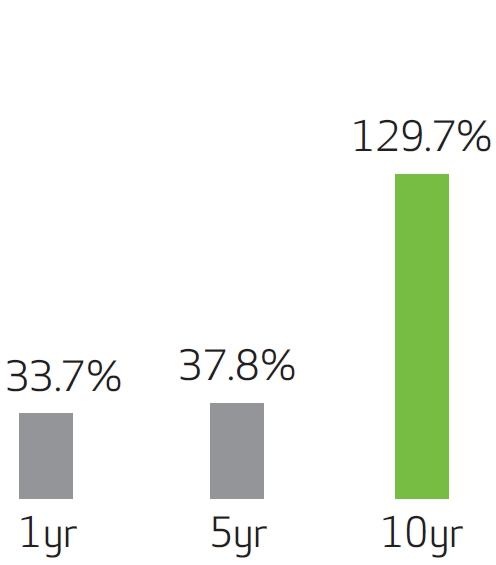 |
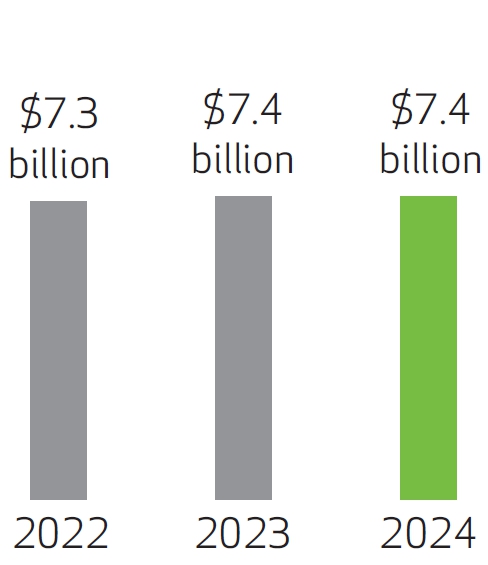 |
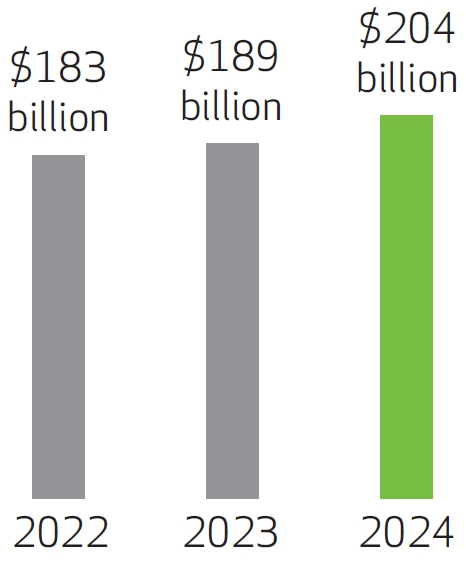 |
||
| (1) | On a fully-taxable equivalent (FTE) basis assuming a 21% tax rate. |
See the Proxy Summary section for additional information about our strategy.
| 68 | Huntington Bancshares Incorporated 2025 Proxy Statement | |
|
Compensation of Executive Officers Compensation Discussion & Analysis |
 |
2024 Highlights
 |
EPS of $1.22. |
 |
Total revenue increased 0.5% to $7.4 billion.(1) |
 |
Total assets increased 8% to $204 billion at December 31, 2024 from $189 billion at December 31, 2023. |
 |
Period-end total loans increased $8.1 billion, or 6.6%, year-over-year. |
 |
Period-end total deposits increased $11.2 billion, or 7.4%, year-over-year. |
 |
Year-end dividend yield of 3.8% based on last paid dividend rate. |
| (1) | On a fully-taxable equivalent (FTE) basis assuming a 21% tax rate. |
Pay for Performance Alignment
Our objective is to pay for performance that creates long-term shareholder value. Our track record of paying for performance continued in 2024.
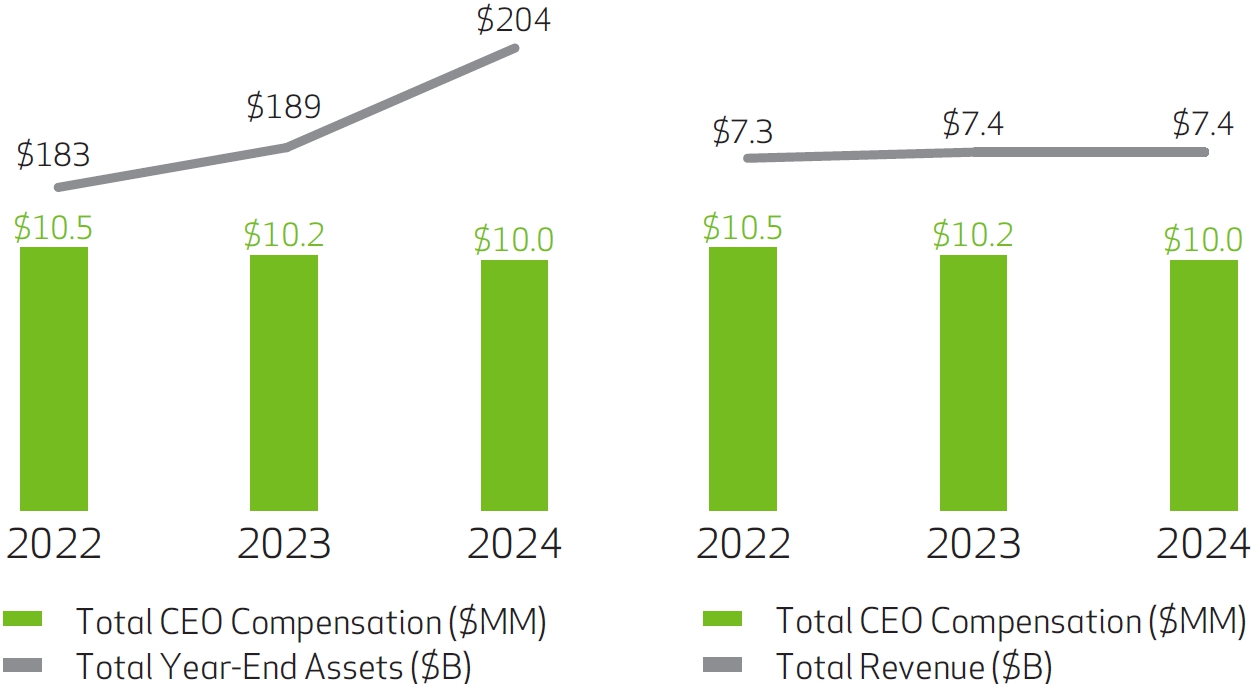
Consideration of “Say-on-Pay”/Shareholder Outreach
At our 2024 Annual Meeting, 86.9% of votes cast were in favor of our “say-on-pay” advisory vote, and that support has averaged approximately 92% at annual meetings held in the last five years.
During 2024, we continued our outreach to shareholders, extending invitations to investors collectively owning over 58% of our outstanding common stock, and held meetings on a variety of topics with investors owning in the aggregate approximately 25% of our common stock as of December 31, 2024.
Based on the “say-on-pay” votes and investor feedback received, the HRCC utilized similar compensation metrics in 2024. We continue to monitor emerging trends and best practices and seek ways to enhance our compensation programs as part of our ongoing mission to continually strengthen our compensation practices based on our philosophy, market best practices, and feedback received from shareholders throughout the year.
| Huntington Bancshares Incorporated 2025 Proxy Statement | 69 | |
 |
Compensation of Executive
Officers Compensation Discussion & Analysis |
Executive Compensation Program Features
Our Business and Our Compensation Philosophy
Philosophy and Decision-Making Process
We provide a balanced total compensation package for executive officers that includes both fixed and variable performance-based elements. Our compensation philosophy is to pay for performance that we believe creates long-term shareholder value while balancing risk and reward through a mix of base pay, short-term incentives, and long-term incentives, with greater emphasis on long-term incentives. The use of both short-term and long-term incentives ensures that the ultimate compensation delivered reflects achievement of our annual business goals as well as delivery of long-term shareholder value. Our performance and evaluation process considers corporate, business segment, and performance relative to industry peers. We also consider individual performance, including performance on Human Capital metrics that encompass our People Leader Quotient (PLQ). The PLQ is based on a combination of quantitative and qualitative measures and is intended to drive strong people-leader behaviors to drive performance and the development of an inclusive workplace.
Our target pay levels are designed to be competitive with market practices in order to engage, develop, retain, and attract colleagues in a competitive labor market. Because a majority of our pay is variable and based on performance, our actual pay positioning will vary appropriately to reflect actual performance. We also maintain robust stock ownership requirements for executives in order to further ensure alignment of our compensation program with the long-term interests of our shareholders.
While overall compensation policies generally apply to all executives, we recognize the need to differentiate compensation by individual, performance, experience, and relative contributions. Base salaries and incentive targets are the primary means for differentiating compensation opportunities to reflect executive role and scope of responsibility.
| Guiding Principles | ||
| Focus on long-term shareholder alignment | A significant portion of compensation is stock-based and long-term in focus. We maintain robust stock ownership requirements for our CEO and other executives. | |
| Balanced and holistic approach | Our program includes fixed and performance-based elements, short-term and long-term performance incentives, and considers corporate, business segment, individual, and relative performance. | |
| Align pay and performance | Total compensation is expected to vary each year in line with our performance and key objectives over the long-term. | |
| Maintain an aggregate moderate-to-low risk appetite |
We
monitor our programs, controls, and governance practices for consistency with our aggregate
moderate-to-low risk appetite.
See Risk Assessment of Incentive Compensation
|
|
| Assure appropriate positioning in the market | Our target pay levels are designed to be competitive with market practice. | |
| Reflect internal equity | We differentiate compensation by individual, reflecting their role, experience, performance, and expected contributions. |
Reinforcing Our Values
In addition to rewarding executive officers for achievement of financial goals, the HRCC applies its discretion to reinforce behaviors and values that contribute to the Company’s long-term success. Our Values and Our Purpose work together to guide how we develop our business strategy and achieve our goals. Our colleagues are our most important asset and the key to fulfilling Our Purpose to make people’s lives better, help businesses thrive, and strengthen the communities we serve. Performance reviews for all colleagues focus equally (50-50) on WHAT a colleague does (goals) and HOW a colleague does it (behaviors supporting our Values). For executives, including our NEOs, this includes utilizing the PLQ to evaluate their performance on Human Capital metrics. This balanced focus is intended to encourage expected behaviors consistent with Our Values in support of Our Purpose.
| 70 | Huntington Bancshares Incorporated 2025 Proxy Statement | |
|
Compensation
of Executive Officers Compensation Discussion & Analysis |
 |
Key Compensation and Governance Practices
The foundation of our executive compensation program is a philosophy of maintaining responsible governance and practices that align the interests of our executives with those of our shareholders. This guiding principle provides us with the framework from which we built our compensation program, and which continues to inform its continuous improvement. Below are some examples of how we ensure that our compensation program achieves our corporate goals and aligns with our compensation philosophy:
| What We Do | |
 |
Significant stock ownership policy applicable to executive officers and next level executives receiving equity awards to reinforce alignment between shareholders and senior management |
 |
Significant emphasis on performance-based compensation, with the majority dependent upon long-term performance |
 |
Balanced portfolio of metrics that drive annual and long-term goals in a risk appropriate manner |
 |
All incentive compensation, including vested and paid compensation, is subject to robust recoupment policies that allow us to recover certain vested or unvested incentive compensation in the event of inappropriate risk taking or a financial restatement |
 |
PSUs comprise 55% of total annual LTI grant value for CEO and 50% for other NEOs for 2024(1) |
 |
Annual equity-based awards made on a pre-established date to avoid any appearance of coordination with the release of material non-public information |
 |
Independent compensation consultant provides expert guidance and support to the HRCC |
 |
Shareholder engagement to exchange viewpoints with our investors |
 |
Annual assessment of compensation programs to compare them to those of our peers and market best practices |
 |
Limited perquisites representing a small component of compensation |
 |
Annual risk assessment of incentive compensation plans |
| What We Don’t Do | |
 |
No repricing of previously-granted stock options without shareholder approval |
 |
No perquisite or excise tax gross-ups upon change in control |
 |
No single-trigger vesting of equity awards upon change in control |
 |
No hedging or pledging of Huntington securities by executives or Directors |
 |
No dividend or dividend equivalents paid on equity grants prior to vesting |
 |
No incentive plans encourage excessive risk-taking |
| (1) | Beginning in 2025, PSUs comprise 60% of total annual LTI grant value for CEO and 55% for the other NEOs. |
Risk Assessment of Incentive Compensation
The HRCC oversees the Company’s compensation policies and practices and the relationship among risk, risk management, and compensation. The HRCC’s oversight is supported by the Incentive Compensation Oversight Committee (the “Oversight Committee”), an executive-level management committee. The Oversight Committee consists of senior leaders from Human Resources, Finance, Legal, Credit Administration, and Risk Management and is co-chaired by the CHRO and the CRO; the Chief Auditor is a member ex-officio. The Oversight Committee reports directly to the HRCC.
Under the direction of the Oversight Committee, Huntington performs an annual risk assessment of its incentive plans and reports the results to the HRCC. Aided by an independent third-party consultant, the review includes economic analysis and evaluation of plan design features, risk balancing mechanisms, governance policies and practices, and adherence to incentive compensation guiding principles developed by the Oversight Committee. A key tool for managing incentive compensation risk is an annual enterprise-level significant risk events review process directed by the CRO. This year-end significant risk events review may result in incentive payment reductions where warranted.
| Huntington Bancshares Incorporated 2025 Proxy Statement | 71 | |
 |
Compensation of Executive
Officers Compensation Discussion & Analysis |
Huntington uses a variety of plan design features to balance risk and reward. Governance policies and practices also play an important role in managing incentive plan risk. We regularly monitor our incentive compensation arrangements for colleagues at all levels and strive to enhance our risk review in light of developing best practices and regulatory guidance. The HRCC receives in-depth reviews of select business unit incentive plans they choose or that are recommended by management for review.
| Key broad-based incentive plan design features and controls include: | Other features and controls used in various plans include: | |
|
Recoupment provisions
Management discretion to reduce or eliminate awards
Annual risk-based review of plans and awards |
Multiple performance criteria, including corporate, business unit, and individual performance criteria
Risk-related performance criteria
Payment caps
Deferrals paid over time |
|
Balancing Risk and Reward for Executive Officers
For executive officers, our compensation philosophy balances risk and reward with a mix of base pay, short-term incentives, and long-term incentives, with greatest emphasis on long-term incentives. We maintain robust stock ownership guidelines for executives. Our Misconduct Recoupment Policy covers all colleagues and our Financial Restatement Compensation Recoupment Policy, adopted in October 2023, covers our executive officers. In addition, the Board retains discretion to reduce or eliminate incentive awards for executive officers. See below under Recoupment of Incentive Compensation for additional details.
Components of 2024 Compensation
The HRCC’s 2024 compensation program for executive officers emphasized performance-based compensation designed to drive profitable growth and returns within our aggregate moderate-to-low risk appetite, while doing the right thing for our colleagues, customers, communities, and shareholders. The three primary components of executive compensation are base salary, annual incentive awards, and equity-based long-term incentive awards. Benefits make up a smaller component of overall pay. The purpose and features of each component are summarized below.
| 72 | Huntington Bancshares Incorporated 2025 Proxy Statement | |
|
Compensation
of Executive Officers Compensation Discussion & Analysis |
 |
|
CEO Targeted Direct Compensation |
Other NEO Targeted Direct Compensation (Average) |
Purpose and Key Features | |||||
| Base Salary | |||||||
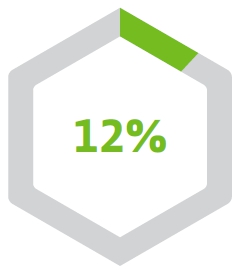 |
 |
Set within a competitive range of market practices to attract and retain top talent | |||||
| Varies depending upon the executive’s role, performance, experience, and contribution | |||||||
| Foundation from which incentives and other benefits are determined | |||||||
 |
Annual Incentive (MIP) | ||||||
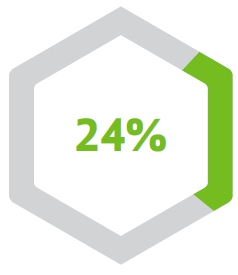 |
 |
Motivates and rewards for achieving or exceeding annual strategic financial and operational goals that ultimately support sustained long-term profitable growth and value creation | |||||
| Reflects Company performance on key measures, adjusted for business unit and individual performance, including risk management | |||||||
| Target opportunity expressed as a percentage of base salary reflective of each NEO’s role | |||||||
| Tied directly to performance in year for which reported | |||||||
| Awards are paid in cash | |||||||
| Long-Term Incentive (Equity Grants) | |||||||
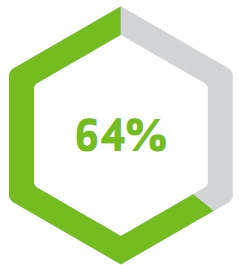 |
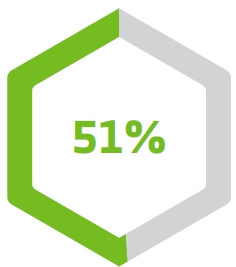 |
Motivates and rewards for delivering long-term sustained performance aligned with shareholder interests while encouraging retention | |||||
| Grants are comprised of PSUs and time-based RSUs | |||||||
| Awards are based on multiple factors, including competitive market data, overall Company performance, business segment performance, individual performance, and historical equity grants | |||||||
| Benefits | |||||||
| Same broad-based benefit programs generally available to all colleagues | |||||||
| A limited number of additional benefits within typical market practice are offered to attract and retain executive talent | |||||||
Compensation Outcomes for 2024
Timing of Compensation Decisions
Shortly after year-end, the HRCC reviews the Company’s prior year performance and approves payment of annual incentive awards tied directly to the prior year’s performance. These payments are based on metrics that were chosen by the HRCC at the beginning of the plan year. The HRCC also approves annual equity-based long-term incentives based on performance and on other factors discussed below and makes decisions with respect to base salary adjustments.
With respect to the incentive compensation amounts reported for 2024 in the Summary Compensation Table:
 |
Annual incentives based on 2024 performance are reported under the “Non-Equity Incentive Plan Compensation” column. |
 |
Annual long-term incentives granted during the year are reported as equity awards under the “Stock Awards” column. |
Decisions with respect to base salary adjustments, annual incentive awards under the MIP, and annual equity grants are discussed below.
| Huntington Bancshares Incorporated 2025 Proxy Statement | 73 | |
 |
Compensation of Executive
Officers Compensation Discussion & Analysis |
Base Salary
Following the HRCC’s annual review of current salaries, previous salary increases, and competitive market data, one NEO received a base salary increase in 2024.
Annual Incentive Award
Each year our Board conducts a rigorous planning and budgeting exercise for the coming fiscal year. One of the outcomes of that exercise is planned financial targets, which are then used by the HRCC to set targets for executive compensation. Huntington’s annual incentive awards under the MIP reflect Company performance over the course of one year on key short-term measures. Each executive has an annual target incentive opportunity under the MIP expressed as a percentage of their base salary. The specific threshold, target, and maximum opportunity for each executive is reflective of the executive’s role and competitive market practices. For 2024, the CEO’s target incentive was equal to 200% of his base salary. For the other participating NEOs, the 2024 MIP target was equal to 110% - 150% of base salary earned during the year. These targets were determined to be market competitive based on Huntington’s asset size.
| 2024 MIP Target | |||
 CEO |
200% of base salary |
||
 Other NEOs |
110%- 150% of base salary |
||
Metrics and Performance
The HRCC considers the appropriate corporate performance metrics for each year based on short-term corporate goals and priorities. To measure 2024 performance, the HRCC selected the metrics of EPS, PPNR Earnings Growth, and Operating Leverage. These three performance metrics were chosen from among the list of available criteria under the MIP, and represented key short-term strategic areas of focus intended to support profitable growth. The choice of metrics also reflected a balanced approach to measuring success.
| Annual Incentive Metric | Why We Chose This Metric | |
| EPS(1) | Strong alignment with shareholder value creation | |
| PPNR Earnings Growth(1) | A core operating performance indicator and adds a growth component | |
| Operating Leverage(1) | Ensures that our incentives are aligned with our commitment to shareholders to grow revenue faster than expenses |
| (1) | Non-GAAP, see Appendix A to this proxy statement for more information. |
For the 2024 MIP plan year, EPS, PPNR Earnings Growth, and Operating Leverage targets were each set in January with reference to the annual financial budget. Typically, budgets reflect the outlook for the upcoming year, and the targets in 2024 factored in market uncertainty and volatility, a falling yield curve, and expense investments to drive long-range plan results in key growth areas including the addition of new commercial verticals and expansion into new geographies in the Carolinas and Texas. With these considerations, 2024 targets for EPS and Operating Leverage were set lower than 2023 actual results.
For each metric, the HRCC determined a threshold, target, and maximum level of achievement based on the Company’s operating plan for 2024, with each performance measure independent of achievement of the other criteria. We interpolate between the threshold, target, and maximum goals to ensure sound incentive compensation arrangements and appropriate pay for performance alignment. MIP funding may range from 0% of target to 200% of target.
Adjustments for Extraordinary Events
In determining whether a performance goal has been met, the HRCC may include or exclude “Extraordinary Events,” as defined in the MIP, or any other objective events or occurrences, in either establishing the performance goal based on the qualifying performance criteria or in determining whether the performance goal has been achieved; provided, however, that the HRCC retains the discretion to adjust awards upward or downward based on the HRCC’s evaluation of such events or other factors.
| 74 | Huntington Bancshares Incorporated 2025 Proxy Statement | |
|
Compensation of Executive
Officers Compensation Discussion & Analysis |
 |
2024 Performance Awards Results
The Company’s 2024 performance was reviewed in accordance with the MIP and certified by the HRCC in January 2025. The adjustments noted below relate to unbudgeted items that had meaningful impact to the MIP performance calculations, and the nature of the adjustments is consistent with those approved in prior periods.
| Activity Adjusted for | Adjustment
to Financial Performance |
||
| Org. Transformation/Severance Related Expenses and CRE Consolidation | $18.4 million | ||
| FDIC Special Assessment | $27.8 million | ||
| Securities Repositioning | $20.6 million | ||
| Mezzanine Investment Gains | $(3.7) million | ||
| Net Adjustment (pre-tax) | $63.1 million |
As adjusted, Huntington’s performance against the three MIP metrics (EPS, PPNR Earnings Growth, and Operating Leverage) was 105.2% of target.
The table below provides the schedule of metrics and goals that the HRCC approved for 2024, along with the Company’s performance against the goals, as determined by the Committee, and the final approved funding of the plan:
| 2024 Performance | |||||
| Metric | Weight | Threshold | Target | Maximum | Calculated Performance Factor |
| Adjusted EPS(1) | 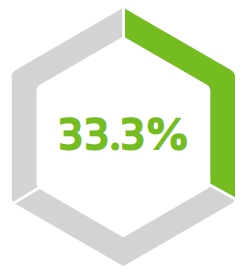 |
 |
101.5% | ||
| Adjusted PPNR Earnings Growth(1) | 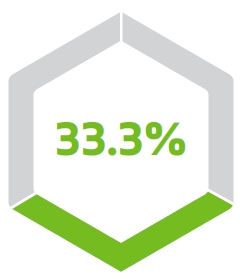 |
 |
106.8% | ||
| Adjusted Operating Leverage(1) | 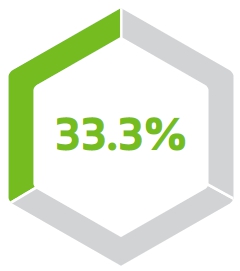 |
 |
107.4% | ||
| % of Target | 100.0% | 105.2% | |||
| Final Approved Funding | 105.2% | ||||
| (1) | Non-GAAP, see Appendix A to this proxy statement for more information. |
| Huntington Bancshares Incorporated 2025 Proxy Statement | 75 | |
 |
Compensation of Executive
Officers Compensation Discussion & Analysis |
Long-Term Incentive Compensation
Determining LTI Grant Value
The HRCC engaged its independent compensation consultant to assist in developing LTI award ranges based on competitive market practice to serve as guidelines for annual grants. These awards were based on a holistic approach that includes Company performance, individual performance and retention value of current equity ownership, historical long-term incentive compensation awards, and the market-based framework the independent consultant developed. In addition to these factors, when determining award ranges for individual executive officers, the HRCC considers the impact on potential total compensation.
RANGE FOR POTENTIAL EQUITY GRANTS
| Percentage of Base Salary | ||||||
| Position | Threshold | Target | Maximum | |||
| CEO | 262.5% | 525.0% | 1,050.0% | |||
| Other NEOs (vary by role) | 110.0%-125.0% | 220.0%-250.0% | 440.0%-500.0% | |||
Determination of individual LTI Grants
The HRCC independently evaluated the CEO’s performance for the purpose of determining a 2024 LTI award and assessed the competitive pay positioning that would result from the awards to be consistent with our pay-for-performance philosophy.
In determining award values for the other NEOs, the HRCC considered the CEO’s performance assessments for each NEO, as well as additional input from the CEO, and the market guidelines provided by the consultant. Consistent with the Company’s philosophy, the CEO’s evaluation was based on the holistic approach that included Company performance, individual performance and contributions, retention value of current equity ownership, historical long-term incentive compensation awards, and the market-based framework the independent consultant developed. The HRCC approved awards in 2024 for the NEOs (other than the CEO) as recommended by the CEO.
LTI Grant Vehicles
For the 2024 annual LTI grants, management proposed, and the HRCC approved, the strategy set forth below:
2024 Long-Term Incentive Program Highlights
| Vehicle | % of Total LTI Value | Key Design Features | ||||
| CEO | Other NEOs | |||||
| PSUs(1) |  |
 |
 Performance
Measurement Period: 3 years
 Performance
Measures:
 Relative ROTCE
 Absolute
ROTCE Performance Threshold
 Share
Payout Range: 0-150% of target
|
|||
| RSUs |  |
 |
 Vesting:
50% after year 3 and 50% after year 4
|
|||
| (1) | Beginning in 2025, PSUs comprise 60% of total annual LTI grant value for CEO and 55% for the other NEOs. |
| 76 | Huntington Bancshares Incorporated 2025 Proxy Statement | |
|
Compensation
of Executive Officers Compensation Discussion & Analysis |
 |
PSUs — Performance Metrics
With assistance from the independent consultant, the HRCC selected ROTCE, the same metric used in 2023, as the metric for the 2024 PSU grant, measured on both a relative and an absolute basis.
Why We Use ROTCE as the PSU Metric
 |
The Company believes ROTCE is a key factor to long-term profitable growth and returns. |
 |
There is a strong correlation of higher ROTCE to higher valuations for the common stock of publicly-traded bank holding companies. |
 |
The PSU awards are denominated in stock, which provides an inherent tie to share price performance and overall shareholder returns. |
The relative ROTCE target is set at the 55th percentile to ensure that target payout is not made unless Huntington’s performance is superior to that of the peer group median. The peer group for relative performance comparisons consists of the 2024 benchmarking peers as discussed under Market Referencing below. In addition, a minimum three-year average absolute ROTCE of 6% must be achieved to receive a payout.
Beginning in 2024, the Company phased out the award modifier, which provided up to a 20% multiplier for new revenue earned incremental to the budget. The new revenue multiplier was originally implemented to drive and capture new sources of revenue not envisioned in strategic initiatives when the PSU was granted. Those strategic initiatives identified through this process have now been incorporated into regular revenue streams accounted for in our annual budget.
As reflected in the table below, the HRCC determined a threshold, target, and maximum level of relative achievement for the three-year performance cycle, along with an absolute performance threshold. In calculating performance to determine whether a performance goal has been achieved, the HRCC will adjust for “Extraordinary Events,” as defined in the Long-Term Incentive Plans.
| PSU Metric | Threshold | Target | Maximum | |||
| Relative ROTCE | 30th Percentile | 55th Percentile | 70th Percentile | |||
| Absolute ROTCE — Performance Threshold | 6.00% | — | — |
ROTCE results are measured annually, adjusted for significant items by utilizing S&P Core ROTCE data for all companies, and averaged using year-end reported amounts. The range of potential payouts, 0% to 150% of the target number of share units, was consistent with the design of PSUs awarded in 2023 except for the sunset of the 20% new revenue modifier, and determined to be within competitive market practice, and reasonable from an annual share run rate and dilution perspective.
Benefits
Executive officers participate in the same broad-based benefit programs generally available to all colleagues. A limited number of additional benefits are offered to executive officers and certain other officers which represent a modest portion of total compensation. The following is a list of additional benefits and compensation elements offered to executive officers during 2024.
Deferred Compensation
Our EDCP, a non-qualified plan, provides a vehicle for participants to defer receipt of cash or stock until a later date in excess of IRS qualified plan limitations, but does not have a company match.
Perquisites
Huntington utilizes a limited number of perquisites representing a small component of compensation. We provide our CEO with security monitoring of his personal residences and use of our cars and drivers for security, personal safety, and efficiency. In addition, the CEO is permitted personal use of the corporate aircraft. The use of the corporate aircraft provides an environment that permits our CEO to perform confidential work while on personal trips, which would otherwise be impossible on commercial aircraft. In addition, certain trips, even though they may contain significant work components, do not qualify as “business use” under IRS rules, and therefore, must be included as perquisites despite the significant amount of work performed on the trip.
Use of the corporate aircraft after remote business meetings also allows our CEO the flexibility to travel efficiently throughout our footprint for work without having to keep a specific schedule that he would if he had commercial flight arrangements for his subsequent personal travel. Huntington’s culture is one of limited perquisites; however, because of the need for corporate aircrafts for business
| Huntington Bancshares Incorporated 2025 Proxy Statement | 77 | |
 |
Compensation of Executive
Officers Compensation Discussion & Analysis |
purposes given our large and expanded footprint, and the benefits that accrue to Huntington from our CEO using that corporate aircraft instead of a commercial flight, the HRCC and Board strongly feel that Huntington benefits substantially from the availability of the corporate aircraft for the CEO’s personal travel when necessary. The CEO’s usage of the corporate aircraft is reviewed by the HRCC and endorsed at least annually.
In limited circumstances, personal usage of corporate aircraft by other executive officers may be permitted subject to approval by the CEO. Personal use of the corporate aircraft is in accordance with Huntington’s Aircraft Usage Policy, which governs among other things who may travel together on the plane from a corporate risk perspective. The value of all personal use of corporate aircraft is included in the income of the user pursuant to IRS rules and regulations.
Executive Relocation
We also provide relocation benefits to senior level colleagues to facilitate transition when moving their residence to a new work location.
Executive Physical Program
Huntington offers our CEO, NEOs, and other executive officers access to an executive physical program and requires that it be completed once every 18 months. This program covers preventive service screenings including but not limited to physical examination, lab testing, cardiac evaluation, and orthopedic and pulmonary evaluations, and the results are confidential between the executive and provider.
Employment Agreement
Only one executive officer, our CEO, has an employment agreement with us, which is described under Mr. Steinour’s Employment Agreement below.
Severance Arrangements
Huntington has change-in-control agreements, referred to as Executive Agreements, with each of our NEOs. The objectives of the Executive Agreements are to provide severance protections for the NEOs in the event of a qualifying termination of employment in connection with a change-in-control of Huntington and to encourage their continued employment in the event of any actual or threatened change-in-control of Huntington. The Executive Agreements are further described under Payments upon Termination of Employment or Change in Control below.
(Frozen) Supplemental Pension
Messrs. Steinour and Kleinman are participants in the frozen pension plan, and Mr. Steinour is a participant in the frozen supplemental defined benefit plan (both were frozen on December 31, 2013). These plans are further discussed under the Pension Benefits 2024 table below.
(Frozen) Supplemental Savings
Mr. Steinour was eligible for, and participated in, a supplemental defined contribution plan that was frozen on December 31, 2019. This plan is further discussed following the Nonqualified Deferred Compensation 2024 table below.
2024 Compensation Decisions for Each Named Executive Officer
In addition to rewarding executives for achievement of financial goals, the HRCC applies its discretion to reinforce behaviors and values that contribute to the Company’s long-term success. When evaluating base salary increases, adjusting the MIP awards for business segment and individual performance, and determining the amount of long-term incentive compensation awards, the CEO and HRCC considered the performance of each executive under the following common factors:
Common Performance Factors:
 |
Financial and operating results |
 |
PLQ, people, and culture |
 |
Risk management and key metrics |
 |
Strategic planning and execution |
 |
Customers, community, and stakeholder relations |
| 78 | Huntington Bancshares Incorporated 2025 Proxy Statement | |
|
Compensation
of Executive Officers Compensation Discussion & Analysis |
 |
Further, the HRCC differentiated compensation for the NEOs other than the CEO by taking into consideration the CEO’s evaluation of each executive’s performance, role, and relative contribution to overall Company performance. Although there were no predetermined quantifiable goals against which business unit and individual performance were evaluated independently for purposes of determining compensation, highlights of the specific 2024 individual and business unit performance considered by the HRCC for each NEO are set forth below:
 |
Stephen
D. Steinour Chairman, President and Chief Executive Officer |
2024 Compensation Decisions | |||
| Base Salary | $ 1,150,000 | ||||
| Base Salary Increase | 0.0% | ||||
| MIP | |||||
| Target Opportunity | $ 2,300,000 | ||||
| MIP Award | $ 2,420,000 | ||||
| LTI | |||||
| Target Opportunity | $ 6,037,500 | ||||
| LTI Award | $ 6,000,000 | ||||
| In determining appropriate compensation for Mr. Steinour, the HRCC considered the following significant 2024 accomplishments: | |
| Strong Financial Performance | |
 |
Grew Huntington’s average loans and leases by $3.6 billion, or 2.9% year-over-year, and average total deposits by $7.7 billion, or 5.2% year-over-year. |
 |
Spearheaded the industry-leading, year-over-year loan growth, deposit growth, and fee revenue, while managing deposit beta and interest expense to exceed peers. |
 |
Completed a series of transactions to maximize capital and risk-weighted assets as part of Huntington’s capital optimization strategy. |
| Strong Leadership | |
 |
Managed the long-term growth strategy to expand Huntington’s capabilities and expertise into new geographies, including the Carolinas and Texas, and new commercial verticals. |
 |
Guided Huntington’s strategic payment capability and expertise growth, including in new merchant acquiring, expanded treasury management solutions, new card products, and augmented partnerships. |
 |
Oversaw Huntington’s strategic investments and partnerships, including the partnership with the Cleveland Browns. |
 |
Maintained strong credit performance through rigorous client selection and portfolio management aligned with our aggregate moderate-to-low risk appetite and continued disciplined expenses management. |
 |
Fostered a caring and inclusive culture at Huntington through large and small actions including Colleague Appreciation Week, Huntington Live, Pelotonia, and personalized visits to colleagues throughout the footprint. |
| Huntington Bancshares Incorporated 2025 Proxy Statement | 79 | |

|
Compensation of Executive
Officers Compensation Discussion & Analysis |
 |
Zachary
J. Wasserman Chief Financial Officer, Senior Executive Vice President |
2024 Compensation Decisions | |||
| Base Salary | $ 744,792 | ||||
| Base Salary Increase | 3.4% | ||||
| MIP | |||||
| Target Opportunity | $ 931,620 | ||||
| MIP Award | $ 1,100,000 | ||||
| LTI | |||||
| Target Opportunity | $ 1,812,500 | ||||
| LTI Award(1) | $ 2,350,000 | ||||
| In determining appropriate compensation for Mr. Wasserman, the HRCC considered the following significant 2024 accomplishments: | |
 |
Oversaw industry-leading, year-over-year loan growth, deposit growth, and fee revenue, while managing deposit beta and interest expense to exceed peers. |
 |
Supported the expansion into new geographies, the addition of commercial verticals, and the delivery of new products and services. |
 |
Completed a series of transactions to maximize capital and risk-weighted assets as part of Huntington’s capital optimization strategy. |
 |
Managed the Capital Plan through a dynamic interest rate environment to protect and grow net interest income and net interest margin through the implementation of the deposit pricing plan, improving hedge amortization costs, and maintaining fixed rate loan repricing. |
 |
Prioritized the community and colleagues with co-leading the Huntington Pelotonia team and participating in events such as Colleague Appreciation Week and Huntington Live. |
| (1) | In order to further incentivize Mr. Wasserman’s retention as a key leader, he received an additional LTI grant valued at $500,000 which was made at the same time as his annual LTI award (March 1, 2024), and is included in the LTI award value above. This grant is subject to the same award mix of RSUs and PSUs, vesting schedule, terms, and conditions as his annual LTI award. In aggregate, the value of these two awards was within the annual LTIP award opportunity range. |
| 80 | Huntington Bancshares Incorporated 2025 Proxy Statement | |
|
Compensation
of Executive Officers Compensation Discussion & Analysis |
 |
 |
Brant
J. Standridge President, Consumer and Regional Banking Senior Executive Vice President |
2024 Compensation Decisions | |||
| Base Salary | $ 750,000 | ||||
| Base Salary Increase | 0.0% | ||||
| MIP | |||||
| Target Opportunity | $ 1,125,000 | ||||
| MIP Award | $ 1,300,000 | ||||
| LTI | |||||
| Target Opportunity | $ 1,875,000 | ||||
| LTI Award(1) | $ 2,500,000 | ||||
| In determining appropriate compensation for Mr. Standridge, the HRCC considered the following significant 2024 accomplishments: | |
 |
Led the team to industry-leading, year-over-year loan growth, deposit growth, and fee revenue, while managing deposit beta and interest expense to exceed peers. |
 |
Deepened customer relationships in established and new geographies as well as introduced new products in the marketplace to streamline the customer originations journey with increased customer engagement and improved customer satisfaction. |
 |
Leveraged the regional banking model and scaled national businesses in practice finance, SBA lending, outdoor equipment & powersport, and consumer direct and indirect automotive. |
 |
Oversaw investment in Huntington’s regional banking model to optimize banking relationships in the branches and localize the customer experience while growing the national brand with partnerships such as the Cleveland Browns. |
 |
Localized the Huntington colleague experience with leadership in Ignite the Classroom and co-leadership in Pelotonia. |
| (1) | In order to further incentivize Mr. Standridge’s retention as a key leader, he received an additional LTI grant valued at $600,000 which was made at the same time as his annual LTI award (March 1, 2024), and is included in the LTI award value above. This grant is subject to the same award mix of RSUs and PSUs, vesting schedule, terms, and conditions as his annual LTI award. In aggregate, the value of these two awards was within the annual LTIP award opportunity range. |
| Huntington Bancshares Incorporated 2025 Proxy Statement | 81 | |
 |
Compensation of Executive
Officers Compensation Discussion & Analysis |
 |
Marcy
C. Hingst General Counsel Senior Executive Vice President |
2024 Compensation Decisions | |||
| Base Salary | $ 700,000 | ||||
| Base Salary Increase | 0.0% | ||||
| MIP | |||||
| Target Opportunity | $ 770,000 | ||||
| MIP Award | $ 800,000 | ||||
| LTI | |||||
| Target Opportunity | $ 1,540,000 | ||||
| LTI Award(1) | $ 1,550,000 | ||||
| In determining appropriate compensation for Ms. Hingst, the HRCC considered the following significant 2024 accomplishments: | |
 |
Supported Huntington’s expansion into Texas and the Carolinas as well as the new commercial verticals. |
 |
Oversaw the Legal teams and counseled Finance in efforts to maximize capital and risk-weighted assets through a series of transactions as part of Huntington’s capital optimization strategy. |
 |
Supported Huntington’s strategic investments and partnerships including the partnership with the Cleveland Browns through timely and sound legal advice. |
 |
Provided strong leadership in managing the litigation docket, advising on innovation initiatives, and protecting Huntington’s intellectual property. |
 |
Cultivated a welcoming and inclusive environment with colleague check-ins, the Legal Team Summit, and participation in Colleague Appreciation Week and Huntington Live. |
| (1) | In connection with her joining Huntington and to compensate her for certain cash and equity payments and benefits that Ms. Hingst forfeited as a result of accepting the opportunity with Huntington, Ms. Hingst received a $875,000 cash signing bonus, $125,000 of which was paid in 2023 and $750,000 of which was paid in 2024, and a one-time grant of 233,644 RSUs, with 40% vesting on the first anniversary of the grant date, 40% vesting on the second anniversary of the grant date, and 20% on the third anniversary of the grant date, subject to repayment in the event of a voluntary termination of employment within 24 months of joining the Company. Ms. Hingst also received $550,000 cash payment in 2023 and $550,000 RSU award in 2024 to compensate her for bonus payments forfeited as a result of accepting the opportunity with Huntington. |
| 82 | Huntington Bancshares Incorporated 2025 Proxy Statement | |
|
Compensation
of Executive Officers Compensation Discussion & Analysis |

|
 |
Scott
D. Kleinman President, Commercial Bank Senior Executive Vice President |
2024 Compensation Decisions | |||
| Base Salary | $ 700,000 | ||||
| Base Salary Increase | 0.0% | ||||
| MIP | |||||
| Target Opportunity | $ 805,000 | ||||
| MIP Award | $ 800,000 | ||||
| LTI | |||||
| Target Opportunity | $ 1,610,000 | ||||
| LTI Award(1) | $ 2,000,000 | ||||
| In determining appropriate compensation for Mr. Kleinman, the HRCC considered the following significant 2024 accomplishments: | |
 |
Led the team to industry-leading, year-over-year loan growth, deposit growth, and fee revenue in specialty banking, asset finance, capital markets, and treasury management. |
 |
Scaled the commercial business in legacy markets and new geographies and expanded into new, profitable commercial verticals. |
 |
Accelerated the expanded commercial capabilities and expertise throughout 2024 for top quartile performance among peers while continuing to balance credit risk. |
 |
Leveraged Capstone Partners to grow and deepen relationships among lines of the business; Capstone Partners won numerous awards in 2024 for its deals. |
 |
Demonstrated a commitment to colleagues with participation in Colleague Appreciation Week and Huntington Live. |
| (1) | In order to further incentivize Mr. Kleinman’s retention as a key leader, he received an additional LTI grant valued at $400,000 which was made at the same time as his annual LTI award (March 1, 2024), and is included in the LTI award value above. This grant is subject to the same award mix of RSUs and PSUs, vesting schedule, terms, and conditions as his annual LTI award. In aggregate, the value of these two awards was within the annual LTIP award opportunity range. |
| Huntington Bancshares Incorporated 2025 Proxy Statement | 83 | |
 |
Compensation
of Executive Officers Compensation Discussion & Analysis |
Recently Completed PSU Performance Cycles
2021 – 2023 Cycle
In April 2024, the HRCC determined the final award values for the PSU awards granted in 2021, which had a three-year performance cycle that ended on December 31, 2023. These awards were settled in shares of Huntington stock. The metric for this cycle was three-year relative ROTCE targeted at the 55th percentile performance for the selected peer group, subject to an average annual minimum absolute ROTCE of 6%, adjusted for significant items by utilizing S&P Core ROTCE data for all companies. In addition, the performance was subject to an increase of up to 20% for revenue earned incremental to the budget from new revenue sources intended to create shareholder value but not envisioned in the then current strategic initiatives when these PSUs were granted. During the period January 1, 2021 through December 31, 2023, relative ROTCE was above maximum performance, with absolute adjusted ROTCE at 21.38%. In addition, the incremental revenue generated resulted in application of a 10% award multiplier. Therefore, the final award results achieved were 150% x 10% which equaled a final award of 165% of target.
2021 – 2023 CYCLE (JANUARY 1, 2021 THROUGH DECEMBER 31, 2023)
| Metric | Target | Result | ||
| Relative ROTCE | 55th percentile performance for the selected peer group | 74.6th percentile | ||
| Absolute ROTCE – Performance Threshold | 6% | 21.38% | ||
| Final Award | 165% of target |
2022 – 2024 Cycle
December 31, 2024 marked the end of the three-year performance cycle for PSU awards granted in 2022. The HRCC expects to certify the results and determine the final values for these PSU awards in March 2025. The metric for this cycle was relative ROTCE targeted at the 55th percentile performance for the selected peer group with a minimum average absolute ROTCE of 6% required for payout with a potential adjustment for new revenue, all adjusted for significant items by utilizing S&P Core ROTCE data for all companies.
| 84 | Huntington Bancshares Incorporated 2025 Proxy Statement | |
| Compensation
of Executive Officers Compensation Discussion & Analysis |
 |
Executive Compensation Decision-Making Process
Who is Involved in Compensation Design and Decisions
| Role of HRCC | Role of Management | Role of Compensation Consultant | ||
 The
HRCC provides independent oversight of our executive compensation.
 The
HRCC develops and approves our executive compensation with input from our management and the independent compensation consultant.
 From
time to time, the HRCC consults with other committees of the Board and may obtain the approval of the full Board with respect to certain
executive and Director compensation matters.
|
 Our
management provides information and may make recommendations to the HRCC with respect to the amount and form of executive compensation.
 Our
CEO, CFO, and CHRO make recommendations to the HRCC when it sets specific financial measures and goals for determining incentive compensation.
 Our
CEO and CHRO provide input and make recommendations to the HRCC regarding the performance and compensation of the CEO’s direct
reports, which include the NEOs.
 The
CEO and CHRO consult in advance with the chairs of the respective Board committees regarding recommendations for key control positions,
such as the CRO, Chief Credit Officer, Credit Review Director, Controller, and Chief Auditor.
 The
CEO does not make recommendations to the HRCC regarding his own compensation.
|
 The
HRCC has engaged an independent compensation consultant, Pearl Meyer, to provide advice with respect to the amount and form of executive
and director compensation.
 The
compensation consultant is available as needed for expert guidance and support, provides updates on emerging trends and best practices,
and regularly attends meetings of the HRCC.
|
Independent Compensation Consultant
The HRCC engaged Pearl Meyer, an independent compensation consulting firm, to provide advisory services related to executive and Director compensation. The individual consultant managing the relationship with Huntington (the compensation consultant) reports directly to the HRCC and is evaluated by the HRCC on an annual basis.
Services provided by the compensation consultant during 2024 included: reviewing our selected peer group; benchmarking compensation and performance for executive officers and the Board; establishing total compensation guidelines, including targets for short- and long-term incentive plans and modeling payouts under various performance scenarios; analysis and assistance with proxy sections related to change-in-control payments and pay versus performance disclosure; review of, and recommendations for changes to, the Director compensation program; research and presentation of market trends and practices related to incentive plan design and other executive compensation-related programs; evaluation and benchmarking company-wide equity usage relative to peers; analyzing and developing a recommendation for the 2024 share request that was approved by shareholders at the 2024 annual meeting; and reviewing governance and regulatory practices as applicable to executive and director compensation. During 2024, the compensation consultant did not provide any services other than advice and recommendations related to executive and Director compensation and related proxy disclosure. The HRCC received representations from the compensation consultant with respect to independence, including with respect to: the fees received by the compensation consulting firm from Huntington as a percentage of total revenue of the consulting firm; the policies or procedures maintained by the compensation consulting firm designed to prevent a conflict of interest; any business or personal relationship between the compensation consultant and any HRCC member; any business or personal relationship between the compensation consultant and our executive officers; and any Huntington stock owned by the compensation consultant. Based on a review of these representations and the services provided by the compensation consultant, the HRCC determined that the compensation consultant is independent and that the consultant’s work has not created any conflicts of interest.
| Huntington Bancshares Incorporated 2025 Proxy Statement | 85 | |
 |
Compensation
of Executive Officers Compensation Discussion & Analysis |
Procedures for Determining Executive Compensation
Although the HRCC makes independent determinations on all matters related to compensation of executive officers, certain members of management are requested to attend committee meetings and provide input to the HRCC. Input may be sought from the CEO, Human Resources, Legal, Finance, and Risk Management colleagues and others as needed to ensure the HRCC has the information and perspective it needs to carry out its duties. In particular, the HRCC will seek input from the CEO on matters relating to strategic objectives, Company performance goals, and input on his assessment of the other executive officers. The CHRO and representatives of Human Resources work with the Chair of the HRCC to ensure they have the background, information, and data needed to facilitate meetings. The HRCC also receives updates from the CFO and other members of executive management throughout the year as appropriate.
The HRCC also meets with representatives of the Audit Committee and Risk Oversight Committee, as appropriate, in making determinations. The Chair of the Audit Committee is consulted when the HRCC certifies Company performance against the established incentive plan performance goals.
The HRCC may delegate all or a portion of its duties and responsibilities to a subcommittee of the HRCC, or, if provided for in the terms of a particular compensation plan, to a management committee in accordance with the terms of such plan. The HRCC delegates some responsibilities to management to assist in development of design considerations, with permission to work with the HRCC’s compensation consultant, to develop proposals for the HRCC’s consideration. The HRCC may not, however, delegate the determination of compensation for executive officers to management. From time to time, the HRCC may obtain the approval of the Board with respect to certain executive and Director compensation matters.
The HRCC takes risk into account when determining compensation and supports an executive compensation philosophy that balances risk and reward with a mix of base pay, short-term incentives, and long-term incentives, with greater emphasis on long-term incentives. The HRCC’s role in the oversight of incentive compensation risk is discussed under The Board’s Role in Risk Oversight above.
Market Referencing
The HRCC regularly reviews peer and industry information concerning levels of compensation and performance as a competitive frame of reference. The HRCC uses this information and analysis as a benchmarking reference for setting pay opportunities and making pay decisions, such as changes to base salaries, annual incentive awards, and long-term incentive grants. A key source of information is a peer group of regional banks similar to Huntington in terms of size and business model.
The peer banks are reviewed each year using an objective process recommended by the independent compensation consultant and approved by the HRCC. The process begins with the selection of U.S.-based publicly-traded commercial banks considering asset size as of the prior year-end. A few banks with relevant asset size are eliminated due to significant differences in business model.
At the recommendation of the independent compensation consultant, the HRCC selected banks with asset sizes between approximately $86 billion to $668 billion (as of September 30, 2023), excluding banks that are non-commercial, distressed, or have significant business differences, including international presence or focus, unique headquarter locations, or a focus on different services. Preference is also given to banks in the current peer group or banks identified as our peers by third-party proxy advisors. We determined that all ten peers remain appropriate to preserve current group stability.
The peer group consists of ten bank holding companies; seven larger and three smaller in terms of total assets, positioning Huntington slightly below the median for asset size. The HRCC chose the ten peers to represent the most appropriate market comparators for Huntington in terms of industry and size. The independent compensation consultant also provided the HRCC with industry analysis reflective of Huntington’s size and business profile as appropriate to supplement the peer group data. This included utilizing size-adjusted comparisons representing data from companies that fell closest to our asset size, including market capitalization, employees, and number of branches.
| 86 | Huntington Bancshares Incorporated 2025 Proxy Statement | |
| Compensation
of Executive Officers Compensation Discussion & Analysis |
 |
Set forth below are the peers utilized for the 2023 and 2024 peer groups, which are the same year-over-year.
| Peer Banks for 2023 | Peer Banks for 2024 | ||
| Citizens Financial Group, Inc. (CFG) Comerica Incorporated (CMA) Fifth Third Bancorp (FITB) KeyCorp (KEY) M&T Bank Corporation (MTB) PNC Financial Services Group, Inc. (PNC) Regions Financial Corporation (RF) Truist Financial Corporation (TFC) U.S. Bancorp (USB) Zions Bancorporation, National Association (ZION) |
 |
Citizens Financial Group, Inc. (CFG) Comerica Incorporated (CMA) Fifth Third Bancorp (FITB) KeyCorp (KEY) M&T Bank Corporation (MTB) PNC Financial Services Group, Inc. (PNC) Regions Financial Corporation (RF) Truist Financial Corporation (TFC) U.S. Bancorp (USB) Zions Bancorporation, National Association (ZION) |
Other Policies and Practices
Stock Ownership Requirements
To reinforce the importance of stock ownership to the Company’s compensation philosophy, the HRCC has imposed ownership requirements since 2006. Executive officers, as well as approximately 60 additional next level executives, subject to the policy are required to meet and maintain a dollar value of ownership based on a multiple of salary. The executive officer’s current base salary is multiplied by their assigned multiple and compared to current holdings, valued based on a 30-day average closing stock price.(1) For the purpose of this policy, shares owned include shares purchased in the open market, shares received upon vesting or exercise of equity awards granted by Huntington, shares held in Huntington benefit and deferred compensation plans, unvested time-based RSUs and restricted stock awards, and shares held by immediate family members sharing the same household. Executive officers generally have five years to meet their ownership levels and thereafter must continue to meet the requirements on an ongoing basis. As of February 18, 2025, each NEO who has served at least five years meets the guidelines.
NEO OWNERSHIP COMPARED TO GUIDELINES
| Executive | Multiple | |
| Steinour | 10X | |
| Wasserman | 3X | |
| Standridge | 3X | |
| Hingst | 3X | |
| Kleinman | 3X |
| (1) | For the purpose of the stock ownership policy, stock owned includes stock purchased in the open market, stock received upon vesting or exercise of equity awards granted by Huntington, stock held in Huntington benefit and deferred compensation plans, unvested time-based RSUs and restricted stock awards, and stock held by an immediate family member sharing the same household. |
Hedging and Pledging Prohibition
The HRCC has a policy prohibiting hedging and pledging activity in equity securities of Huntington. The policy applies to Huntington’s Directors, executive officers, other members of Huntington’s ELT, and other officers subject to Section 16 of the Exchange Act. The hedging and pledging prohibitions apply with respect to any interests in Huntington securities owned by the covered persons, directly or indirectly, whether granted by Huntington as compensation or otherwise acquired and held. Prohibited hedging activity includes using financial instruments (including, but not limited to, prepaid variable forward contracts, equity swaps, collars, options, and exchange funds) or otherwise engaging in transactions that are designed to, or have the effect of, hedging or offsetting any decrease in the market value of Huntington securities. Huntington equity securities may not be pledged as collateral for a loan or held in a margin account.
Annual Long-Term Incentive Award Grant Practices
The Long-Term Incentive Plan permits the HRCC to designate a grant date effective following the date of its action. The HRCC has adopted a practice of granting equity awards on a pre-established date to avoid any appearance of coordination with the release of material non-public information. We grant our annual LTI awards in March in order to improve the incentive-setting process and better align with peers. Under the Company’s stock plan, fair market value is generally defined as the closing price on the applicable date. We prohibit the repricing of previously-granted stock options without shareholder approval.
| Huntington Bancshares Incorporated 2025 Proxy Statement | 87 | |
 |
Compensation
of Executive Officers Compensation Discussion & Analysis |
Recoupment of Incentive Compensation
We have multiple overlapping ways to hold our colleagues, including our NEOs, accountable and recover compensation. These include (i) terms of our Long-Term Incentive Plans, (ii) terms of our Annual Incentive Plan, (iii) our internal Recoupment Policy (our Misconduct Recoupment Policy), (iv) our Financial Restatement Compensation Recoupment Policy in compliance with Rule 10D-1 of the Exchange Act, the SEC regulations promulgated thereunder, and Nasdaq Rules, (v) the Sarbanes-Oxley Act, and (vi) the Dodd-Frank Act. The following types of incentive compensation are subject to recoupment:
 |
any bonus or other cash incentive payment, including commissions, previously paid or payable, and |
 |
any equity compensation, vested or unvested (including without limitation, performance shares and PSUs, restricted stock and RSUs and stock options), and net proceeds of any exercised or vested equity awards. |
| Tool | Compensation Covered | Conduct Covered | Consequence | |||
| Long-Term Incentive Compensation | All equity awards made under the Long-Term Incentive Plans, except following a change in control. | A serious breach of conduct or solicitation of customers or potential customers with whom the participant had contact during the participant’s employment with us. | Termination of any outstanding vested or unvested award in whole or in part, or repayment of any benefit received if such conduct or activity occurs within three years following the exercise or payment of an award, and awards may be forfeited upon termination of employment for cause. | |||
| Annual Incentive Compensation | Awards made under the Annual Incentive Plan. | Restatement of financial statements because of a material noncompliance with financial reporting requirements; taking of unnecessary or excessive risk, manipulation of earnings; or engaging in any misconduct described in the Misconduct Recoupment Policy. | Repayment of any amount previously paid in excess of what would have been paid under the restated financial statements or such other amount in accordance with the Dodd-Frank Act. | |||
| Misconduct Recoupment Policy (Misconduct or Performance) | Any bonus or other cash incentive payment, including commissions, previously paid or payable and any equity compensation, vested or unvested, and net proceeds of any exercised or vested equity awards. | Misconduct, including fraud, intentional misconduct, gross negligence, or manipulation of earnings; and Performance, including taking of excessive risk outside the bounds of the Company’s risk governance structure. | Potential reimbursement or forfeiture of incentive compensation. | |||
| Financial Restatement Compensation Recoupment Policy (Restatement of Financials) | Any incentive-based compensation received by covered executive officers on or after October 2, 2023, including any cash or equity or equity-based compensation (whether deferred or current) that is granted, earned, and/or vested based wholly or in part upon the achievement of a financial reporting measure, and any amounts that were determined based on incentive-based compensation. | Restatement of financial statements resulting from material noncompliance with financial reporting requirements under U.S. securities laws. | Repayment of all erroneously awarded compensation. | |||
| Sarbanes-Oxley Act | Incentive compensation paid to the CEO and CFO only within the 12-month period following the release of financial information that subsequently was restated. | Misconduct resulting in required restatement of any financial reporting required under securities laws. | Reimbursement of bonus, incentive-based or equity-based compensation received within the 12-month period following the public release of financial information that was restated. | |||
| Dodd-Frank Act | Incentive compensation during the three-year period preceding the date on which the restatement is required from any current or former executive officers or any other individual specified in the Dodd-Frank Act. | Restatement of any Company financial statements because of a material financial reporting violation. | Recovery of the amount in excess of the incentive compensation payable under the Company’s restated financial statements. |
| 88 | Huntington Bancshares Incorporated 2025 Proxy Statement | |
| Compensation
of Executive Officers Report of the Human Resources and Compensation Committee |
 |
Recoupment Disclosure
During 2024, we did not take any action to recover any incentive compensation from any of our NEOs or other executives.
Tax and Accounting Considerations
Section 162(m) of the Code limits the tax deductibility of compensation for certain executive officers that is more than $1 million. The HRCC continues to have the flexibility to pay non-deductible compensation if it believes it is in the best interests of the Company. Huntington also takes into consideration Code Section 409A with respect to nonqualified deferred compensation programs, and ASC 718, “Compensation - Stock Compensation” in administering its equity compensation program.
Report of the Human Resources and Compensation Committee
The Human Resources and Compensation Committee has reviewed and discussed with management the Compensation Discussion and Analysis contained in this proxy statement. Based on this review and discussion, the Human Resources and Compensation Committee recommended to the Board that the Compensation Discussion and Analysis be included in Huntington’s proxy statement for its 2025 Annual Meeting of Shareholders.
Submitted by the Human Resources and Compensation Committee
 |
 |
 |
 |
|||
| Gina D. France, Chair | J. Michael Hochschwender |
Kenneth J. Phelan | Roger J. Sit |
| Huntington Bancshares Incorporated 2025 Proxy Statement | 89 | |
 |
Compensation of Executive Officers Executive Compensation Tables |
Executive Compensation Tables
Summary Compensation 2024
The following table sets forth the compensation paid by us and by our subsidiaries for each of the last three fiscal years ended December 31, to our principal executive officer, principal financial officer, and the three other most highly-compensated executive officers serving at the end of 2024:
|
Name and Principal Position(1) |
Year |
Salary ($) |
Bonus ($)(2) |
Stock Awards ($)(3) |
Option Awards ($) |
Non-Equity Incentive Plan Compensation ($)(4) |
Change in Pension Value and Non-Qualified Deferred Compensation Earnings ($)(5) |
All Other Compensation ($)(6)(7) |
Total ($) |
|||||||||
|
Stephen D. Steinour Chairman, President and CEO |
2024 | 1,150,000 | — | 5,999,994 | — | 2,420,000 | — | 455,669 | 10,025,663 | |||||||||
| 2023 | 1,139,583 | — | 5,999,987 | — | 2,300,000 | 77,639 | 662,270 | 10,179,479 | ||||||||||
| 2022 | 1,100,000 | — | 5,499,988 | — | 3,410,000 | — | 474,987 | 10,484,975 | ||||||||||
|
Zachary J. Wasserman Chief Financial Officer, Senior Executive Vice President |
2024 | 744,792 | — | 2,349,986 | — | 1,100,000 | — | 8,772 | 4,203,550 | |||||||||
| 2023 | 719,792 | 50,000 | 1,999,986 | — | 1,150,000 | — | 17,598 | 3,937,376 | ||||||||||
| 2022 | 671,875 | 50,000 | 1,999,980 | — | 1,400,000 | — | 8,644 | 4,130,499 | ||||||||||
|
Brant J. Standridge President, Consumer & Regional Banking, Senior Executive Vice President |
2024 | 750,000 | — | 2,499,998 | — | 1,300,000 | — | 8,772 | 4,558,770 | |||||||||
| 2023 | 744,792 | 1,550,000 | 1,999,986 | — | 1,250,000 | — | 51,954 | 5,596,732 | ||||||||||
| 2022 | 513,542 | (8) | 120,000 | 4,573,872 | — | 1,750,000 | — | 113,262 | 7,070,676 | |||||||||
|
Marcy C. Hingst General Counsel, Senior Executive Vice President |
2024 | 700,000 | 750,000 | 2,099,985 | — | 800,000 | — | 16,167 | 4,366,152 | |||||||||
|
Scott D. Kleinman President, Commercial Banking, Senior Executive Vice President |
2024 | 700,000 | — | 1,999,998 | — | 800,000 | 16,743 | 12,604 | 3,529,345 | |||||||||
| 2023 | 689,583 | — | 1,799,984 | — | 900,000 | 25,094 | 21,870 | 3,436,531 | ||||||||||
| 2022 | 631,250 | — | 1,749,996 | — | 1,250,000 | — | 16,869 | 3,648,115 |
| (1) | Mr. Standridge joined Huntington as President, Consumer and Business Banking on April 11, 2022. Ms. Hingst joined Huntington as General Counsel and Senior Executive Vice President on October 16, 2023. |
| (2) | In connection with Mr. Wasserman joining Huntington in 2019, Mr. Wasserman received payments, including a three-year cash payment of $50,000 per year commencing in May 2021 to compensate him for certain cash and equity payments and benefits which he forfeited due to accepting employment with Huntington. In connection with Mr. Standridge joining Huntington in April 2022, Mr. Standridge received a signing bonus of $1,670,000, $120,000 of which was paid in May 2022 and $1,550,000 of which was paid in February 2023, subject to recoupment if Mr. Standridge terminates his employment with Huntington voluntarily or for cause within 24 months of each payment. In connection with Ms. Hingst joining Huntington in October 2023, Ms. Hingst received a $875,000 cash signing bonus, $125,000 of which was paid in December 2023 and $750,000 of which was paid in February 2024, subject to recoupment if Ms. Hingst terminates her employment with Huntington voluntarily or Huntington terminates her employment for cause within 24 months of each payment. |
| 90 | Huntington Bancshares Incorporated 2025 Proxy Statement | |
|
Compensation of Executive Officers Executive Compensation Tables |
 |
| (3) | The amounts in this column are the grant date fair values of awards of RSUs and PSUs determined for accounting purposes in accordance with FASB ASC Topic 718. The PSUs are valued at target. The assumptions made in the valuation are discussed in Note 15 “Share-Based Compensation” of the Notes to Consolidated Financial Statements for our financial statements for the year ended December 31, 2024. The grant date fair value of the 2024 awards is set forth below: |
|
Time-Vesting RSUs ($)(a) |
Performance-Based PSUs (Target) ($)(b) |
Total
Stock Awards ($) |
||||
| Stephen D. Steinour | 2,699,997 | 3,299,997 | 5,999,994 | |||
| Zachary J. Wasserman | 1,174,993 | 1,174,993 | 2,349,986 | |||
| Brant J. Standridge | 1,249,999 | 1,249,999 | 2,499,998 | |||
| Marcy C. Hingst | 1,324,992 | 774,993 | 2,099,985 | |||
| Scott D. Kleinman | 999,999 | 999,999 | 1,999,998 |
(a) RSUs for Messrs. Wasserman, Standridge, and Kleinman include one-time retention grants of $250,000, $300,000, and $200,000, respectively. Ms. Hingst’s RSUs include a $550,000 grant of RSUs in connection with her joining Huntington, which she received to compensate her for certain equity payments that she forfeited as a result of accepting the opportunity with Huntington.
(b) PSUs for Messrs. Wasserman, Standridge, and Kleinman include one-time retention grants of $250,000, $300,000, and $200,000, respectively, at target. The grant date fair value of the PSUs awarded to the NEOs in 2024, inclusive of retention grants, assuming the highest level of performance, is set forth below:
|
Dollar
Value of PSUs at Maximum Performance ($) |
||
| Stephen D. Steinour | 4,949,995 | |
| Zachary J. Wasserman | 1,762,489 | |
| Brant J. Standridge | 1,874,999 | |
| Marcy C. Hingst | 1,162,489 | |
| Scott D. Kleinman | 1,499,999 |
| (4) | The amounts in this column are annual cash incentive awards earned under the MIP for 2024. |
| (5) | The amount in this column for the 2024 fiscal year represents the change in the actuarial present value of accumulated benefit from December 31, 2023 to December 31, 2024, under two defined benefit pension plans: the Retirement Plan and the SRIP. These plans were closed to new hires after December 31, 2009, and were frozen as of December 31, 2013. Benefits are based on levels of compensation and years of credited service as of December 31, 2013. The valuation method used to determine the present values, and all material assumptions applied, are discussed in Note 16 “Benefit Plans” of the Notes to Consolidated Financial Statements for the fiscal year ended December 31, 2024. The change in present value for Messrs. Steinour and Kleinman under each plan is detailed below. The “Total Change in Present Value” cannot be a negative number, which would be $(65,680) for Mr. Steinour. Mr. Steinour’s “Total Change in Present Value” decreased since he delayed his retirement past the normal retirement age and the increase in the discount rate. Messrs. Wasserman and Standridge and Ms. Hingst were not eligible to participate in these plans, as they began their employment after participation was closed to new hires. Additional detail about these plans is set forth in the discussion following the table of Pension Benefits 2024 below. There were no above-market or preferential earnings on non-qualified deferred compensation. |
|
Change in Present Value Retirement Plan ($) |
Change in Present Value SRIP ($) |
Total
Change in Present Value ($) |
||||
| Stephen D. Steinour | (7) | (65,673) | 0 | |||
| Scott D. Kleinman | 16,743 | — | 16,743 |
| Huntington Bancshares Incorporated 2025 Proxy Statement | 91 | |
 |
Compensation of Executive Officers Executive Compensation Tables |
| (6) | All other compensation as reported in this column includes: our contributions to the 401(k) Plan (a defined contribution plan); perquisites and personal benefits, including executive physical benefits, valued at incremental cost to us; and premiums for group term life insurance. These amounts are detailed below. |
|
Amounts
Contributed to 401(k) Plan ($) |
Perquisites and Personal Benefits ($) |
Group
Term Life Insurance ($) |
Total
All Other Compensation ($) |
||||||
| Stephen D. Steinour | 8,000 | 446,897 | 772 | 455,669 | |||||
| Zachary J. Wasserman | 8,000 | — | 772 | 8,772 | |||||
| Brant J. Standridge | 8,000 | — | 772 | 8,772 | |||||
| Marcy C. Hingst | 8,000 | 7,395 | 772 | 16,167 | |||||
| Scott D. Kleinman | 8,000 | 3,832 | 772 | 12,604 |
| (7) | In the ordinary course of business, Huntington maintains a number of automobiles and has access to a corporate aircraft as needed to provide secure and efficient business transportation for senior management. When it is not otherwise needed for business travel, a corporate aircraft may be available to the CEO for personal usage for reasons of security, efficiency, personal safety, and health and safety concerns. The amount reported for use of the corporate plane reflects the aggregate incremental cost to Huntington for Mr. Steinour’s personal use during 2024. The incremental cost was $426,888 based on multiplying the annual flight hours by an hourly rate consisting of variable operating costs including prorated maintenance, fuel, crew expenses, supplies, and all associated landing fees. As the plane is used primarily for business travel, we exclude fixed costs that do not change based on usage such as crew salaries, depreciation, and calendar-related maintenance. For efficiency and security, Mr. Steinour is also permitted personal use of automobiles, driven by Huntington security personnel, including for commuting, which permits him to work while traveling. The incremental cost of this usage to Huntington for 2024 was based on a rate per mile for fuel and maintenance and overtime costs for the drivers, totaling $11,990. Other perquisites and personal benefits for Mr. Steinour consisted of security monitoring of his personal residences, totaling $8,019. Perquisites and personal benefits for Ms. Hingst consisted of executive physical benefits totaling $7,395. Mr. Kleinman’s total All Other Compensation includes $3,832 in restricted stock cash dividends, which this amount was not taken into account in calculating the grant date fair value reported in the “Stock Awards” column. |
| (8) | Amounts shown for Mr. Standridge include wages paid by Huntington from the start of his employment with Huntington on April 11, 2022. |
| 92 | Huntington Bancshares Incorporated 2025 Proxy Statement | |
|
Compensation of Executive Officers Executive Compensation Tables |
 |
Grants of Plan-Based Awards 2024
The table below sets forth potential opportunities for annual cash incentive awards under the MIP and awards of RSUs and PSUs for 2024.
|
Date of Board or Committee Action |
Estimated Future Payouts Under Non-Equity Incentive Plan Awards(1) |
Estimated Future Payouts Under Equity Incentive Plan Awards(2) |
All Other Stock Awards: Number of Shares of Stock or Units (#)(3) |
All Other Option Awards: Number of Securities Underlying Options (#) |
Exercise or Base Price of Option Awards ($/Sh) |
Grant Date Fair Value of Stock and Option Awards ($)(4) |
||||||||||||||||||
| Name |
Grant Date |
Threshold ($) |
Target ($) |
Maximum ($) |
Threshold (#) |
Target (#) |
Maximum (#) |
|||||||||||||||||
| Stephen D. Steinour | ||||||||||||||||||||||||
| Annual Incentive | 1,150,000 | 2,300,000 | 4,600,000 | |||||||||||||||||||||
| PSUs | 3/1/2024 | 1/31/2024 | 127,413 | 254,826 | 382,239 | 3,299,997 | ||||||||||||||||||
| RSUs | 3/1/2024 | 1/31/2024 | 208,494 | 2,699,997 | ||||||||||||||||||||
| Zachary J. Wasserman | ||||||||||||||||||||||||
| Annual Incentive | 465,810 | 931,620 | 1,863,239 | |||||||||||||||||||||
| PSUs | 3/1/2024 | 1/31/2024 | 35,714 | 71,428 | 107,142 | 924,993 | ||||||||||||||||||
| PSUs | 3/1/2024 | 1/31/2024 | 9,652 | 19,305 | 28,957 | 250,000 | ||||||||||||||||||
| RSUs | 3/1/2024 | 1/31/2024 | 71,428 | 924,993 | ||||||||||||||||||||
| RSUs | 3/1/2024 | 1/31/2024 | 19,305 | 250,000 | ||||||||||||||||||||
| Brant J. Standridge | ||||||||||||||||||||||||
| Annual Incentive | 562,500 | 1,125,000 | 2,250,000 | |||||||||||||||||||||
| PSUs | 3/1/2024 | 1/31/2024 | 36,679 | 73,359 | 110,038 | 949,999 | ||||||||||||||||||
| PSUs | 3/1/2024 | 1/31/2024 | 11,583 | 23,166 | 34,749 | 300,000 | ||||||||||||||||||
| RSUs | 3/1/2024 | 1/31/2024 | 73,359 | 949,999 | ||||||||||||||||||||
| RSUs | 3/1/2024 | 1/31/2024 | 23,166 | 300,000 | ||||||||||||||||||||
| Marcy C. Hingst | ||||||||||||||||||||||||
| Annual Incentive | 385,000 | 770,000 | 1,540,000 | |||||||||||||||||||||
| PSUs | 3/1/2024 | 1/31/2024 | 29,922 | 59,845 | 89,767 | 774,993 | ||||||||||||||||||
| RSUs | 3/1/2024 | 1/31/2024 | 59,845 | 774,993 | ||||||||||||||||||||
| RSUs | 3/1/2024 | 10/17/2023 | 42,471 | 549,999 | ||||||||||||||||||||
| Scott D. Kleinman | ||||||||||||||||||||||||
| Annual Incentive | 402,500 | 805,000 | 1,610,000 | |||||||||||||||||||||
| PSUs | 3/1/2024 | 1/31/2024 | 30,888 | 61,776 | 92,664 | 799,999 | ||||||||||||||||||
| PSUs | 3/1/2024 | 1/31/2024 | 7,722 | 15,444 | 23,166 | 200,000 | ||||||||||||||||||
| RSUs | 3/1/2024 | 1/31/2024 | 61,776 | 799,999 | ||||||||||||||||||||
| RSUs | 3/1/2024 | 1/31/2024 | 15,444 | 200,000 | ||||||||||||||||||||
| (1) | Each of the NEOs participated in the 2024 MIP. The award opportunities presented in the table represent the potential payout range based on percentages of salary at threshold, target, and maximum levels of corporate performance. Awards are subject to adjustment for individual and business unit performance and the discretion of the HRCC. Actual awards earned for 2024 are reported in the Summary Compensation Table under the column headed “Non-Equity Incentive Plan Compensation.” The annual incentive plan is further explained in Executive Compensation Program Features — Compensation Outcomes for 2024 —Annual Incentive Award in the CD&A of this Proxy Statement. |
| (2) | Each of the NEOs received a PSU award in 2024. These columns reflect the potential number of PSUs to be vested upon satisfaction of the applicable performance conditions as of December 31, 2026, at threshold, target, and maximum performance. The vesting is subject to the NEO’s continued service through the vesting date. See Executive Compensation Program Features — Compensation Outcomes for 2024 — Long-Term Incentive Compensation in the CD&A of this Proxy Statement for a description of the terms of these awards. Any vested units will convert to shares of our common stock on a one-for-one basis. PSUs that do not vest will be forfeited. |
| (3) | The HRCC awarded RSUs to each of the NEOs vesting over a period of four years, with 50% of the award vesting on the third anniversary of the grant date, and 50% on the fourth anniversary of the grant date. Any vested units will convert to shares of our common stock on a one-for-one basis. RSUs that do not vest will be forfeited. |
| (4) | The amounts in this column are the grant date fair values, for accounting purposes, of the awards of PSUs (at target) and RSUs determined in accordance with FASB ASC Topic 718. |
| Huntington Bancshares Incorporated 2025 Proxy Statement | 93 | |
 |
Compensation of Executive Officers Executive Compensation Tables |
Outstanding Equity Awards at Fiscal Year-End 2024
The following table sets forth details about the unexercised stock options and unvested awards of RSUs and PSUs held by the NEOs as of December 31, 2024:
| Option Awards | Stock Awards | |||||||||||||||||
| Name |
Grant Date |
Number
of Securities Underlying Unexercised Options (#) Exercisable(1) |
Number
of Securities Underlying Unexercised Options (#) Unexercisable(1) |
Option Exercise Price ($)(2) |
Option Expiration Date |
Number of Shares or Units of Stock That Have Not Vested (#)(3) |
Market Value of Shares or Units of Stock That Have Not Vested ($)(4) |
Equity Incentive Plan Awards: Number of Unearned Shares, Units, or Other Rights That Have Not Yet Vested (#)(5) |
Equity Incentive Plan Awards: Market or Payout Value of Unearned Shares, Units, or Other Rights That Have Not Vested ($)(6) |
|||||||||
| Stephen D. Steinour | 5/1/2015 | 268,055 | — | 10.89 | 5/1/2025 | — | — | — | — | |||||||||
| 5/1/2016 | 325,313 | — | 10.06 | 5/1/2026 | — | — | — | — | ||||||||||
| 5/1/2017 | 266,903 | — | 13.09 | 5/1/2027 | — | — | — | — | ||||||||||
| 5/1/2018 | 484,496 | — | 14.81 | 5/1/2028 | — | — | — | — | ||||||||||
| 5/1/2019 | 589,005 | — | 13.77 | 5/1/2029 | — | — | — | — | ||||||||||
| 5/1/2020 | 760,135 | — | 8.57 | 5/1/2030 | — | — | — | — | ||||||||||
| 3/26/2021 | 248,579 | 82,860 | 16.08 | 3/26/2031 | 38,474 | 625,969 | — | — | ||||||||||
| 3/1/2022 | — | — | — | — | 196,784 | 3,201,675 | 432,925 | 7,043,688 | ||||||||||
| 3/1/2023 | — | — | — | — | 192,870 | 3,138,000 | 424,316 | 6,903,614 | ||||||||||
| 3/1/2024 | — | — | — | — | 215,640 | 3,508,466 | 395,340 | 6,432,188 | ||||||||||
| Zachary J. Wasserman | 5/1/2020 | 105,574 | — | 8.57 | 5/1/2030 | — | — | — | — | |||||||||
| 3/26/2021 | 75,757 | 25,253 | 16.08 | 3/26/2031 | 14,657 | 238,470 | — | — | ||||||||||
| 3/1/2022 | — | — | — | — | 79,508 | 1,293,596 | 143,115 | 2,328,473 | ||||||||||
| 3/1/2023 | — | — | — | — | 71,433 | 1,162,218 | 128,580 | 2,091,992 | ||||||||||
| 3/1/2024 | — | — | — | — | 73,876 | 1,201,966 | 110,814 | 1,802,949 | ||||||||||
| 3/1/2024 | — | — | — | — | 19,967 | 324,858 | 29,950 | 487,287 | ||||||||||
| Brant J. Standridge | 4/11/2022 | — | — | — | — | 71,257 | 1,159,354 | — | — | |||||||||
| 4/11/2022 | — | — | — | — | 82,600 | 1,343,895 | — | — | ||||||||||
| 3/1/2023 | — | — | — | — | 71,433 | 1,162,218 | 128,580 | 2,091,992 | ||||||||||
| 3/1/2024 | — | — | — | — | 75,873 | 1,234,460 | 113,810 | 1,851,690 | ||||||||||
| 3/1/2024 | — | — | — | — | 23,960 | 389,830 | 35,940 | 584,744 | ||||||||||
| Marcy C. Hingst | 11/1/2023 | — | — | — | — | 146,740 | 2,387,452 | — | — | |||||||||
| 3/1/2024 | — | — | — | — | 43,927 | 714,688 | — | — | ||||||||||
| 3/1/2024 | — | — | — | — | 61,896 | 1,007,051 | 92,844 | 1,510,577 | ||||||||||
| 94 | Huntington Bancshares Incorporated 2025 Proxy Statement | |
|
Compensation of Executive Officers Executive Compensation Tables |
 |
| Option Awards | Stock Awards | |||||||||||||||||
| Name | Grant Date |
Number of Securities Underlying Unexercised Options (#) Exercisable(1) |
Number of Securities Underlying Unexercised Options (#) Unexercisable(1) |
Option Exercise Price ($)(2) |
Option Expiration Date |
Number of Shares or Units of Stock That Have Not Vested (#)(3) |
Market
Value of Shares or Units of Stock That Have Not Vested ($)(4) |
Equity Incentive Plan Awards: Number of Unearned Shares, Units, or Other Rights That Have Not Yet Vested (#)(5) |
Equity Incentive Plan Awards: Market or Payout Value of Unearned Shares, Units, or Other Rights That Have Not Vested ($)(6) |
|||||||||
| Scott D. Kleinman | 5/1/2015 | 8,054 | — | 10.89 | 5/1/2025 | — | — | — | — | |||||||||
| 5/1/2016 | 13,133 | — | 10.06 | 5/1/2026 | — | — | — | — | ||||||||||
| 5/1/2017 | 10,676 | — | 13.09 | 5/1/2027 | — | — | — | — | ||||||||||
| 5/1/2018 | 21,802 | — | 14.81 | 5/1/2028 | — | — | — | — | ||||||||||
| 5/1/2019 | 29,450 | — | 13.77 | 5/1/2029 | — | — | — | — | ||||||||||
| 3/26/2021 | 75,757 | 25,253 | 16.08 | 3/26/2031 | 14,657 | 238,470 | — | — | ||||||||||
| 3/1/2022 | — | — | — | — | 69,570 | 1,131,906 | 125,226 | 2,037,431 | ||||||||||
| 3/1/2023 | — | — | — | — | 64,290 | 1,045,994 | 115,722 | 1,882,789 | ||||||||||
| 3/1/2024 | — | — | — | — | 63,893 | 1,039,546 | 95,840 | 1,559,318 | ||||||||||
| 3/1/2024 | — | — | — | — | 15,973 | 259,886 | 23,960 | 389,830 | ||||||||||
| (1) | Awards of stock options become exercisable in four equal annual increments from the date of grant date. |
| (2) | Represents the closing market price of our common stock on the date of the stock option award. |
| (3) | Awards of RSUs granted on March 26, 2021, March 1, 2022, March 1, 2023, or March 1, 2024 vest over a period of four years, with 50% of the award vesting on the third anniversary of the grant date, and 50% on the fourth anniversary of the grant date. Seventy percent of the award of 209,827 RSUs granted on April 11, 2022 to Mr. Standridge in connection with his joining Huntington vests on the second anniversary of the grant date, and the remaining 30% vests on the third anniversary of the grant date. Twenty percent of the award of 121,613 RSUs granted on April 11, 2022 to Mr. Standridge in connection with his joining Huntington vests on the first anniversary of the grant date, 20% vests on the second anniversary of the grant date, 40% vests on the third anniversary of the grant date, and 20% vests on the fourth anniversary of the grant date. Awards reflect the impact of dividends accrued on the award shares, which are not paid unless and until the awards vest, as applicable. Ms. Hingst was awarded 233,644 RSUs effective 11/1/2023 in connection with her joining Huntington vesting 40% on the first anniversary date, 40% on the second anniversary date, and 20% on the third anniversary date and 42,471 RSUs were awarded effective 3/1/2024, vesting ratably over a three year period. Messrs. Kleinman, Standridge, and Wasserman were each awarded retention RSU and PSU awards effective 3/1/2024 in tandem with each annual 2024 RSU and PSU award. |
| (4) | The market value of the awards of RSUs that have not yet vested was determined by multiplying the closing price of a share of Huntington common stock on December 31, 2024 ($16.27) by the number of units. |
| (5) | The PSUs reported in these columns will vest subject to achievement of the applicable performance goals as of the end of a three-year performance period. Each PSU is equal to one share of common stock. The number of PSUs and the market value reported were determined on the basis of achieving 180% of target performance goals for the awards granted in 2022 and 2023, and 150% of target performance goals for the awards granted in 2024. Performance for the PSUs granted on March 1, 2022 will be determined and certified by the HRCC in March 2025, and reflect the impact of dividend reinvestment. |
| (6) | The market value of the awards of PSUs that have not yet vested was determined by multiplying the closing price of a share of Huntington common stock on December 31, 2024 ($16.27) by the maximum number of units. |
| Huntington Bancshares Incorporated 2025 Proxy Statement | 95 | |
 |
Compensation of Executive Officers Executive Compensation Tables |
Option Exercises and Stock Vested 2024
The table below sets forth the number of shares that were acquired upon the exercise of options and the vesting of RSUs in 2024. Also included are shares acquired from the vesting of PSU awards for the cycle that ended December 31, 2023. These shares were released on May 1, 2024. Not reflected are shares to be received for the three-year PSU performance cycle that ended on December 31, 2024, performance for which will be certified by the HRCC in March 2025.
| Option Awards | Stock Awards | |||||||
| Name |
Number of Shares Acquired on Exercise (#) |
Value Realized on Exercise ($)(1) |
Number of Shares Acquired on Vesting (#) |
Value Realized on Vesting ($)(1) |
||||
| Stephen D. Steinour | — | — | 442,913 | 5,826,019 | ||||
| Zachary J. Wasserman | — | — | 131,103 | 1,727,479 | ||||
| Brant J. Standridge | — | — | 189,488 | 2,556,197 | ||||
| Marcy C. Hingst | — | — | 97,825 | 1,514,336 | ||||
| Scott D. Kleinman | 101,351 | 927,362 | 132,293 | 1,742,162 | ||||
| (1) | The value realized upon exercise of options reflects the difference between the market value of the shares on the exercise date and the exercise price of the options. The value realized upon vesting of stock awards (RSUs and PSUs) was determined by multiplying the number of shares by the market value on the vesting date. |
| 96 | Huntington Bancshares Incorporated 2025 Proxy Statement | |
|
Compensation of Executive Officers Executive Compensation Tables |
 |
Nonqualified Deferred Compensation 2024
The NEOs were eligible to defer compensation during 2024 under the EDCP, a nonqualified plan. An additional plan providing for deferral of compensation on a non-qualified basis was frozen as of December 31, 2019: the Huntington Supplemental Plan. For each NEO, information about participation in the EDCP and the Huntington Supplemental Plan is contained in the table below.
| Name |
Executive Contributions in Last Fiscal Year ($)(1) |
Registrant Contributions in Last Fiscal Year ($) |
Aggregate Earnings (Loss) in Last Fiscal Year ($) |
Aggregate Withdrawals/ Distributions ($) |
Aggregate Balance at Last Fiscal Year End ($) |
|||||
| Stephen D. Steinour | ||||||||||
| EDCP | — | — | 14,165,413 | — | 56,471,529 | |||||
| Huntington Supplemental Plan | — | — | 391,567 | — | 1,587,447 | |||||
| Zachary J. Wasserman | ||||||||||
| EDCP | 94,740 | — | 58,177 | — | 313,582 | |||||
| Huntington Supplemental Plan | — | — | — | — | — | |||||
| Brant J. Standridge | ||||||||||
| EDCP | 300,000 | — | 62,981 | — | 488,193 | |||||
| Huntington Supplemental Plan | — | — | — | — | — | |||||
| Marcy C. Hingst | ||||||||||
| EDCP | — | — | — | — | — | |||||
| Huntington Supplemental Plan | — | — | — | — | — | |||||
| Scott D. Kleinman | ||||||||||
| EDCP | — | — | — | — | — | |||||
| Huntington Supplemental Plan | — | — | 3,851 | — | 28,729 |
| (1) | The amounts shown in this column are included in the “Salary” column in the Summary Compensation Table for Messrs. Wasserman and Standridge. |
| Huntington Bancshares Incorporated 2025 Proxy Statement | 97 | |
 |
Compensation of Executive Officers Executive Compensation Tables |
The Executive Deferred Compensation Plan
The EDCP provides senior officers designated by the HRCC the opportunity to defer up to 90% of base salary, annual incentive compensation, and certain equity awards. An election to defer can only be made on an annual basis and is generally irrevocable. Contributions to this plan generally consist of compensation deferred by the participants. Cash amounts deferred will accrue interest, earnings, and losses based on the performance of the investment option selected by the participant and tracked by a bookkeeping account. Equity awards will accrue earnings and losses based on the performance of Huntington stock unless diversified, which may be done after vesting. Investment options in the EDCP are similar to those available under the 401(k) Plan.
At the time of each deferral election, a participant elects the method and timing of account distribution to be effective upon a separation of service. In addition, a participant may elect an in-service distribution. Accounts distributed upon a separation of service may be distributed in a single lump sum payment or in installments. A participant may request a hardship withdrawal prior to a separation of service. At the time of distribution, amounts for which Huntington common stock is the investment selected will be distributed in-kind, while all other selected investments will be distributed in cash.
The Huntington Supplemental Plan
The purpose of the Huntington Supplemental Plan, which was frozen as of December 31, 2019, was to provide a supplemental savings program for eligible colleagues (as determined by the HRCC) who may have otherwise been limited by Code limits to the 401(k) Plan, a tax qualified 401(k) plan. Eligible individuals could elect to participate in the Supplemental Plan and designate the percentage of base pay to be contributed to the Huntington Supplemental Plan prior to the beginning of each Plan year. All contributions to the Huntington Supplemental Plan were made on a pre-tax basis. We then matched contributions up to 100% on the first 4% of base compensation over the 401(k) Plan eligible compensation. Under the Huntington Supplemental Plan, employee contributions could be invested in any of the available investment alternatives similar to the 401(k) Plan. Our matching contributions were invested in Huntington common stock but could be diversified at any time. A participant cannot receive a distribution of any part of their Huntington Supplemental Plan account until their employment terminates. Once employment terminates, shares of common stock in a participant’s account are to be distributed to the participant in-kind. Distributions from the Huntington Supplemental Plan are subject to federal and state income tax withholding.
| 98 | Huntington Bancshares Incorporated 2025 Proxy Statement | |
|
Compensation of Executive Officers Executive Compensation Tables |
 |
Pension Benefits 2024
The Retirement Plan and the SRIP were frozen as of December 31, 2013. Only colleagues hired before January 1, 2010, are eligible to participate in these plans. Messrs. Steinour and Kleinman are the only NEOs participating in these plans. The table below presents information for Messrs. Steinour and Kleinman under the Retirement Plan and the SRIP.
| Name | Plan Name |
Number of Years of Credited Service (#)(1) |
Present Value of Accumulated Benefit ($)(2) |
Payments During Last Fiscal Year ($) |
||||
| Stephen D. Steinour | Retirement Plan | 5 | 163,114 | — | ||||
| SRIP | 5 | 1,018,403 | — | |||||
| Scott D. Kleinman | Retirement Plan | 22.5 | 588,593 | — |
| (1) | Years of credited service reported in the table are the final years of credited service, frozen as of December 31, 2013. |
| (2) | This column reflects the actuarial present value of the NEO’s accumulated benefit under the Retirement Plan and the SRIP as of December 31, 2024. The valuation method used to determine the benefit figures shown, and all material assumptions applied, are discussed in Note 16 “Benefit Plans” of the Notes to Consolidated Financial Statements for the fiscal year ended December 31, 2024. |
Messrs. Wasserman and Standridge and Ms. Hingst were hired after January 1, 2010 and are not eligible to participate in the Retirement Plan or the SRIP. Eligibility for participation in the SRIP is limited to colleagues eligible to participate in the Retirement Plan who (a) have been nominated by the HRCC; and (b) earn compensation in excess of the limitation imposed by Code Section 401(a)(17) or whose benefit exceeds the limitation of Code Section 415(b).
Benefits under both the Retirement Plan and the SRIP are based on levels of compensation and years of credited service. Benefits under the SRIP, however, are not limited by Code Sections 401(a)(17) and 415(b). Code Section 401(a)(17) limits the annual amount of compensation that may be taken into account when calculating benefits under the Retirement Plan. For 2024, this limit was $345,000. Code Section 415(b) limits the annual benefit amount that a participant may receive under the Retirement Plan. For 2024, this amount was $275,000.
The benefit formula under the Retirement Plan was previously revised for benefits earned beginning on January 1, 2010. While the change did not affect the benefit earned under the Retirement Plan through December 31, 2009, there was a reduction in future benefits. The benefit earned in the Retirement Plan prior to January 1, 2010 is based on compensation earned in the five consecutive highest years of service. For service on and after January 1, 2010 and through December 31, 2013, the benefit earned in the Retirement Plan is based on compensation earned each year. For executives who are eligible for retirement or early retirement, the benefit earned in the SRIP is based on compensation earned in the five consecutive highest years of service and the Retirement Plan formula in effect on December 31, 2009. For executives who are not eligible for retirement or early retirement, the accrued benefit under the SRIP is based on the Retirement Plan formula in effect on and after January 1, 2010. Compensation consists of base salary and 50% of overtime, bonuses, incentives, and commissions paid pursuant to plans with a measurement period of one year or less. Bonuses are taken into account in the year paid rather than earned. A participant who is at least 55 years of age with at least 10 years of service may retire and receive an early retirement benefit, reduced to reflect the fact that they will be receiving payments over a longer period of time. Messrs. Kleinman and Steinour are retirement eligible.
The years of credited service have been capped for participants to the actual years of service with us through December 31, 2013, the date the plans were frozen. The maximum years of credited service recognized by the Retirement Plan and the SRIP is 40.
Benefit figures shown are computed on the assumption that participants retire at age 65, the normal retirement age specified in the plans. The normal form of benefit under the Retirement Plan is a life annuity. The Retirement Plan offers additional forms of distribution that are actuarially equivalent to the life annuity. Benefits with a present value greater than the applicable dollar limit under Code Section 402(g) ($23,000 for 2024) are paid from the SRIP in the form of a life annuity. The SRIP also offers additional forms of distribution that are actuarially equivalent to the life annuity. Benefits with a present value equal to or less than the applicable dollar limit under Code Section 402(g) are paid in the form of a lump sum distribution.
| Huntington Bancshares Incorporated 2025 Proxy Statement | 99 | |
 |
Compensation of Executive Officers Executive Compensation Tables |
Payments upon Termination of Employment or Change in Control
Each of the NEOs has a change-in-control agreement with us referred to as an Executive Agreement. The purposes of these agreements are to encourage retention of our key executives and to provide protection from termination related to a change in control of our Company. These agreements do not include a “golden parachute” excise tax gross-up provision or a right to terminate employment as a result of a change-in-control. In addition, these agreements contain restrictions relating to the disclosure of confidential information and competing with Huntington (three-year non-competition for the CEO, and one-year non-competition for the other NEOs, post termination).
Huntington has an employment agreement with Mr. Steinour pursuant to which Mr. Steinour will continue to serve as Huntington’s President and CEO through December 31, 2025. The agreement was entered into as of December 1, 2012, for an initial term that ended on December 31, 2016, subject to three-year renewal periods upon expiration of the initial term and each renewal term, unless either party gives timely notice of non-renewal. Mr. Steinour’s employment agreement provides for certain payments to him upon termination in certain situations other than a change in control.
In addition, each of the NEOs has outstanding RSU and PSU awards that may be subject to accelerated vesting upon involuntary termination (not for cause), death, or disability.
Executive Agreements
Under the Executive Agreements, change in control generally includes:
 |
the acquisition by any person of beneficial ownership of 25% or more of our outstanding voting securities; |
 |
a change in the composition of the Board if a majority of the new Directors were not appointed or nominated by the Directors currently sitting on the Board or their subsequent nominees; |
 |
a merger involving our Company where our shareholders immediately prior to the merger own less than 51% of the combined voting power of the surviving entity immediately after the merger; |
 |
the dissolution of our Company; and |
 |
a disposition of assets, reorganization, or other corporate event involving our Company that would have the same effect as any of the above-described events. |
Under each Executive Agreement, we, or our successor, will provide severance benefits to the executive officer if their employment is terminated (other than on account of the officer’s death or disability or for cause):
 |
by us, at any time within 24 months after a change in control; |
 |
by us, at any time prior to a change in control but after commencement of any discussions with a third party relating to a possible change in control involving such third party if the executive officer’s termination is in contemplation of such possible change in control and such change in control is actually consummated within 12 months after the date of such executive officer’s termination; |
 |
by the executive officer voluntarily with good reason at any time within 24 months after a change in control of our company; and |
 |
by the executive officer voluntarily with good reason at any time after commencement of change in control discussions if such change in control is actually consummated within 12 months after the date of such officer’s termination. |
Good reason generally means the assignment to the executive officer of duties which are materially different from such duties prior to the change in control, a reduction in such officer’s salary or benefits, or a demand to relocate to an unacceptable location, made by us or our successor either after a change in control or after the commencement of change in control discussions if such change or reduction is made in contemplation of a change in control and such change in control is actually consummated within 12 months after such change or reduction. An executive officer’s determination of good reason will be conclusive and binding upon the parties if made in good faith.
In addition to any accrued salary and annual cash incentive payable as of termination, severance payments and benefits under the Executive Agreements consist of:
 |
a lump-sum cash payment equal to three times annual base salary for the CEO and two and one-half times annual base salary for each of the other NEOs; |
 |
a lump-sum cash payment equal to three times for the CEO, and two and one-half times for the other NEOs, of the greater of the executive’s target annual incentive award for the calendar year during which the change in control occurs or the immediately preceding calendar year, provided the executive was a participant in the MIP during the calendar year, or the immediately preceding calendar year; |
 |
a pro rata annual incentive award paid upon a change in control under the MIP based on either the actual level of year-to-date performance, or the target award as a percent of base salary for the plan year preceding the change in control, whichever is greater, in accordance with the terms of the MIP; |
| 100 | Huntington Bancshares Incorporated 2025 Proxy Statement | |
|
Compensation of Executive Officers Executive Compensation Tables |
 |
 |
36 months of continued insurance benefits for the CEO, and 30 months for the other NEOs; |
 |
fees for outplacement services for the executive up to a maximum amount equal to 15% of the executive’s annual base salary plus reimbursement for job search travel expenses up to $5,000; |
 |
stock options, restricted stock, RSU, and PSU awards under our stock and incentive plans become vested according to the terms of the plans; and |
 |
other benefits to which the executive was otherwise entitled including perquisites, benefits, and service credit for benefits. |
The Executive Agreements also provide for 36 months of additional service credited for purposes of retirement benefits for the CEO and 30 months for the other NEOs. Because the Retirement Plan and the SRIP were frozen as of December 31, 2013, this provision will not operate to increase accrued benefits under these plans. Additional service and compensation earned after the freeze date are not included in the calculation of benefits under the Executive Agreements. The additional service period will count for purposes of determining vesting or entitlement to early retirement benefits under these plans. The CEO and Mr. Kleinman are participants in the Retirement Plan; the CEO is the only NEO participating in the SRIP.
The Executive Agreements have a best-net-benefit clause which replaced the excise tax gross-ups. If an executive triggers the excise tax, the individual will either be “cut-back” to an amount that is $1 less than such amount that would cause the excise tax, or the executive will have the opportunity to pay the excise tax themselves, depending on the result that provides the better after-tax result.
For a period of five years after any termination of the executive officer’s employment, we will provide the executive officer with coverage under a standard directors’ and officers’ liability insurance policy at our expense, and will indemnify, hold harmless, and defend the officer to the fullest extent permitted under Maryland law against all expenses and liabilities reasonably incurred by the officer in connection with or arising out of any action, suit, or proceeding in which the officer may be involved by reason of having been a Director or officer of our Company or any subsidiary.
In the event an executive officer is required to enforce any of the rights granted under his Executive Agreement, we, or our successor, will pay the cost of counsel (legal and accounting). In addition, the executive officer is entitled to prejudgment interest on any amounts found to be due in connection with any action taken to enforce such officer’s rights under the Executive Agreement.
As a condition to receiving the payments and benefits under the Executive Agreements, the executive officer will be required to execute a release. Severance benefits payable in a lump sum will be paid not later than 45 business days following the date the executive’s employment terminates, subject to applicable laws and regulations.
The Executive Agreements are extended annually and are subject to an extension for 24 months upon a change in control. An Executive Agreement will terminate if the executive officer’s employment terminates under circumstances that do not trigger benefits under the agreement. We may elect not to renew an agreement upon 30 days prior written notice.
The estimated payments and benefits that would be paid in the event each NEO terminated employment on December 31, 2024 and became entitled to benefits under their Executive Agreement are set forth below. For purposes of quantifying these benefits, we assumed that a change in control occurred on December 31, 2024, and that the executive officer’s employment was terminated on that date without cause. The closing price of a share of our common stock on December 31, 2024, the last business day of the year, was $16.27.
| Huntington Bancshares Incorporated 2025 Proxy Statement | 101 | |
 |
Compensation of Executive Officers Executive Compensation Tables |
| Name |
Cash Severance ($)(1) |
Pro
Rata Bonus Value ($)(2) |
Total
Out- placement Value ($)(3) |
Total
Welfare Value ($)(4) |
Additional Retirement Value ($)(5) |
Performance Contingent Equity Value ($)(6) |
Time-Based Equity Accel. Value ($)(7) |
Scale
Back Amount, if Applicable ($)(8) |
Final Benefit ($)(9) |
|||||||||
| Steinour | 10,350,000 | 2,420,000 | 177,500 | 62,009 | 0 | 18,654,146 | 10,489,853 | (3,353,932) | 38,799,576 | |||||||||
| Wasserman | 4,218,750 | 1,100,000 | 117,500 | 70,697 | 0 | 6,105,326 | 4,225,906 | — | 15,838,179 | |||||||||
| Standridge | 4,687,500 | 1,300,000 | 117,500 | 82,826 | 0 | 3,887,672 | 5,289,757 | — | 15,365,255 | |||||||||
| Hingst | 3,675,000 | 800,000 | 110,000 | 60,911 | 0 | 1,145,017 | 4,109,191 | — | 9,900,119 | |||||||||
| Kleinman | 3,762,500 | 805,000 | 110,000 | 87,613 | 0 | 5,351,650 | 3,720,600 | — | 13,837,363 |
| (1) | Multiple of base salary and target annual incentive, payable in a lump sum. |
| (2) | Reflects bonuses as payable under the terms of the MIP for a change in control. |
| (3) | Reflects 15% of base salary plus $5,000 for job search travel. |
| (4) | Reflects 36 and 30 months of benefits for the CEO and other NEOs, respectively. |
| (5) | Present value of accelerated vesting of retirement benefits and additional 36 and 30 months of credited service under the Retirement Plan and SRIP for the CEO and other NEOs, respectively. Mr. Steinour is the only NEO participating in the SRIP. He has ten years of vesting / eligibility service and has attained early retirement eligibility as of December 31, 2019. Mr. Kleinman is currently vested in his Retirement Plan benefits and has reached early retirement eligibility as of December 31, 2024. As a result, there is no additional benefit to these executives as a result of a change in control. |
| (6) | For PSUs, full values of the 2022, 2023, and 2024 awards based on the estimated performance as of December 31, 2024; includes dividend equivalents. |
| (7) | In-the-money value of time-based unvested stock options and RSUs; includes dividend equivalents. |
| (8) | Mr. Steinour would be in a better after-tax position by scaling his payments back to the Safe Harbor if terminated following a change in control of Huntington on December 31, 2024; and Messrs. Wasserman, Standridge, and Kleinman and Ms. Hingst would be in a better after-tax position when paying the excise tax liability themselves. |
| (9) | The total benefit to the executive under a change in control of the Company and termination of employment. |
Mr. Steinour’s Employment Agreement
Mr. Steinour’s employment agreement provides for certain payments upon a termination of his employment without “cause” or for “good reason” (each as defined in the agreement). The potential payments under these agreements are described and quantified below.
Upon termination without “cause” or for “good reason,” Mr. Steinour is entitled to payment of the following amounts:
 |
accrued amounts consisting of unpaid base salary through termination, earned but unpaid annual incentive payments for the prior period, accrued and unused paid time off, and incurred but unreimbursed business expenses; |
 |
a pro rata incentive payment in respect of the fiscal year of the Company in which the date of termination occurs, with such amount to equal the amount determined by the HRCC based on the Company’s actual performance for the fiscal year in which the date of termination occurs and otherwise on a basis no less favorable than annual incentive award determinations are made by the HRCC for the Company’s executive officers; and |
 |
a severance payment equal to two times the sum of (x) his annual base salary and (y) the higher of the target incentive payment for the year of termination or the incentive payment paid or payable with respect to the prior fiscal year. |
Mr. Steinour would also be entitled to payment and provision of any other amounts or benefits to which he was otherwise entitled.
If Mr. Steinour had his employment terminated by us without “cause” or if he terminated employment with us for “good reason” as of December 31, 2024, he would have been entitled to, in addition to accrued amounts and benefits, a pro rata annual incentive payment equal to $2,420,000 and a severance payment equal to $7,140,000.
If Mr. Steinour had terminated employment as of December 31, 2024, due to death or disability, he or his estate would have been entitled to a pro-rated annual incentive payment for the year of termination as described above equal to $2,420,000 and accrued obligations and benefits.
If Mr. Steinour had terminated employment as of December 31, 2024 without “good reason” and due to his retirement, he would have been entitled to a pro-rated annual incentive payment for the year of termination equal to $2,420,000.
Severance benefits and payments are subject to execution and non-revocation of a release of claims.
| 102 | Huntington Bancshares Incorporated 2025 Proxy Statement | |
|
Compensation of Executive Officers Executive Compensation Tables |
 |
RSUs and PSUs — Potential Accelerated Vesting
Each of the NEOs has outstanding RSU and PSU awards, which are subject to full or partial accelerated vesting upon specified circumstances. The table below sets forth the value of the shares and accumulated dividends that would have been payable under outstanding grants of RSUs and PSUs to the respective NEOs upon involuntary termination (not for cause), death, disability, or retirement as of December 31, 2024.
| Name | Award Type(1) |
For Cause ($)(2) |
Involuntary Termination (Not for Cause) ($)(3) |
Death ($)(4) |
Disability ($)(5) |
Retirement ($)(6) |
||||||
| Stephen D. Steinour | RSU | — | 10,474,110 | 10,474,110 | 10,474,110 | 10,474,110 | ||||||
| PSU | — | 12,036,627 | 12,036,627 | 12,036,627 | 12,036,627 | |||||||
| Zachary J. Wasserman | RSU | — | 1,963,610 | 4,221,170 | 4,179,194 | — | ||||||
| PSU | — | 2,492,580 | 3,982,684 | 3,982,684 | — | |||||||
| Brant J. Standridge | RSU | — | 2,857,793 | 5,289,816 | 5,289,816 | — | ||||||
| PSU | — | 1,226,026 | 2,786,547 | 2,786,547 | — | |||||||
| Marcy C. Hingst | RSU | — | 1,336,780 | 4,109,191 | 4,109,191 | — | ||||||
| PSU | — | 279,746 | 1,007,064 | 1,007,064 | — | |||||||
| Scott D. Kleinman | RSU | — | 1,748,439 | 3,715,856 | 3,673,880 | 1,748,439 | ||||||
| PSU | — | 2,190,235 | 3,477,371 | 3,477,371 | 2,190,235 |
| (1) | In the event accelerated vesting applies to a prorated award rather than the full award, the proration is based on the number of months from the grant date to the month of termination. The PSUs are prorated at target and adjusted to reflect the lesser of target or the most recent performance result reported to the HRCC. Dividends are reinvested and accumulated as additional award shares. |
| (2) | There is full forfeiture of any unvested awards in the event of termination for cause. |
| (3) | Involuntary termination (not for cause) results in accelerated vesting of a prorated number of shares, unless the executive meets the “normal retirement” provision, the award was made as an incentive to join the Company upon hiring, or the award is an incentive-based RSU, which results in continued vesting following termination. |
| (4) | Termination in the event of death results in acceleration in full for all awards. |
| (5) | Termination due to disability results in accelerated vesting of a prorated number of shares for awards granted prior to March 1, 2022 and accelerated vesting of awards granted starting on March 1,2022, unless the executive meets the “normal retirement” provision which result in continued vesting post-termination. |
| (6) | Awards for Mr. Steinour provide for continued vesting based on the original vesting schedule following retirement or voluntary termination because Mr. Steinour meets the criteria for “normal retirement.” Mr. Kleinman meets the criteria for “early retirement” providing for a prorated vesting of RSUs and PSUs upon voluntary termination. Messrs. Wasserman and Standridge and Ms. Hingst do not meet any retirement provisions and, therefore, any unvested equity awards would be forfeited upon voluntary termination or retirement. |
Each of our NEOs other than Mr. Steinour also participates in our Transition Pay Plan available generally to all salaried colleagues that provides for certain cash severance payments in the event of a termination of employment in specified circumstances.
| Huntington Bancshares Incorporated 2025 Proxy Statement | 103 | |
 |
Compensation of Executive Officers Pay Versus Performance Disclosure |
Pay Versus Performance Disclosure
In accordance with rules adopted by the Securities and Exchange Commission (“SEC”) pursuant to the Dodd-Frank Act of 2010, we provide the following disclosure regarding executive “Compensation Actually Paid” (“CAP”) and certain performance measures for the fiscal years listed below. The Compensation Discussion & Analysis (“CD&A”) describes the process for determining compensation for our NEOs, which is independent from the information required to be disclosed in this table.
Pay Versus Performance Table
The following table provides the information required for our NEOs for each of the fiscal years ended December 31, 2024, December 31, 2023, December 31, 2022, December 31, 2021, and December 31, 2020 along with the required financial information required for each fiscal year:
| Summary
Compensation Table Total for Stephen D. Steinour(1)(2) ($) |
Compensation
Actually Paid to Stephen D. Steinour(2)(3) ($) |
Average
Summary Compensation Table Total for Non-CEO NEOs(2)(4) ($) |
Average Compensation Actually Paid to |
Year-end
value of $100 invested on 12/31/2019 in(5): |
||||||||||||||||||||||||||||
| Year | Non-CEO NEOs(2)(3)(4) ($) |
HBAN ($) |
KBW
Bank Index ($) |
Net
Income (in millions) ($) |
Adjusted ROTCE(6) (%) |
|||||||||||||||||||||||||||
| 2024 | ||||||||||||||||||||||||||||||||
| 2023 | ||||||||||||||||||||||||||||||||
| 2022 | ||||||||||||||||||||||||||||||||
| 2021 | ||||||||||||||||||||||||||||||||
| 2020 | ||||||||||||||||||||||||||||||||
| (1) |
| (2) | Adjustments to total compensation in the Summary Compensation Table to calculate Compensation Actually Paid are shown below. Previously reported amounts for 2022 and 2023 have been revised in select instances in order to incorporate administrative updates. |
| 2024 | 2023 | 2022 | 2021 | 2020 | ||||||||||||||||
|
Steinour, Stephen D. ($) |
Average Non-CEO NEOs ($) |
Steinour, Stephen D. ($) |
Average Non-CEO NEOs ($) |
Steinour, Stephen D. ($) |
Average Non-CEO NEOs ($) |
Steinour,
Stephen D. ($) |
Average Non-CEO NEOs ($) |
Steinour, Stephen D. ($) |
Average Non-CEO NEOs ($) |
|||||||||||
| Total Compensation from Summary Compensation Table | ||||||||||||||||||||
| Adjustments for Pension | ||||||||||||||||||||
| Adjustment Summary Compensation Table Pension | ( |
( |
( |
( |
||||||||||||||||
| Amount added for current year service cost | ||||||||||||||||||||
| Amount added for prior service cost impacting current year | ||||||||||||||||||||
| Total Adjustments for Pension | ( |
( |
( |
( |
||||||||||||||||
| Adjustments for Equity Awards | ||||||||||||||||||||
| Adjustment for grant date values in the Summary Compensation Table | ( |
( |
( |
( |
( |
( |
( |
( |
( |
( |
||||||||||
| Year-end fair value of unvested awards granted in the current year | ||||||||||||||||||||
| Year-over-year difference of year-end fair values for unvested awards granted in prior years | ( |
( |
( |
( |
( |
( |
||||||||||||||
| Fair values at vest date for awards granted and vested in current year | ||||||||||||||||||||
| Difference in fair values between prior year-end fair values and vest date fair values for awards granted in prior years | ( |
( |
( |
( |
( |
( |
||||||||||||||
| 104 | Huntington Bancshares Incorporated 2025 Proxy Statement | |
|
Compensation of Executive Officers Pay Versus Performance Disclosure |
 |
| 2024 | 2023 | 2022 | 2021 | 2020 | ||||||||||||||||
|
Steinour, Stephen D. ($) |
Average Non-CEO NEOs ($) |
Steinour, Stephen D. ($) |
Average Non-CEO NEOs ($) |
Steinour, Stephen D. ($) |
Average Non-CEO NEOs ($) |
Steinour, Stephen D. ($) |
Average Non-CEO NEOs ($) |
Steinour, Stephen D. ($) |
Average Non-CEO NEOs ($) |
|||||||||||
| Forfeitures during current year equal to prior year-end fair value | ||||||||||||||||||||
| Dividends or dividend equivalents not otherwise included in total compensation | ||||||||||||||||||||
| Total Adjustments for Equity Awards | ( |
( |
( |
( |
||||||||||||||||
| Compensation Actually Paid (as calculated) | ||||||||||||||||||||
| (3) | The following summarizes the valuation assumptions used for stock option awards included as part of Compensation Actually Paid: |
| - Expected term of each stock option is based on the “simplified method” using an average of the remaining vest and remaining term, as of the valuation date. | |
| - Strike price is the option’s exercise price, which is the grant date closing price, and market price is based on each valuation date closing price. | |
| - Risk free rate is based on the Treasury Constant Maturity rate closest to the remaining expected life as of the valuation date. | |
| - Historical volatility is based on daily price history for each expected life (years) prior to each valuation date. Closing prices provided by S&P Capital IQ are adjusted for dividends and splits. | |
| - Expected dividend yield represents the most recent annual dividend yield on each valuation date. | |
| (3b) | The following table illustrates the valuation assumptions as of the vesting date for awards that vested in each of 2020, 2021, 2022, 2023, and 2024. |
| For Stock Options Vesting in | Weighted
Average Fair Value Awards Vesting in |
|||||||||||||||||||||
| 2024 | 2023 | 2022 | 2021 | 2020 | 2024 | 2023 | 2022 | 2021 | 2020 | |||||||||||||
| Expected volatility | %–% | %–% | %–% | %–% | %–% | |||||||||||||||||
| Expected dividend yield | %–% | %–% | %–% | %–% | % | For Restricted Share and RSUs | ||||||||||||||||
| Expected term, in years | – | – | – | – | – | For Performance Share Awards | $ | $ | $ | $ | $ | |||||||||||
| Risk-free interest rate | %–% | %–% | %–% | %–% | %–% | |||||||||||||||||
| (3c) | For FY21, Thomas Shafer and Michael Jones joined the Company through a mid-year acquisition and their values are calculated in line with the other NEOs with the initial value of their equity for FY21 effective 12/31/20 based on Huntington’s stock price. |
| (4) | Non-CEO NEOs reflect the average Summary Compensation Table total compensation and average Compensation Actually Paid for the following executives by year: |
| 2024: Zachary Wasserman, Brant Standridge, Marcy Hingst, Scott Kleinman. | |
| 2023: Zachary Wasserman, Paul Heller, Brant Standridge, Scott Kleinman. | |
| 2022: Zachary Wasserman, Paul Heller, Brant Standridge, Scott Kleinman. | |
| 2021: Zachary Wasserman, Paul Heller, Thomas Shafer, Michael Jones. | |
| 2020: Zachary Wasserman, Paul Heller, Andrew Harmening, Jana Litsey. | |
| (5) | Reflects return on $100 investment from 12/31/19 to the end of each fiscal year included in the table. |
| (6) | Non-GAAP, see Appendix A to this proxy statement for more information. |
Tabular List of Financial Performance Measures
As described in greater detail in the CD&A, we have a significant focus on pay-for-performance. The most important financial performance measures used to link CAP (as calculated in accordance with the SEC rules), to our NEOs in 2024 to our performance were:
| Huntington Bancshares Incorporated 2025 Proxy Statement | 105 | |
 |
Compensation of Executive Officers Pay Versus Performance Disclosure |
Narrative Disclosure: Pay Versus Performance Table
The graphs below provide a description of CAP (as calculated in accordance with the SEC rules) and the following measures:
 |
Huntington’s cumulative TSR and KBW Bank Index cumulative TSR; |
 |
Huntington’s Net Income; and |
 |
the Company Selected Measure, which for Huntington is |
CAP versus Net Income
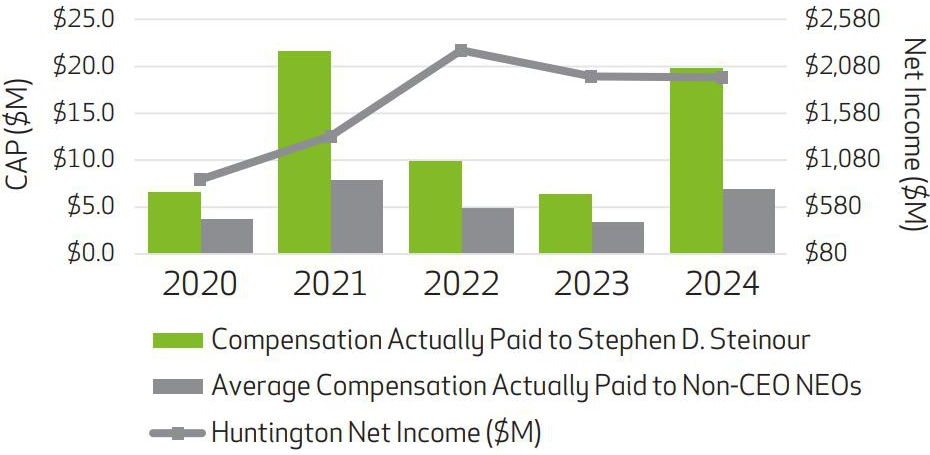
CAP versus Adjusted ROTCE*
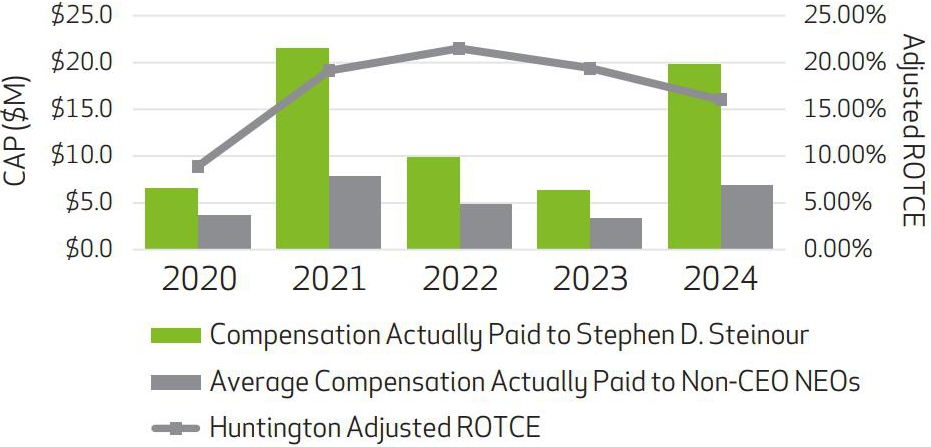
| * | Non- GAAP, see Appendix A to this proxy statement for more information |
| 106 | Huntington Bancshares Incorporated 2025 Proxy Statement | |
|
Compensation of Executive Officers Pay Ratio Disclosure |
 |
Pay Ratio Disclosure
We are providing this disclosure pursuant to a rule adopted by the SEC implementing a mandate of the Dodd-Frank Act. The rule requires disclosure of the annual total compensation of the median employee, excluding the CEO, the annual total compensation of the CEO, and the ratio of these amounts. For purposes of this disclosure, annual total compensation for both the median employee and the CEO is determined in accordance with the definition of annual total compensation as disclosed in the Summary Compensation Table.
In accordance with the rule, we used the same median employee for 2024 that we identified as of December 31, 2023. The median employee for 2024 was determined from among the Company’s employees (excluding the CEO) using a consistently applied compensation measure. The consistently applied compensation measure was 2023 W-2 Box 1 data as reflected in the Company’s payroll records for each employee (full-time, part-time, seasonal, or temporary, and on long-term leave, but excluding the CEO) employed as of December 31, 2023. The median employee serves as a Senior Fraud Investigator.
The median employee’s annual total compensation for 2024 was determined for purposes of this disclosure. This ratio is a reasonable estimate calculated in a manner consistent with SEC Regulation S-K Item 402(u).
| Median Employee Annual Total Compensation | $ | 73,567 | |
| CEO Annual Total Compensation | $ | 10,025,663 | |
| Ratio | 136:1 |
| Huntington Bancshares Incorporated 2025 Proxy Statement | 107 | |
 |
Audit Matters
| Proposal 3 | Ratification of the Appointment of Independent Registered Public Accounting Firm | ||
|
Following assessment of the qualifications, performance, and independence of PwC, our current auditors, the Audit Committee has again selected PwC to serve as our independent registered public accounting firm for 2025. We are asking shareholders to ratify the appointment of PwC because we value our shareholders’ views on the Company’s independent registered public accounting firm selection and as a matter of good corporate governance. The Audit Committee is directly responsible for the appointment, compensation, retention, and oversight of the independent registered public accounting firm. The Audit Committee regularly evaluates the qualifications, performance, and independence of the independent registered public accounting firm, and whether the firm should be rotated. PwC has served as our independent registered public accounting firm since 2015. The Audit Committee and the Board believe that the continued retention of PwC to serve as our independent registered public accounting firm is in the best interests of the Company and its shareholders. The Audit Committee will reconsider the appointment of PwC if its selection is not ratified by the shareholders. The Audit Committee may also reconsider the appointment of PwC at any time even if the selection is ratified by shareholders. |
 |
The Board recommends a vote FOR the ratification of the appointment of PwC. | |
| 108 | Huntington Bancshares Incorporated 2025 Proxy Statement | |
| Audit Matters |  |
Audit Fees, Audit-Related Fees, Tax Fees, and All Other Fees
The table below reflects the aggregate fees and out-of-pocket expenses billed by PwC for services rendered for us for 2024 and 2023.
| Year ended | ||||||
| Fees Billed by PwC | December 31, 2024 |
December 31, 2023 |
||||
| Audit Fees(1) | $ | 10,161,598 | $ | 9,251,060 | ||
| Audit-Related Fees(2) | 1,189,200 | 1,064,100 | ||||
| Tax Fees(3) | 2,557,390 | 2,931,496 | ||||
| All Other Fees(4) | 2,150 | 968 | ||||
| Total | $ | 13,910,338 | $ | 13,247,624 | ||
| (1) | Audit fees are fees for professional services rendered for the integrated audits of our annual consolidated financial statements, including the audit of the effectiveness of our internal control over financial reporting, quarterly reviews of the condensed consolidated financial statements included in Form 10-Q filings, and services that are normally provided by PwC in connection with statutory/subsidiary financial statement audits, attestation reports required by statute or regulation, and comfort letters and consents related to SEC filings. |
| (2) | Audit-related fees generally include fees for assurance and related services that are traditionally performed by the independent registered public accounting firm. These services include attestation and agreed-upon procedures that address accounting, reporting, and control matters that are not required by statute or regulation; pension plan audits; and service organization control examinations. These services are normally provided in connection with the recurring audit engagement. |
| (3) | The tax-related services were all in the nature of tax compliance, tax consulting, and tax planning. For 2024, the entire amount represents fees for tax compliance services; and for 2023, $2,631,496 represents fees for tax compliance services and $300,000 represents tax consulting and tax planning services. |
| (4) | All other fees were generally for accounting disclosure software licensing. |
Pre-Approval Policies and Procedures
The Audit Committee is responsible for the audit fee negotiations associated with the retention of the independent registered public accounting firm. The Audit Committee has a policy that it will pre-approve all audit and non-audit services provided by the independent registered public accounting firm and will not engage the independent registered public accounting firm to perform any specific non-audit services prohibited by law or regulation. The Audit Committee has given general pre-approval for specified audit, audit-related, and tax services. The term of any general pre-approval is 12 months from the date of pre-approval unless the Audit Committee specifically provides for a different term. The Audit Committee will annually review the services for which general pre-approval is given. The Audit Committee may revise the list of general pre-approved services from time to time, based upon subsequent determinations. Unless a type of service to be provided by the independent registered public accounting firm has received general pre-approval, it will require specific pre-approval by the Audit Committee. Pre-approval fee levels for all services to be provided by the independent registered public accounting firm are established annually by the Audit Committee. Any proposed services exceeding these levels will require specific pre-approval by the Audit Committee.
The Audit Committee may delegate pre-approval authority to a member of its Committee; the Audit Committee has delegated pre-approval authority to its Chair. The decisions of the Chair or other member to whom pre-approval authority is delegated must be presented to the full Audit Committee at its next scheduled meeting. The Audit Committee does not delegate its responsibilities to pre-approve services performed by the independent registered public accounting firm to management.
All the services covered by the fees disclosed above were pre-approved by the Audit Committee or its Chair. Further, the Audit Committee has considered and determined that the services described above are compatible with maintaining the independent registered public accounting firm’s independence.
| Huntington Bancshares Incorporated 2025 Proxy Statement | 109 | |
 |
Audit Matters Report of the Audit Committee |
Oversight of the Independent Auditor
The Audit Committee is responsible for the appointment, compensation, retention, and oversight of the independent registered public accounting firm. This also includes an evaluation of whether rotating independent registered public accounting firms is warranted. Additionally, the Audit Committee reviews the experience and qualifications of the lead audit partner and other senior members of the audit team. In its most recent review of PwC, the Audit Committee considered several factors, including:
 |
The qualifications of the audit team and the quality of work provided by PwC; |
 |
PwC’s independence and objectivity, including a consideration of the non-audit fees and services; |
 |
Appropriateness of PwC’s audit and non-audit fees; |
 |
Assessment of performance of the lead audit partner and audit team; |
 |
Tenure of the auditor; and |
 |
The impact of changing auditors. |
After considering the above factors, the Audit Committee has determined that retention of PwC at this time is in the best interests of the Company and its shareholders.
PwC Attendance at the Annual Meeting
Representatives of PwC regularly attend meetings of the Audit Committee and will be present at the 2025 Annual Meeting. These representatives will have an opportunity at the annual meeting to make a statement if they so desire and will also be available to respond to appropriate shareholder questions.
Report of the Audit Committee
The primary responsibility of the Audit Committee, which is comprised entirely of independent Directors, is to oversee the integrity of Huntington’s consolidated financial statements. In carrying out its duties, the Audit Committee has reviewed and discussed the audited consolidated financial statements for the year ended December 31, 2024, with Huntington management and with Huntington’s independent registered public accounting firm, PwC. This discussion included the selection, application, and disclosure of critical accounting policies, as well as the independent registered public accounting firm’s views on fraud risks and how it demonstrates its independence and skepticism. The Audit Committee has also reviewed and discussed with PwC its judgment as to the quality, not just the acceptability, of Huntington’s accounting principles and such other matters required to be discussed under auditing standards generally accepted in the United States, including the applicable requirements of the PCAOB and the SEC.
The Audit Committee has received and reviewed the written disclosures and the letter from PwC required by the applicable requirements of the PCAOB regarding PwC’s communications with the Audit Committee concerning independence and has discussed with PwC its independence from Huntington. Based on this review and discussion, and a review of the services provided by PwC during 2024, the Audit Committee believes that the services provided by PwC in 2024 are compatible with, and do not impair, PwC’s independence.
Based on these reviews and discussions, the Audit Committee recommended to the Board that the audited consolidated financial statements be included in Huntington’s Annual Report on Form 10-K for the year ended December 31, 2024, which was filed with the SEC on February 14, 2025.
Submitted by the Audit Committee
 |
 |
 |
 |
|||
| Richard W. Neu, Chair | Ann B. (Tanny) Crane | Gina D. France | Jeffrey L. Tate |
| 110 | Huntington Bancshares Incorporated 2025 Proxy Statement | |
|
|
 |
Ownership of Voting Stock
| Ownership of Voting Stock |
This section provides shareholders with an understanding of the ownership of our Directors, nominees for Director, executive officers, and largest shareholders. We believe that shareholders’ interests are better served when our Directors, nominees for Director, and executive officers hold a meaningful number of shares of the Company. Holding such shares more closely aligns the interests of these individuals with those of our shareholders. |
Security Ownership of Directors and Executive Officers
The table below sets forth the beneficial ownership of Huntington common stock by each of our Directors, nominees for Director, Named Executive Officers, and the Directors and all executive officers as a group. Beneficial ownership is determined in accordance with the rules of the SEC. Generally, the rules attribute beneficial ownership of securities to persons who possess sole or shared voting power and/or investment power with respect to those securities, including shares that could be acquired within 60 days. Ownership reported is as of February 18, 2025. The table also sets forth additional share interests not reportable as beneficially owned.
| Beneficial Ownership | ||||||||
| Name of Beneficial Owner |
Shares
of Common Stock Beneficially Owned(1)(2)(3)(4) |
Percent of Class |
Additional
Share Interests(5)(6) |
Total Share Interests |
||||
| Alanna Y. Cotton | 27,248 | * | 69,537 | 96,785 | ||||
| Ann B. (Tanny) Crane | 126,928 | * | 168,140 | 295,069 | ||||
| Rafael Andres-Diaz Granados | 18,168 | * | 23,064 | 41,232 | ||||
| Gina D. France | 81,482 | * | 101,519 | 183,001 | ||||
| Marcy C. Hingst | 69,612 | * | — | 69,612 | ||||
| J. Michael Hochschwender | 147,078 | * | 98,026 | 245,104 | ||||
| John C. (Chris) Inglis | 47,450 | * | 23,065 | 70,515 | ||||
| Richard H. King | 73,980 | * | 40,430 | 114,411 | ||||
| Scott D. Kleinman | 426,548 | * | — | 426,548 | ||||
| Katherine M. A. (Allie) Kline | 4,789 | * | 76,967 | 81,756 | ||||
| Richard W. Neu | 351,638 | * | 198,735 | 550,373 | ||||
| Kenneth J. Phelan | 87,437 | * | 81,144 | 168,581 | ||||
| David L. Porteous | 674,189 | * | 184,771 | 858,960 | ||||
| Teresa H. Shea | 2,923 | * | 10,400 | 13,323 | ||||
| Roger J. Sit | 353,647 | * | 40,430 | 394,078 | ||||
| Brant J. Standridge | 195,040 | * | — | 195,040 | ||||
| Stephen D. Steinour | 7,559,727 | * | 3,381,521 | 10,941,248 | ||||
| Jeffrey L. Tate | 66,410 | * | 40,430 | 106,840 | ||||
| Gary H. Torgow | 934,929 | * | — | 934,929 | ||||
| Zachary J. Wasserman | 262,015 | * | — | 262,015 | ||||
| Directors and All Executive Officers as a Group (28 in the group) | 12,946,715 | * | 4,866,962 | 17,813,676 | ||||
| * | Indicates less than 1% of outstanding shares. |
| (1) | This column consists of shares for which the Directors and executives, directly or indirectly, have the power to vote or to dispose, or to direct the voting or disposition thereof, and also includes shares for which the person has the right to acquire beneficial ownership within 60 days from February 18, 2025. Except as otherwise noted, none of the named individuals shares with another person either voting or investment power as to the shares reported. None of the shares reported are pledged as security. |
| Huntington Bancshares Incorporated 2025 Proxy Statement | 111 | |
 |
Ownership of Voting Stock Security Ownership of Certain Beneficial Owners |
| (2) | Figures for the executive officers include the number of shares of common stock that could have been acquired within 60 days of February 18, 2025, by the exercise of stock options and the vesting of time-based RSUs awarded under our employee and director equity plans as set forth below. |
| RSUs | Options | ||||
| Stephen D. Steinour | 138,172 | 3,025,346 | |||
| Zachary J. Wasserman | 54,930 | 206,584 | |||
| Brant J. Standridge | 127,528 | — | |||
| Scott D. Kleinman | 49,914 | 184,125 | |||
| Marcy C. Hingst | 14,782 | --- | |||
| Directors and Executive Officers as a Group (28 in the group) | 478,193 | 4,307,635 |
| (3) | Figures include 516 shares, 70,000 shares, 10,137 shares, 27,634 shares, 3,489,022 shares, and 5,675 shares, owned by the immediate family members or trusts of Mr. Hochschwender, Mr. Neu, Mr. Porteous, Mr. Sit, Mr. Steinour, and Mr. Torgow, respectively; 11,076 shares held jointly by Ms. Crane and her spouse; 463,945 shares owned jointly by Mr. Porteous and his spouse; and 152,572 shares held indirectly by Mr. Sit through Sit Investment Associates. |
| (4) | Figures include the following shares of common stock held as of February 18, 2025, in Huntington’s deferred compensation plans for Directors, including a legacy FirstMerit Corporation plan: 27,248 shares for Ms. Cotton, 87,471 shares for Ms. Crane, 17,968 shares for Mr. Diaz-Granados, 36,739 shares for Ms. France, 78,036 shares for Mr. Hochschwender, 12,105 for Mr. Inglis, 2,397 shares for Mr. King, 4,789 shares for Ms. Kline, 236,638 shares for Mr. Neu, 47,437 shares for Mr. Phelan, 115,550 shares for Mr. Porteous, 1,923 shares for Ms. Shea, 34,828 shares for Mr. Sit, and 4,921 shares for Mr. Tate. Figures also include the following shares of common stock held as of February 18, 2025, in certain of Huntington’s deferred compensation plans for colleagues, which include the 401(k) Plan, the Huntington Supplemental Plan, and the TCF Supplemental Plan: 346 shares for Mr. Kleinman, 143,411 shares for Mr. Steinour, and 176,858 shares for all executive officers as a group. |
| (5) | Figures in this column for Mr. Steinour and all executive officers as a group are shares held in the EDCP, for which the executive officers have vested ownership interests but do not have the power to vote or dispose of the shares, or the right to acquire such shares within 60 days. Prior to the distribution of shares from this plan to the participants, voting for the shares allocated to the accounts of participants is directed by the Company. |
| (6) | Figures in this column for the Directors consist of the vested deferred stock units granted to the Directors. These deferred stock units will be settled in shares of common stock six months following separation from service or one year from the date of grant, whichever is later. |
Security Ownership of Certain Beneficial Owners
As of December 31, 2024, we knew of no person who was the beneficial owner of more than 5% of our outstanding shares of common stock, except as follows:
| Name and Address of Beneficial Owner |
Shares
of Common Stock Beneficially Owned |
Percent of Class | ||
|
The
Vanguard Group, Inc.(1) 100 Vanguard Boulevard Malvern, PA 19355 |
171,788,581 | 11.86% | ||
|
BlackRock,
Inc.(2) 50 Hudson Yards New York, NY 10001 |
132,184,342 | 9.1% | ||
|
T.
Rowe Price Associates, Inc.(3) 100 E. Pratt Street Baltimore, MD 21202 |
100,257,791 | 6.9% | ||
|
State
Street Corporation(4) State Street Financial Center 1 Congress Street, Suite 1 Boston, MA 02114 |
82,092,547 | 5.67% |
| (1) | This information is based on a Schedule 13-G/A filed by The Vanguard Group, Inc. on February 13, 2024. The Vanguard Group, Inc. has shared voting power for 1,873,274 of the shares, sole dispositive power for 165,354,901 of the shares, and shared dispositive power for 6,433,680 of the shares. These shares were acquired and are held by The Vanguard Group, Inc. in the ordinary course of business. |
| (2) | This information is based on an amendment to Schedule 13-G/A filed by BlackRock, Inc. on January 24, 2024. BlackRock, Inc. has sole voting power for 121,186,326 of the shares and sole dispositive power for all the shares. These shares were acquired and are held by BlackRock, Inc. in the ordinary course of business. |
| (3) | This information is based on a Schedule 13-G filed by T. Rowe Price Associates, Inc. on November 14, 2024. T. Rowe Price Associates, Inc. has sole voting power for 95,073,681 of the shares and sole dispositive power for 100,338,396 of the shares. These shares were acquired and are held by T. Rowe Price Associates, Inc. in the ordinary course of business. |
| (4) | This information is based on a Schedule 13-G/A filed by State Street Corporation on January 29, 2024. State Street Corporation has shared voting power for 9,088,754 of the shares and shared dispositive power for 81,997,246 of the shares. These shares were acquired and are held by State Street Corporation in the ordinary course of business. |
| 112 | Huntington Bancshares Incorporated 2025 Proxy Statement | |
|
Ownership of Voting Stock Delinquent Section 16(a) Reports |
 |
Delinquent Section 16(a) Reports
Section 16(a) of the Exchange Act requires our directors, officers, and persons who own more than 10% of our common stock to file reports of ownership and changes in ownership of our common stock with the SEC. Based on the information available to us during the fiscal year ended December 31, 2024, we believe that all applicable Section 16(a) reports were timely filed, except for one Form 4 for each of Marcy Hingst and Donnell White, each reporting a forfeiture of shares to cover tax withholding upon vesting of RSUs, which were filed late due to an administrative error.
| Huntington Bancshares Incorporated 2025 Proxy Statement | 113 | |
 |
General Information on Voting and the Annual Meeting
|
General
Information on Voting and the Annual Meeting |
This section provides shareholders with information on how to participate in and vote at the 2025 Annual Meeting, as well as on other topics. We are providing this Proxy Statement in connection with the solicitation by the Board of Huntington Bancshares Incorporated, a Maryland corporation, of proxies to be voted at our 2025 Annual Meeting of Shareholders to be held on April 16, 2025, and at any adjournment. We are sending or making this Proxy Statement available to our shareholders on or about March 6, 2025. |
General Information About the Meeting
Voting Procedures
Holders of common stock at the close of business on the Record Date are entitled to vote at the Annual Meeting. As of that date, there were 1,460,753,955 shares of common stock outstanding and entitled to vote. Holders of any series of our preferred stock are not entitled to vote.
Each holder of common stock is entitled to cast one vote (i) for each Director nominee and (ii) on each other matter submitted at the Annual Meeting, and any postponements or adjournments thereof, for each share of stock held of record at the close of business on the Record Date. The shares represented by a properly executed and submitted proxy will be voted as directed, provided we receive the proxy prior to or at the meeting. A properly executed proxy without specific voting instructions will be voted FOR each nominee listed under Proposal 1 — Election of Directors, FOR Proposal 2 — Advisory Approval of Executive Compensation, and FOR Proposal 3 — Ratification of the Appointment of Independent Registered Public Accounting Firm. A properly executed and submitted proxy will also confer discretionary authority to vote on any other matter that may properly come before the meeting or any postponements or adjournments of the meeting and to otherwise represent the shareholder at the annual meeting with all powers he, she, or it would possess if personally present at the meeting.
We are not currently aware of any matters that may properly be presented other than those described in this Proxy Statement. If any matters not described in the Proxy Statement are properly presented at the meeting, the proxies may vote in their discretion on such matters. If the meeting is adjourned, the proxies can vote your common stock at the adjournment as well, unless you have revoked your proxy instructions.
You may vote by executing and returning your proxy card in the envelope provided, or by voting electronically over the internet or by telephone. Please refer to the proxy card for information on voting electronically. If you plan to attend the virtual meeting, while we encourage you to vote in advance of the meeting, you may vote during the virtual meeting at meetnow.global/MSSNHFG.
Shareholders who hold their shares in street name should refer to the voting instructions provided by their Broker.
We encourage shareholders to vote their shares over the internet or by telephone. Shareholders should also consider enrolling in electronic delivery of proxy materials. In addition to reducing our expenses, these actions help us reduce our paper usage and emissions from transportation.
If you are a colleague of Huntington or its affiliated entities and are receiving this Proxy Statement as a result of your participation in the 401(k) Plan, you must provide voting instructions to the plan trustee. A proxy and instruction card have been provided so that you may instruct the trustees how to vote your shares held under these plans.
| 114 | Huntington Bancshares Incorporated 2025 Proxy Statement | |
|
General Information on Voting and the Annual Meeting General Information About the Meeting |
 |
Revoking Your Proxy
If your common stock is held in street name, you must follow the instructions of your Broker to revoke your voting instructions. If you are a holder of record and wish to revoke your proxy instructions, you must advise our Secretary in writing before the proxies vote your common stock at the meeting; deliver later dated proxy instructions that are received prior to the meeting; or attend and vote your shares at the meeting.
Expenses of Solicitation
We will pay the expenses of this proxy solicitation, including the reasonable charges and expenses of Brokers for forwarding solicitation material to their customers who are beneficial owners. In addition to soliciting proxies by mail and via the internet, Huntington colleagues, without additional compensation, may also solicit proxies by telephone, email, facsimile, letter, or in person. We have retained Sodali & Co, 333 Ludlow Street, 5th Floor, South Tower, Stamford, CT 06902, to assist in the solicitation of proxies for a fee of $10,000 plus reimbursement of expenses.
Vote Required and Broker Voting
A quorum is required to conduct business at the annual meeting. Shareholders entitled to cast a majority of all the votes entitled to be cast at the annual meeting, present in person or by proxy, will constitute a quorum. The following table provides the vote requirement for each of this year’s proposals:
| Proposal | Voting Options | Effect of Abstentions
and Broker Non-Votes |
Vote Required for Approval | |||
| Proposal 1: Election of Directors | FOR, AGAINST, or ABSTAIN for each Director nominee | Abstentions and Broker non-votes have no effect | The number of votes cast “for” each nominee’s election must exceed the total number of votes cast “against” such nominee’s election.* | |||
| Proposal 2: Advisory Approval of Executive Compensation | FOR, AGAINST, or ABSTAIN | Abstentions and Broker non-votes have no effect | A majority of all votes cast must be “for” this proposal. | |||
| Proposal 3: Ratification of the Appointment of Independent Registered Public Accounting Firm | FOR, AGAINST, or ABSTAIN | Abstentions have no effect | A majority of all votes cast must be “for” this proposal. |
| * | The vote of a majority of the total of votes cast for and against a nominee at a meeting at which a quorum is present is necessary for the election of a Director. Provided, however, that if, on either the date of the Company’s proxy statement for the meeting or on the date of the meeting, the number of nominees exceeds the number of Directors to be elected, the Directors shall be elected by a plurality of all the votes cast at the meeting. In the event of plurality voting, shareholders would be given the option to vote “for” or affirmatively withhold votes from nominees. In such case, the Director nominees receiving the highest number of affirmative “for” votes will be elected Directors and “withhold” votes will have no effect. |
Under the laws of Maryland, our state of incorporation, abstentions and Broker non-votes are counted for purposes of determining the presence or absence of a quorum but are not counted as votes cast at the meeting. Broker non-votes occur when Brokers, who hold their customers’ shares in street name, submit proxies for such shares on some matters, but not others. Generally, this would occur when Brokers have not received any instructions from their customers. In these cases, the Brokers, as the holders of record, are permitted to vote on “routine” matters, which typically include the ratification of the independent registered public accounting firm, but not on non-routine matters. Brokers are not permitted to vote on the election of Directors or matters related to executive compensation without instructions from their customers. Broker non-votes and abstentions will have no effect on the election of any Director or the advisory approval of executive compensation because they are not counted as votes cast at the meeting.
| Huntington Bancshares Incorporated 2025 Proxy Statement | 115 | |
 |
General Information on Voting and the Annual Meeting General Information About the Meeting |
Attending the Virtual Annual Meeting
You may access the annual meeting live via the internet at meetnow.global/MSSNHFG at the meeting date and time, where Huntington shareholders as of the Record Date will be able to listen to the meeting, submit questions, and vote online.
You are entitled to attend the annual meeting via the meeting website if you were a shareholder of record at the close of business on the Record Date; you held your shares beneficially in the name of a Broker as of the Record Date; or you hold a valid proxy for the annual meeting. If you were a shareholder of record at the close of business on the Record Date, you will be able to attend the annual meeting online, submit a question, and vote by visiting the annual meeting website and following the instructions on your proxy card, along with the procedures set forth below.
We expect that the vast majority of beneficial holders will be able to fully participate at our annual meeting, including the ability to submit questions and/or vote at the meeting, using the control number received with their voting instruction form or proxy card. Please note, however, that there is no guarantee this option will be available for every type of beneficial holder voting control number, and we encourage you to follow the procedures described below to ensure access to the meeting. The inability to provide this option to any or all beneficial holders shall in no way impact the validity of the annual meeting.
Beneficial holders who wish to submit questions and/or vote at the annual meeting are encouraged to visit the meeting website as soon as possible to determine whether the control number on their voting instruction form or proxy card will permit access. If your control number does not permit access or you prefer to register in advance of the annual meeting, you must obtain a signed legal proxy from your Broker giving you the right to vote the shares and submit proof of such legal proxy along with your name and email address to legalproxy@computershare.com or Computershare, Huntington Legal Proxy, P.O. Box 43078, Providence, RI 029040-3078, no later than April 11, 2025, at 5:00 p.m., Eastern Time. You will receive a confirmation of your registration by email with instructions for accessing the Huntington annual meeting website.
Guests will also be permitted to attend the virtual annual meeting, but are not permitted to submit questions or vote. Technical assistance will be available for shareholders who experience an issue accessing the annual meeting. Contact information for technical support will appear on the annual meeting website prior to the start of the annual meeting.
Shareholders of Record
A holder of common stock may vote by proxy or at the annual meeting. If you hold your shares of common stock in your name as a holder of record, you may use one of the following methods to submit a proxy:
 |
By telephone: by calling the toll-free number indicated on the accompanying proxy card and following the recorded instructions. |
 |
Through the internet: by visiting the website indicated on the accompanying proxy card and following the instructions. |
 |
By completing and returning the accompanying proxy card in the enclosed postage-paid envelope: the envelope requires no additional postage if mailed within the United States. If you intend to submit your proxy by mail, your completed proxy card must be received prior to the annual meeting. |
We request that you vote as soon as possible so that we can be assured of a quorum.
Shares Held in Street Name
If your shares are held in street name through a Broker, you must instruct the Broker on how to vote your shares. Shareholders should refer to the voting instructions provided by their Broker to direct the voting of their shares in advance of the meeting. You may not vote your shares held in a brokerage or other account in street name by returning a proxy card directly to Huntington. Shareholders holding through a Broker who wish to vote at the annual meeting should also review the procedure previously set forth.
Submitting Questions for the Annual Meeting
Shareholders as of the Record Date may submit questions in advance of the meeting by visiting meetnow.global/MSSNHFG. Questions may also be submitted during the annual meeting via the annual meeting website. To ensure the annual meeting is conducted in a manner that is fair to all shareholders, we may exercise discretion in determining the number of questions each shareholder may submit, the order in which questions are answered, and the amount of time devoted to any one question.
We intend to answer questions pertinent to Company matters as time allows during the meeting. Questions that are substantially similar may be grouped and answered once to avoid repetition. Shareholder questions related to personal or customer matters; that are not pertinent to annual meeting matters; or that contain derogatory references to individuals, use offensive language, or are otherwise out of order or not suitable for the conduct of the annual meeting will not be addressed during the meeting.
| 116 | Huntington Bancshares Incorporated 2025 Proxy Statement | |
|
General Information on Voting and the Annual Meeting Proposals by Shareholders for the 2026 Annual Meeting |
 |
Proposals by Shareholders for the 2026 Annual Meeting
Shareholders wishing to submit a proposal, including nominations for directorship or items of business as part of next year’s annual meeting, should review the following table, which summarizes the process. The following table is qualified in its entirety by reference to SEC Rules 14a-8 and 14a-19 and our Bylaws.
|
Proposals
Submitted for Inclusion in our 2026 Proxy Statement (i.e., SEC Rule/14a-8) |
Nominees
and Other Proposals Outside SEC Rule 14a-8 to be Presented at the 2026 Annual Meeting (i.e., advance notice) |
|||
| Type of Proposal | SEC rules permit shareholders to submit proposals to us for inclusion in our proxy statement by satisfying the requirements set forth in SEC Rule 14a-8. | Pursuant to the Company’s Bylaws, shareholders may present nominees or proposals directly at the annual meeting (and not for inclusion in the Company’s proxy statement) by satisfying the requirements set forth in our Bylaws. | ||
| When We Must Receive the Proposal* | Under SEC Rule 14a-8, the proposal typically must be received not less than 120 calendar days before the first anniversary of the date of the proxy statement released to shareholders for the prior year’s annual meeting. This means, for the 2026 Annual Meeting, no later than the close of business on November 6, 2025. | Pursuant to the Company’s Bylaws, nominations and other proposals outside SEC Rule 14a-8 typically must be received no earlier than the 150th day nor later than 5:00 p.m., Eastern Time, on the 120th day prior to the first anniversary of the date of the proxy statement for the prior year’s annual meeting. This means, for the 2026 Annual Meeting, such notice must be received between October 7, 2025, and November 6, 2025. | ||
| What to Include in the Proposal | The information necessary to be in compliance with SEC Rule 14a-8; however, submission of a proposal does not guarantee inclusion within our proxy statement. | The information set forth in the Company’s Bylaws. In addition to complying with the advance notice provisions of our Bylaws, shareholders who intend to solicit proxies in support of director nominees, other than the Company’s nominees, must also comply with the additional requirements of SEC Rule 14a-19. SEC Rule 14a-19 requires, among other things, that a shareholder provide notice that includes certain information, which notice must be received by the Company’s Secretary no later than February 16, 2026, which is 60 calendar days prior to the anniversary of this year’s meeting date. Among other things, Rule 14a-19 requires the shareholder to provide a statement that he, she, or it intends to solicit the holders of shares representing at least 67% of the voting power of the Company’s shares entitled to vote on the election of Directors in support of Director nominees other than the Company’s nominees. | ||
| Where to Send the Proposal | Huntington Bancshares Incorporated Huntington Center, 41 South High Street Columbus, Ohio 43287 Attention: Secretary |
|||
| * | Should the 2026 Annual Meeting be advanced or delayed more than 30 days from the first anniversary of the date of the 2025 Annual Meeting, then alternate deadlines apply. |
Recommendations for Directorship
Shareholders and other parties may also recommend candidates for directorship to be considered by the NESG Committee at any time outside our Bylaws. To do so, a written notice should be sent to the Secretary at Huntington Bancshares Incorporated, Huntington Center, 41 South High Street, Columbus, Ohio 43287. The notice should indicate the name, age, and address of the person recommended; the person’s principal occupation or employment for the last five years; other public company boards on which the person serves; whether the person would qualify as independent as the term is defined under the Nasdaq Rules; and the class and number of shares of Huntington securities owned by the person. The NESG Committee may require additional information to determine the qualifications of the person recommended. The notice should also state the name and address of, and the class and number of shares of Huntington securities owned by, the person or persons making the recommendation. Any such shareholder recommendation would be considered no differently than recommendations from any other source. There have been no material changes to the shareholder recommendation process since we last disclosed this item.
| Huntington Bancshares Incorporated 2025 Proxy Statement | 117 | |
 |
General Information on Voting and the Annual Meeting Other Matters |
Other Matters
Inspector of Election
We have engaged Computershare to count the shares represented by proxies and cast at the meeting online ballot and to act as Inspector of Election. A representative from Computershare will be present at the meeting.
Other Business
As of the date of this Proxy Statement, we know of no other business that may properly be brought before the meeting, or any postponements or adjournments thereof, other than procedural matters relating to the proposals described in the Notice of Annual Meeting and this Proxy Statement. Should any other matter requiring a vote of the shareholders arise, a properly submitted proxy confers upon the person or persons designated to vote the shares discretionary authority to vote the same with respect to any such other matter in the discretion of such persons and otherwise to represent the shareholder at the meeting with all powers he, she, or it would possess if personally present at the meeting.
Other Documents Available
Huntington’s 2024 Annual Report was furnished to shareholders concurrently with this Proxy Statement. Huntington’s Form 10-K for 2024 will be furnished, without charge, to Huntington shareholders upon written request to Investor Relations, Huntington Bancshares Incorporated, Huntington Center, 41 South High Street, Columbus, Ohio 43287. In addition, Huntington’s Form 10-K for 2024 and certain other reports filed with the SEC can be found on the Investor Relations pages of Huntington’s website at ir.huntington.com.
Householding
The SEC has adopted “householding” rules that permit companies and intermediaries, such as Brokers, to satisfy delivery requirements for proxy statements, notices of internet availability of proxy materials, and annual reports (collectively, “annual meeting materials”) with respect to two or more shareholders sharing the same address by delivering one copy of annual meeting materials to these shareholders. Unless we have received contrary instructions, we will deliver only one copy of the annual meeting materials to multiple security holders sharing an address.
If we sent only one set of these documents to your household and one or more of you would prefer to receive your own set, we will promptly deliver additional copies of the annual meeting materials upon request. You may contact our transfer agent, Computershare, to receive additional copies of the annual meeting materials. You may also contact Computershare if you would like to request separate copies of future annual meeting materials or if you are receiving multiple copies of annual meeting materials and you would like to request delivery of just one copy.
You may contact Computershare by telephone at 1-800-725-0674 or by mail at Computershare, P.O. Box 43078, Providence, RI 029040-3078. If you hold your shares in street name, please contact your Broker to request information about householding.
Service Mark, Trademark, and Copyright Information
 ®,
Huntington®,
®,
Huntington®,  Huntington®, and
Huntington®, and  Huntington. Welcome.® are federally registered service marks of Huntington Bancshares Incorporated. Third-party
product, service, and business names are trademarks and/or service marks of their respective owners.
Huntington. Welcome.® are federally registered service marks of Huntington Bancshares Incorporated. Third-party
product, service, and business names are trademarks and/or service marks of their respective owners.
© 2025 Huntington Bancshares Incorporated.
| 118 | Huntington Bancshares Incorporated 2025 Proxy Statement | |

Appendix A: Non-GAAP Reconciliation ’
|
Appendix A: Non-GAAP Reconciliation |
This section includes reconciliation for the non-GAAP numbers provided within this Proxy Statement. |
We believe certain non-GAAP financial measures, including adjusted return on average tangible common shareholders’ equity and pre-provision net revenue, to be helpful in understanding our results of operations. In addition, certain adjustments are made to GAAP financial measures, including adjusted earnings per share, adjusted operating leverage, and adjusted pretax pre-provision earnings, which are utilized by the HRCC that reflect adjustments approved by the HRCC. The tables below provide a reconciliation to the closest GAAP financial measure for the year ended December 31, 2024. Note that some amounts may not foot due to rounding.
Adjusted EPS
| ($ in millions except per share amounts) | Dollar Amount | EPS | |||||
| Net income applicable to Common Shares | $ | 1,801 | $ | 1.220 | |||
| Adjustments: | |||||||
| Org. Transformation/Severance Related Expenses and CRE Consolidation | 18 | ||||||
| FDIC Special Assessment expense | 28 | ||||||
| Securities Repositioning | 21 | ||||||
| Mezzanine Investment gains | (4 | ) | |||||
| Tax impact of adjustments | (13 | ) | |||||
| Adjusted Net Income applicable to Common Shares | $ | 1,851 | $ | 1.254 | |||
| Huntington Bancshares Incorporated 2025 Proxy Statement | 119 | |
 |
Appendix A: Non-GAAP Reconciliation Adjusted Operating Leverage |
Adjusted Operating Leverage
| ($ in millions) |
2024 Actual |
2023 Actual |
Y/Y Change | ||||||||||||
| Net Interest income | $ | 5,345 | $ | 5,439 | |||||||||||
| FTE Adjustment | 53 | 42 | |||||||||||||
| FTE net interest income | 5,398 | 5,481 | |||||||||||||
| Noninterest Income | 2,040 | 1,921 | |||||||||||||
| Less: Securities gains (loss) | (21 | ) | (7 | ) | |||||||||||
| Less: Mezzanine Investment gains | 4 | ||||||||||||||
| Less: net gain (loss) MSR Hedging | -- | (3 | ) | ||||||||||||
| Noninterest income, adjusted | 2,057 | 1,931 | |||||||||||||
| Adjusted total revenue (a) | 7,455 | 7,412 | $ | 43 | 0.58 | % | |||||||||
| Noninterest expense | 4,562 | 4,574 | |||||||||||||
| Less: Org. Transformation/Severance Related Expenses and CRE Consolidation | 18 | ||||||||||||||
| Less: FDIC Special Assessment | 28 | ||||||||||||||
| Less: Impact of Discretionary Bonus | 9 | ||||||||||||||
| Adjusted noninterest expense (b) | $ | 4,507 | $ | 4,574 | $ | (67 | ) | (1.46 | )% | ||||||
| Adjusted operating leverage | 2.04 | % | |||||||||||||
| 120 | Huntington Bancshares Incorporated 2025 Proxy Statement | |
|
Appendix A: Non-GAAP Reconciliation Adjusted ROTCE |
 |
Adjusted ROTCE
| ($ in millions) | 2024 | 2023 | 2022 | 2021 | 2020 | |||||||||||||||
| Average common shareholders’ equity | $ | 17,347 | $ | 16,217 | $ | 16,096 | $ | 14,569 | $ | 10,618 | ||||||||||
| Less: intangible assets and goodwill | 5,680 | 5,731 | 5,688 | 4,108 | 2,201 | |||||||||||||||
| Add: Net of tax effect of intangible assets | 26 | 35 | 47 | 48 | 44 | |||||||||||||||
| Average tangible common shareholders’ equity (A) | 11,693 | 10,521 | 10,455 | 10,509 | 8,462 | |||||||||||||||
| Net income available to common | 1,801 | 1,817 | 2,125 | 1,153 | 717 | |||||||||||||||
| Add: amortization of intangibles | 47 | 50 | 54 | 48 | 41 | |||||||||||||||
| Add: deferred tax | (10 | ) | (10 | ) | (12 | ) | (10 | ) | (9 | ) | ||||||||||
| Adjusted net income available to common (B) | $ | 1,838 | $ | 1,857 | $ | 2,167 | $ | 1,191 | $ | 749 | ||||||||||
| Return on average tangible common shareholders’ equity (B/A) | 15.7 | % | 17.6 | % | 20.7 | % | 11.3 | % | 8.9 | % | ||||||||||
| ($ in millions) | 2024 | 2023 | 2022 | 2021 | 2020 | |||||||||||||||
| Adjusted net income available to common (B) | $ | 1,838 | $ | 1,857 | $ | 2,167 | $ | 1,191 | $ | 749 | ||||||||||
| Return on average tangible shareholders’ equity (B/A) | 15.7 | % | 17.6 | % | 20.7 | % | 11.3 | % | 8.9 | % | ||||||||||
| Add: Notable items, after tax (C) | $ | 38 | $ | 181 | $ | 76 | $ | 813 | $ | — | ||||||||||
| Adjusted net income available to common (annualized) (D) | 1,876 | 2,038 | 2,243 | 2,004 | 749 | |||||||||||||||
| Adjusted return on average tangible common shareholders’ equity (D/A) | 16.0 | % | 19.4 | % | 21.5 | % | 19.1 | % | 8.9 | % | ||||||||||
| Huntington Bancshares Incorporated 2025 Proxy Statement | 121 | |
 |
Appendix A: Non-GAAP Reconciliation Pre-Provision Net Revenue (PPNR) |
Pre-Provision Net Revenue (PPNR)
| ($ in millions) | 2024 | 2023 | Y/Y Change | ||||||
| FTE net interest Income, adjusted | $ | 5,398 | $ | 5,481 | |||||
| Noninterest income | 2,040 | 1,921 | |||||||
| Less: gain (loss) from Securities Repositioning | (21 | ) | |||||||
| Less: Mezzanine Investment gains | 4 | ||||||||
| Adjusted Noninterest income | 2,057 | 1,921 | |||||||
| Adjusted total revenue (a) | $ | 7,455 | $ | 7,402 | |||||
| Noninterest expense | 4,562 | 4,574 | |||||||
| Less: Org. Transformation/Severance Related Expenses and CRE Consolidation | 18 | ||||||||
| Less: FDIC Special Assessment | 28 | ||||||||
| Less: Impact of Discretionary Bonus | 9 | ||||||||
| Adjusted Noninterest expense(b) | 4,507 | 4,574 | |||||||
| Pretax PPNR, adjusted (a-b) | $ | 2,948 | $ | 2,828 | 4.2% | ||||
| 122 | Huntington Bancshares Incorporated 2025 Proxy Statement | |

Glossary
| Acronym/Term | Definition | |
| 401(k) Plan | Huntington 401(k) Plan | |
| AI | Artificial Intelligence | |
| ADB | Average Daily Balance | |
| ASC | Accounting Standards Codification | |
| B2B | Business-to-Business | |
| Board | Board of Directors of Huntington Bancshares Incorporated | |
| Broker | Brokerage firms, banks, trustees, other nominees, or similar entities | |
| CAP | Compensation Actually Paid | |
| CD&A | Compensation Discussion and Analysis | |
| CEO | Chief Executive Officer | |
| CFPB | Bureau of Consumer Financial Protection | |
| CFO | Chief Financial Officer | |
| CHRO | Chief Human Resources Officer | |
| Code | Internal Revenue Code of 1986 | |
| Company | Huntington Bancshares Incorporated | |
| CRE | Commercial Real Estate | |
| CRO | Chief Risk Officer | |
| EDCP | Executive Deferred Compensation Plan | |
| EEO-1 | Equal Employment Opportunity Reporting Standard | |
| ELT | Executive Leadership Team | |
| EPS | Diluted Earnings Per Share | |
| ESG | Environmental, Social, and Governance | |
| Exchange Act | Securities Exchange Act of 1934, as amended | |
| FASB | Financial Accounting Standards Board | |
| FDIC | Federal Deposit Insurance Corporation | |
| Federal Reserve | The Board of Governors of the Federal Reserve System |
| Huntington Bancshares Incorporated 2025 Proxy Statement | 123 | |
 |
Glossary |
| Acronym/Term | Definition | |
| FTE | Fully-Taxable Equivalent | |
| FY | Fiscal Year | |
| FYE | Full Year End | |
| GAAP | Generally Accepted Accounting Principles in the United States | |
| GHG | Greenhouse Gas | |
| HRCC | Human Resources and Compensation Committee | |
| Huntington | Huntington Bancshares Incorporated | |
| Huntington Bank | The Huntington National Bank | |
| Huntington Supplemental Plan | Huntington Supplemental 401(k) Plan (formerly the Huntington Supplemental Stock Purchase and Tax Savings Plan and Trust), as amended | |
| IRS | Internal Revenue Service | |
| LTI | Long-Term Incentive | |
| Long-Term Incentive Plans | Amended and Restated 2018 Long-Term Incentive Plan and the 2024 Long-Term Incentive Plan | |
| M&A | Mergers & Acquisitions | |
| MIP | Management Incentive Plan or Annual Incentive Plan | |
| MSR | Mortgage Servicing Rights | |
| Nasdaq Rules | Marketplace Rules of The Nasdaq Stock Market | |
| NESG Committee | Nominating and ESG Committee | |
| NEO | Named Executive Officer | |
| OCC | Office of the Comptroller of the Currency | |
| Oversight Committee | Incentive Compensation Oversight Committee | |
| PAC | Political Action Committee | |
| PCAF | Partnership for Carbon Accounting Financials | |
| PCAOB | Public Company Accounting Oversight Board | |
| Pearl Meyer | Pearl Meyer & Partners, LLC | |
| PLQ | People Leader Quotient | |
| PPNR | Pre-Provision Net Revenue | |
| PSU | Performance Stock Unit | |
| PwC | PricewaterhouseCoopers LLP | |
| Record Date | February 18, 2025 | |
| Retirement Plan | Huntington Bancshares Retirement Plan | |
| ROTCE | Return on Average Tangible Common Shareholders’ Equity |
| 124 | Huntington Bancshares Incorporated 2025 Proxy Statement | |
|
Glossary |
 |
| Acronym/Term | Definition | |
| RSU | Restricted Stock Unit | |
| S&P | Standard and Poor | |
| SASB | Sustainability Accounting Standards Board | |
| SBA | U.S. Small Business Administration | |
| SEC | U.S. Securities and Exchange Commission | |
| SRIP | Supplemental Retirement Income Plan, as amended | |
| TCF | TCF Financial Corporation | |
| TCF Merger | Merger of TCF Financial Corporation into Huntington Bancshares Incorporated and TCF National Bank into The Huntington National Bank | |
| TCF Supplemental Plan | TCF 401K Supplemental Plan, as amended | |
| TSR | Total Shareholder Return | |
| UDAAP | Unfair, Deceptive, or Abusive Acts and Practices |
| Huntington Bancshares Incorporated 2025 Proxy Statement | 125 | |
